Ethica
(november 2025) Since its launch 2018, more than 82 500 people from 113 countries around the world have connected to the Ethica work without obstacle application and its website. Thank you very much!
Podcast France Culture Radio Ethica's presentation on France Culture radio digital reading podcast
EXHIBITION La construction du champ #1 : le chantier, 2021, Vitry-sur-Seine Presentation of the application Ethica work without obstacle and a set of Patrick Fontana's research on Spinoza's Ethics. Video on youtube
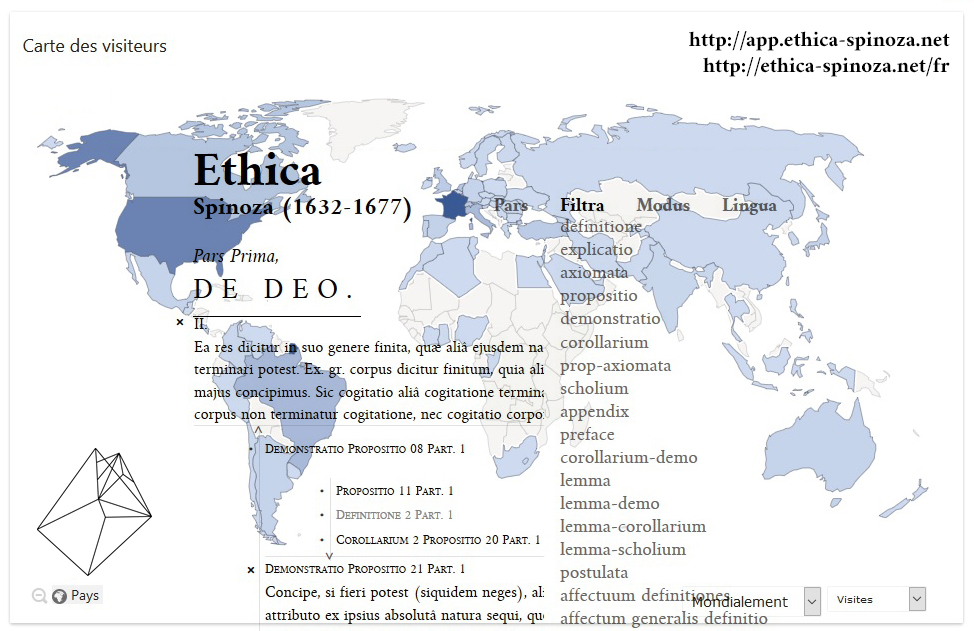
Ethica, work without obstacle, is a free internet application, a digital and augmented edition of the Ethics by Spinoza (1632-1677).
link to the application : app.ethica-spinoza.net
Published in Latin in 1677, the Ethics intends to demonstrate "in the manner of surveyors" not only the existence of God, the nature and the origin of the human mind, but still the way which leads "as by the hand" to salvation and bliss.
Thanks to an unprecedented visualization of the text, Ethica makes visible the demonstrative network of the work. The user can see and read freely the text, explore it in a innovative and intuitive way.
He can share his discoveries, his questions and thus participate building a global community of readers-interpreters.
Ethica is accessible to all, curious, specialists or lovers of Spinoza, philosophers, researchers, students.
The project Ethica, work without obstacle (2009-2018)
Written in the manner of Euclid’s Elements, the Ethics can be divided into 932 texts : definitions, axioms, postulates, propositions, demonstrations and corollaries, prefaces, scholia and appendices.
All these texts are connected to each other by references which allow various readings which anticipate the hypertext mode. The application is based on this demonstrative network.
The axes of the application
The text
Based on the structure offered by the demonstrative network, access to the text is done by indexing the different linear or transversal readings by direct and indirect links between the propositions.
Personnal use
Any user can trace his own paths in the Ethics, according to his interests and reading hypotheses. It has the opportunity to take notes, to memorize its courses and comments, to share them with the community of readers.
Video comments (no funding for its realisation)
More than 100 philosophers of 20 countries in South and North America, Russia, India, Japan, Europe have agreed to take part in the project.
From 5 selected texts, each philosopher proposes a course in the Ethics around a key concept. Implicitly they trace an original approach to Spinozist philosophy.
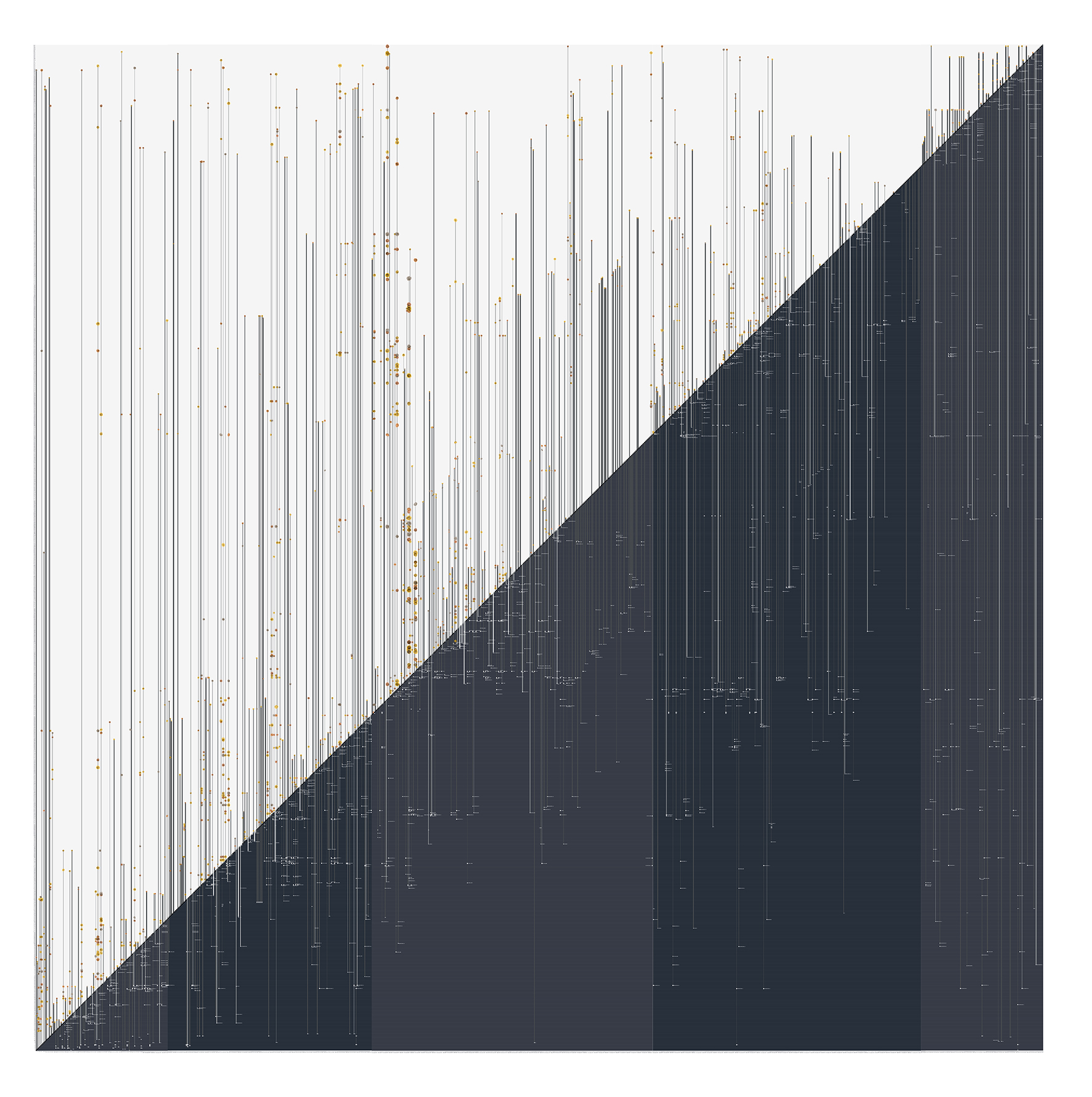
Research in progress for 2026
Bringing rigorous counterpoint to life
In music, counterpoint is a way of composing that superimposes several simultaneous melodic lines that are independent of each other. The assembly of the different wefts gives rise to distinct melodies, which are arranged within a united and coherent whole.
Our research has led us to bring the Rigorous counterpoint to life through a play of speeds between the trajectories of each text. We imagine the logical movement of the connections between them.
the development of a second version of Ethica with new tools and new translations.
An engraved catalog of the graphic identities of all the texts in Ethics, comprising 932 engravings.
This catalog will be connected to the digital application, which is a way for me to bridge the gap between graphic and digital arts.**
As Henri Atlan once wrote to me: "Take all the time you need. Spinoza is in a kind of eternity anyway.
We are looking for new partners to continue. If you are interested in these researchs, please contact Patrick Fontana by e-mail :
contact Patrick Fontana.**

The Ethics
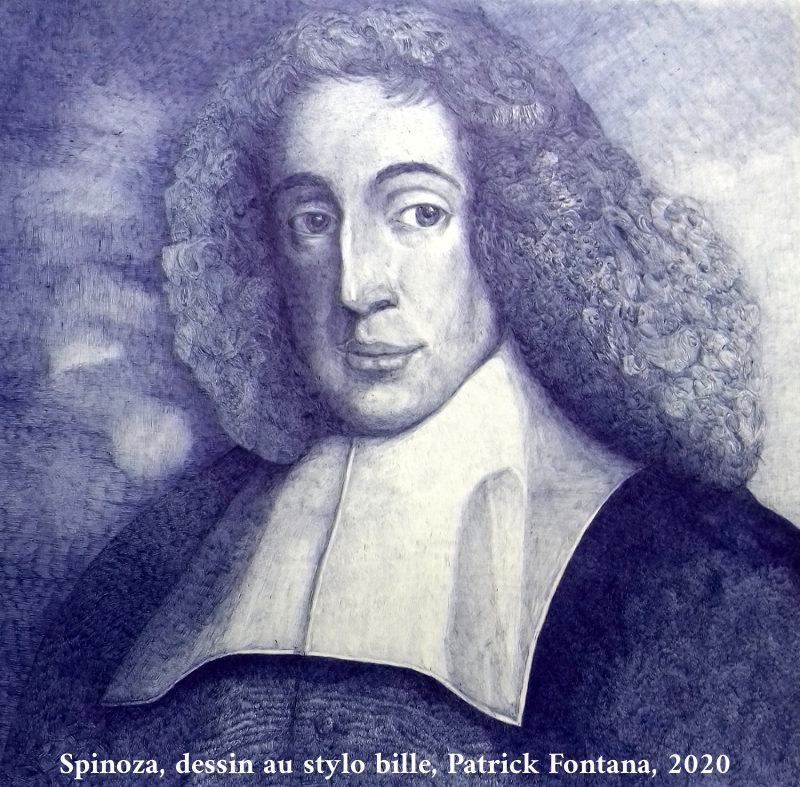
Baruch Spinoza (1632-1677) devoted a large part of his life to writing the Ethics. This book that leads the reader towards freedom, as stated in the title of the fifth and last part: "On the power of the understanding or the freedom of man". This long and rigorous journey consists in the acquisition of an increasingly clear knowledge, and the understanding of what hinders our freedom, that is what hinders and enslaves our thought as much as our body. This knowledge and understanding are in themselves to sets us free.
To be human is to express in one's own way the infinite power of nature. It is to be a certain and singular power of action. Our bodies and thoughts are no exception to the natural order. To either submit to the necessity of nature because we know nothing about it, or to succeed in knowing, at least in part, how our affects and our thoughts are linked together, such is the alternative faced by the readers of the Ethics and the path opened to freedom.
Nathalie Chouchan, Philosophy teacher. Chief editor of Cahiers philosophiques ( Vrin )

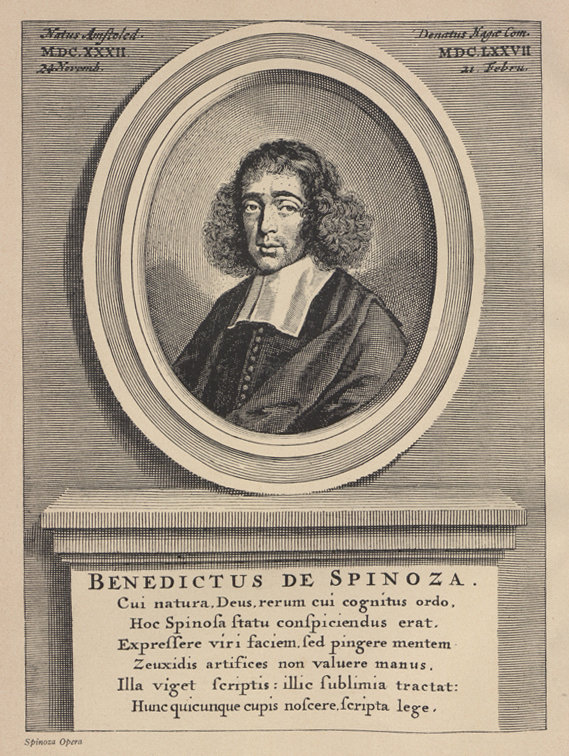
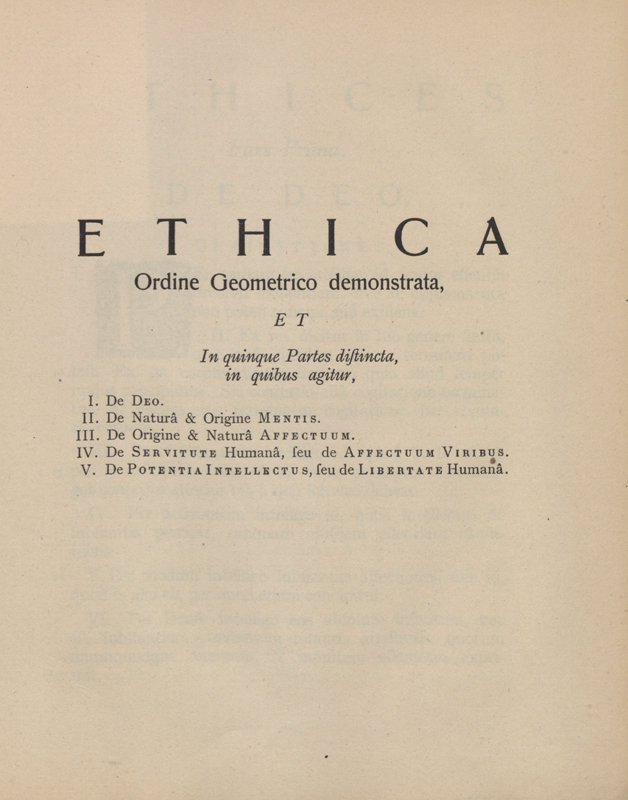
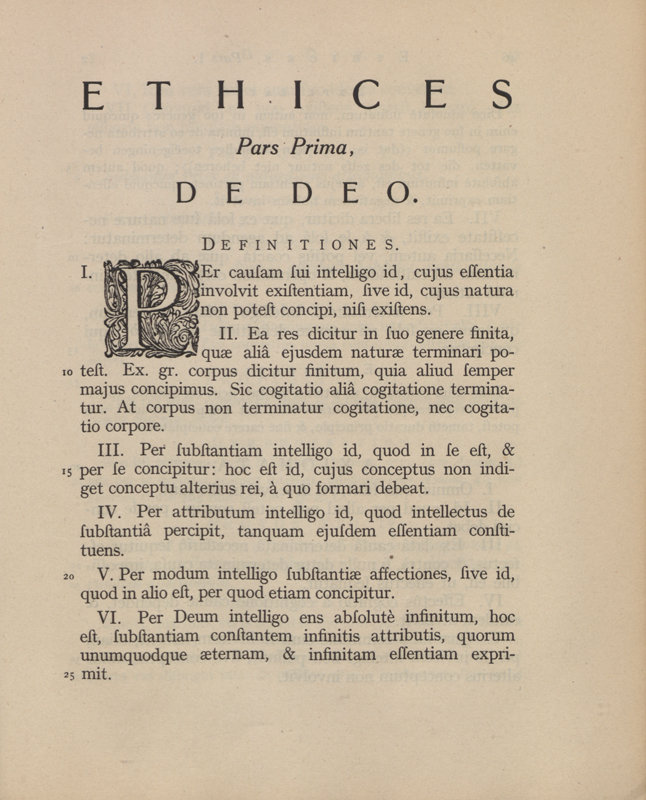
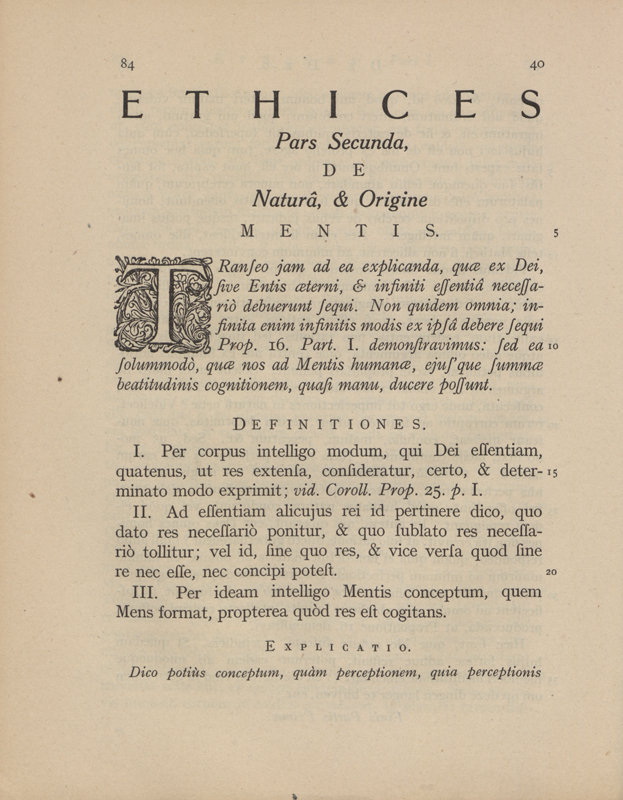
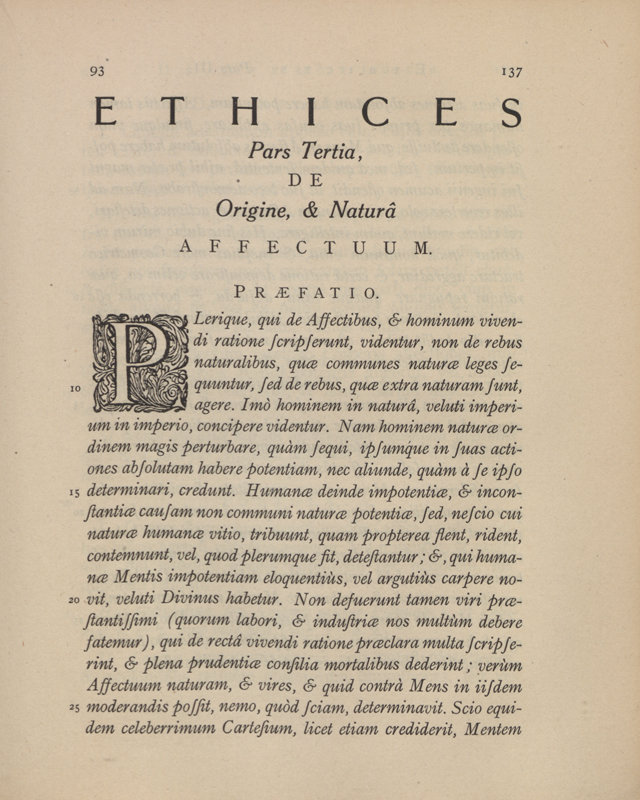
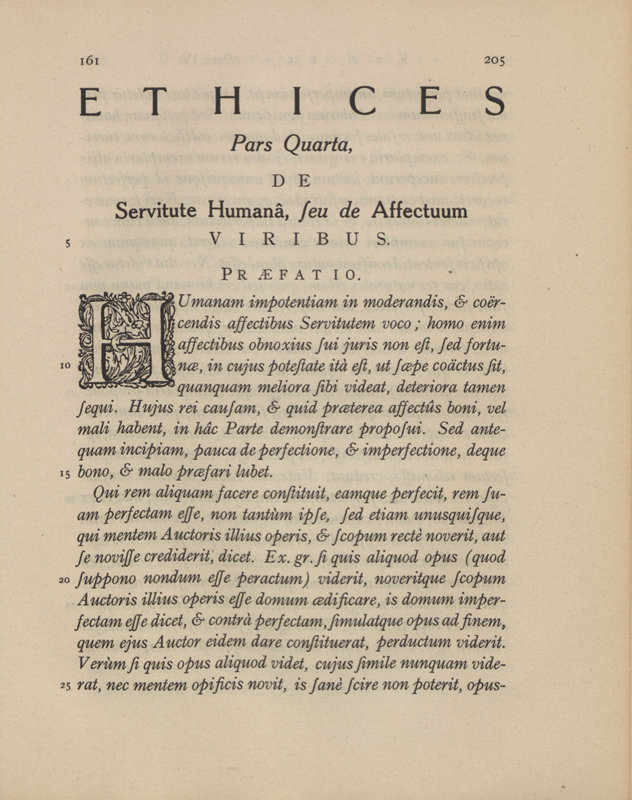
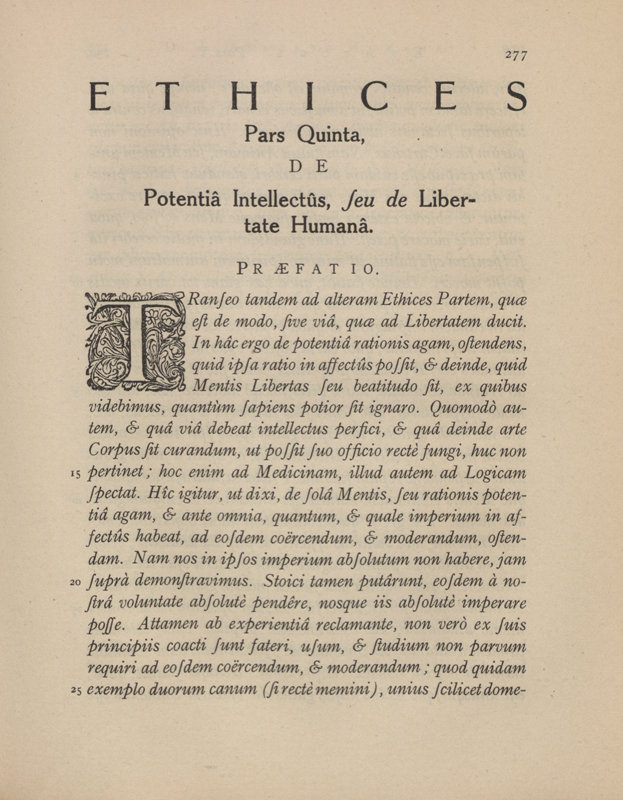
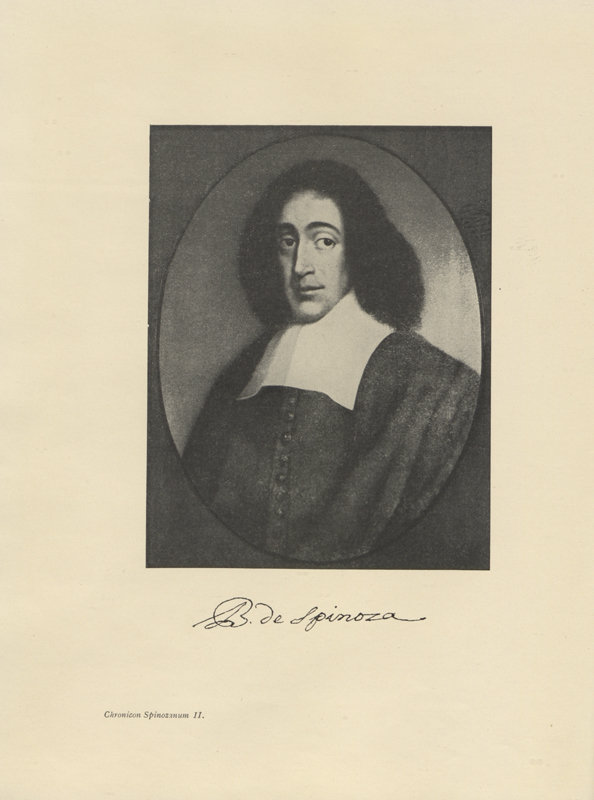
-
The Ethics and Digital Humanities
Ethica, work without obstacle, is part of the long history of the critical reception of the text, following the digital turn taken by the sciences of man and society.
It marks a new stage, after the appearance in the 1970s of the first lexicons (E. Giancotti-Boscherini, Lexicon spinozanum, La Haye, 1970), early registries and computer indexes (M. Guéret, A. Robinet, P. Tombeur, Spinoza. Ethica. Correspondances, index, listes des fréquences, tables comparatives, Louvain 1977 ; Spinoza, A Political Treatise, latin text, translation by P.-F. Moreau, computer index by P.-F. Moreau and Renée Bouveresse, Paris, 1979), then, in the 1990s, lexicographical studies (the publications of the Lessico Intellettuale Europeo, Olschki, Firenze), as well as the first tree maps (P. Macherey, The demonstrative network of Ethics, in Introduction to the Ethics of Spinoza, vol. 5, Puf, 1998), until the texts are scanned (Read the Ethics of Spinoza, Phronesis, CD-ROM, Paris, 1998). At the same time, the publishing of old editions and translations is intensifying with the appearance of the first sites and discussion forum, sometimes with hypertexts (R. W. Meijer, J.-B. Mélès, J. Gautier, Torin Doppelt, Spinoza web).
Translations
The application Ethica proposes, for its first version, the Ethics in Latin (edition by Carl Gebhardt), translations in French (Charles Appuhn), in English (R. H. M. Elwes) and a translation in progress in Portuguese (Brazilian) of Roberto Brandão.
We need your help to increase the application, to make available new translations, please contact, please contact Patrick Fontana.
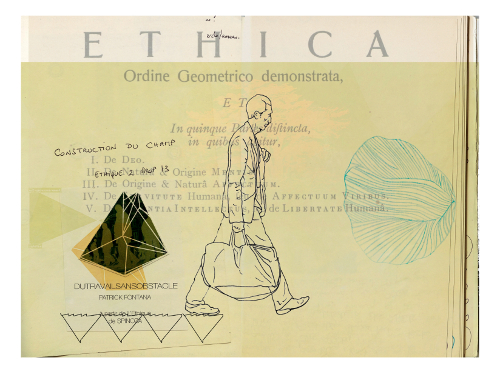
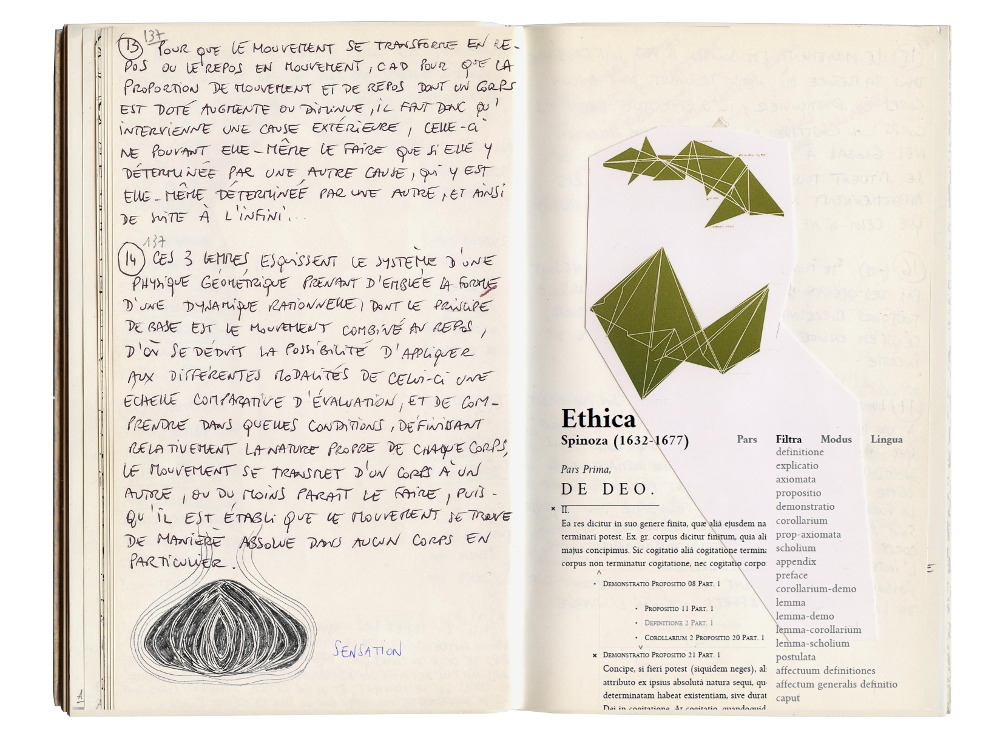
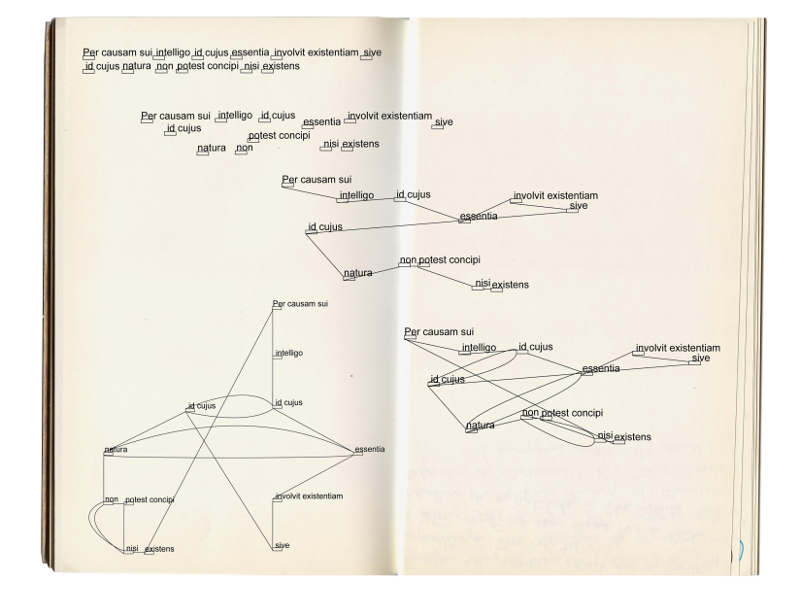
2022, Publication in Pagaille revue of some pages of the booklet Construction du champ, a research booklet on Spinoza's Ethics in their latest online edition under the title Ethica du travail sans obstacle, un chantier Arts & Humanités numériques en mouvement. After the day entitled Digital library and collective intelligence at the University of Paris Nanterre in 2019
Ethica work without obstacle on the web :
-
Ethica, Work Without Obstacle : An Interview with Patrick Fontana, artist July 11, 2019 by Nathan Eckstrand on the blog the The American Philosophical Association ( APA)
-
Anthony Masure, a teacher-researcher in design, talks about the Ethica during his lecture, « Repenser les interfaces du savoir », conférence à l’occasion des Rencontres crossmédias IDEFI CréaTIC, dir. Ghislaine Azémard & Arnaud Laborderie, MSH Paris Nord, 21 janvier 2019.
- Ethica is listed in the Campus Katalog Bibliothekssystem of Hamburg University
- On eadh.org The European Association for Digital Humanities (EADH)
Artistic research
I shall consider human actions and desires in exactly the same manner, as though I were concerned with lines, planes, and solids. Spinoza, Ethics III, Preface.
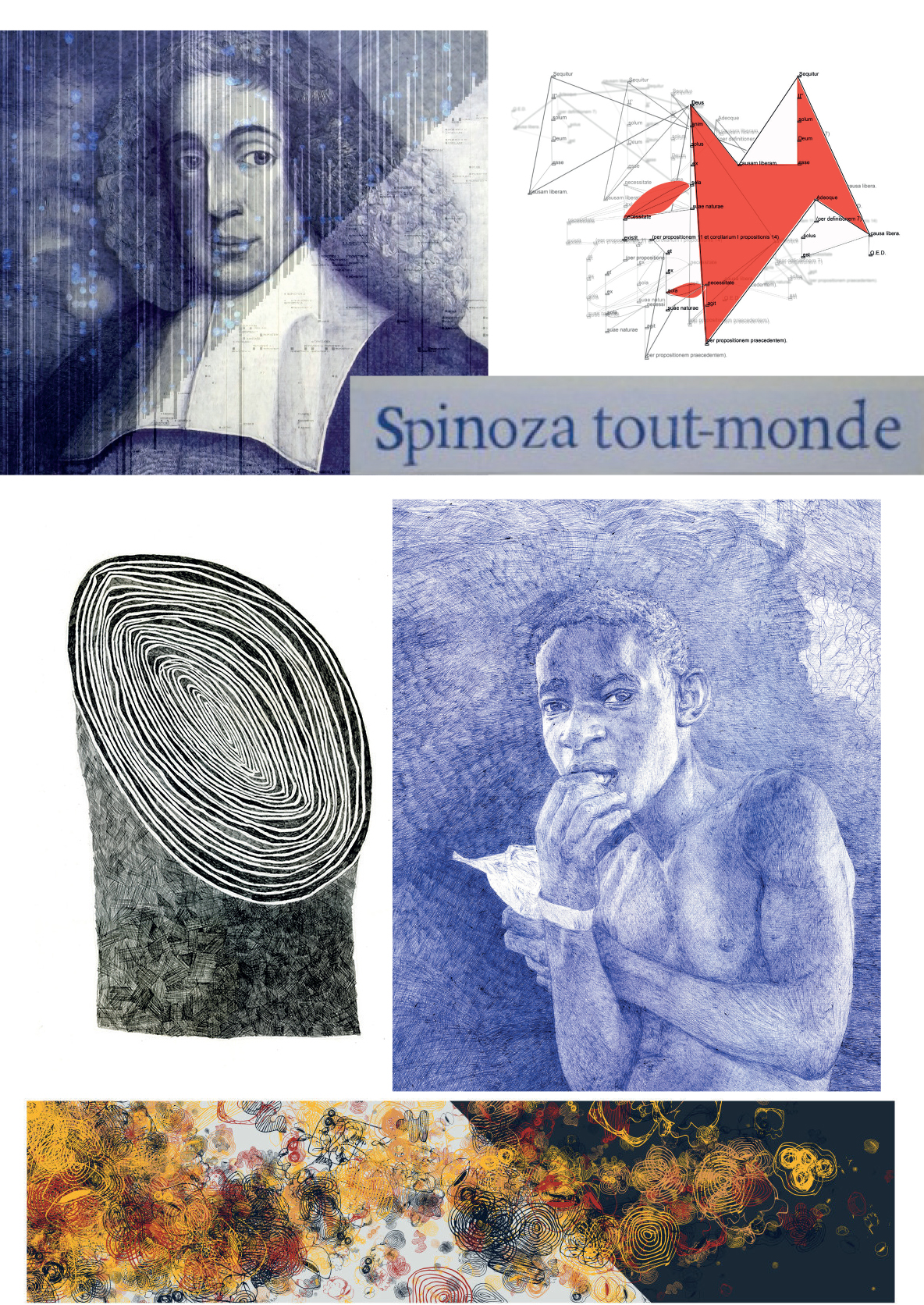
Among all the texts that I have studied and used in my artistic work, the Ethics by Spinoza was the one who moved me the most and gave me the greatest joy. A new dimension of thought has been offered to me.
What immediately aroused my interest, then my passion, is the thought system put in place, the way in which all texts interact. A meeting as strong with a text, otherwise difficult, called me and put me to work.
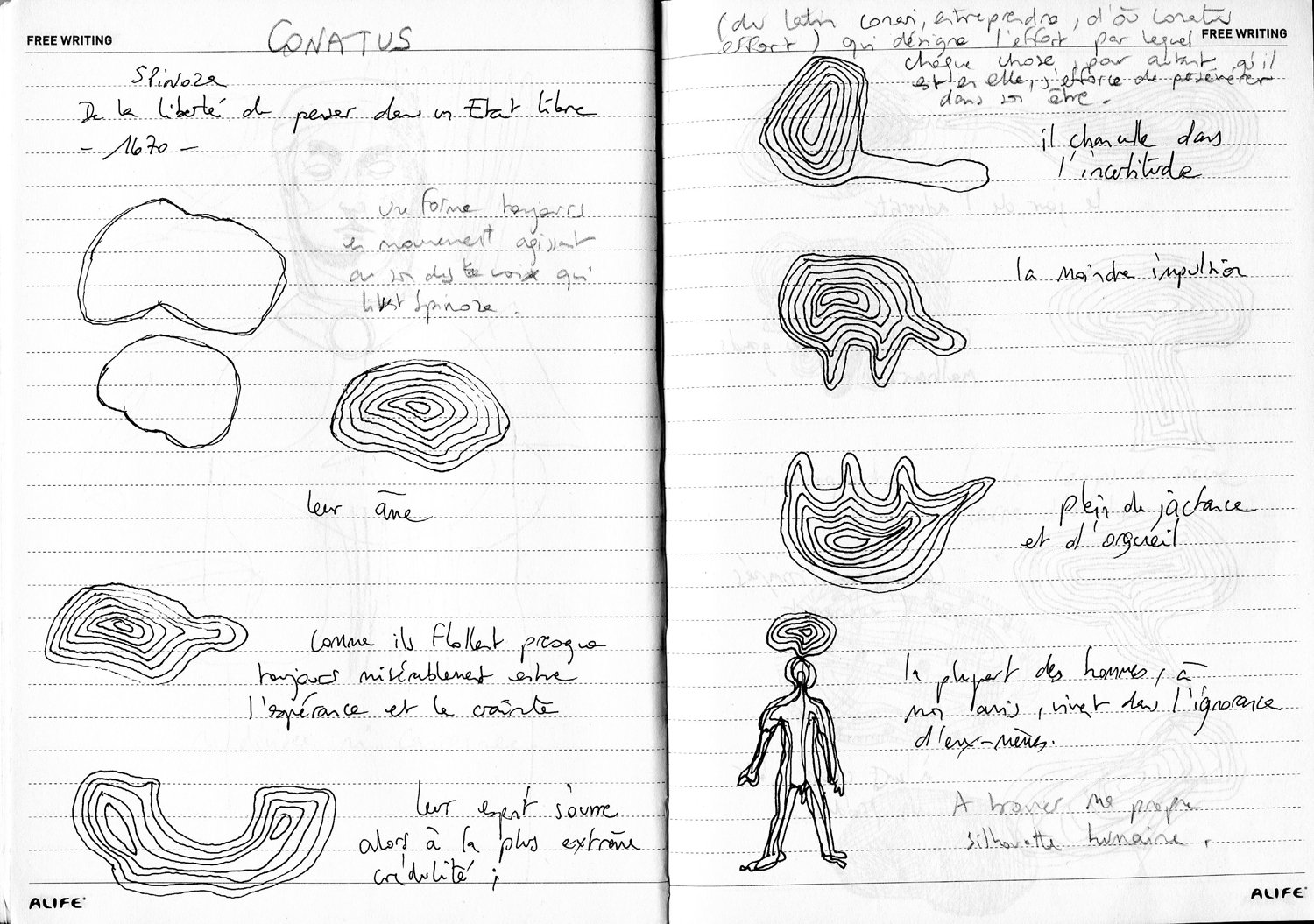
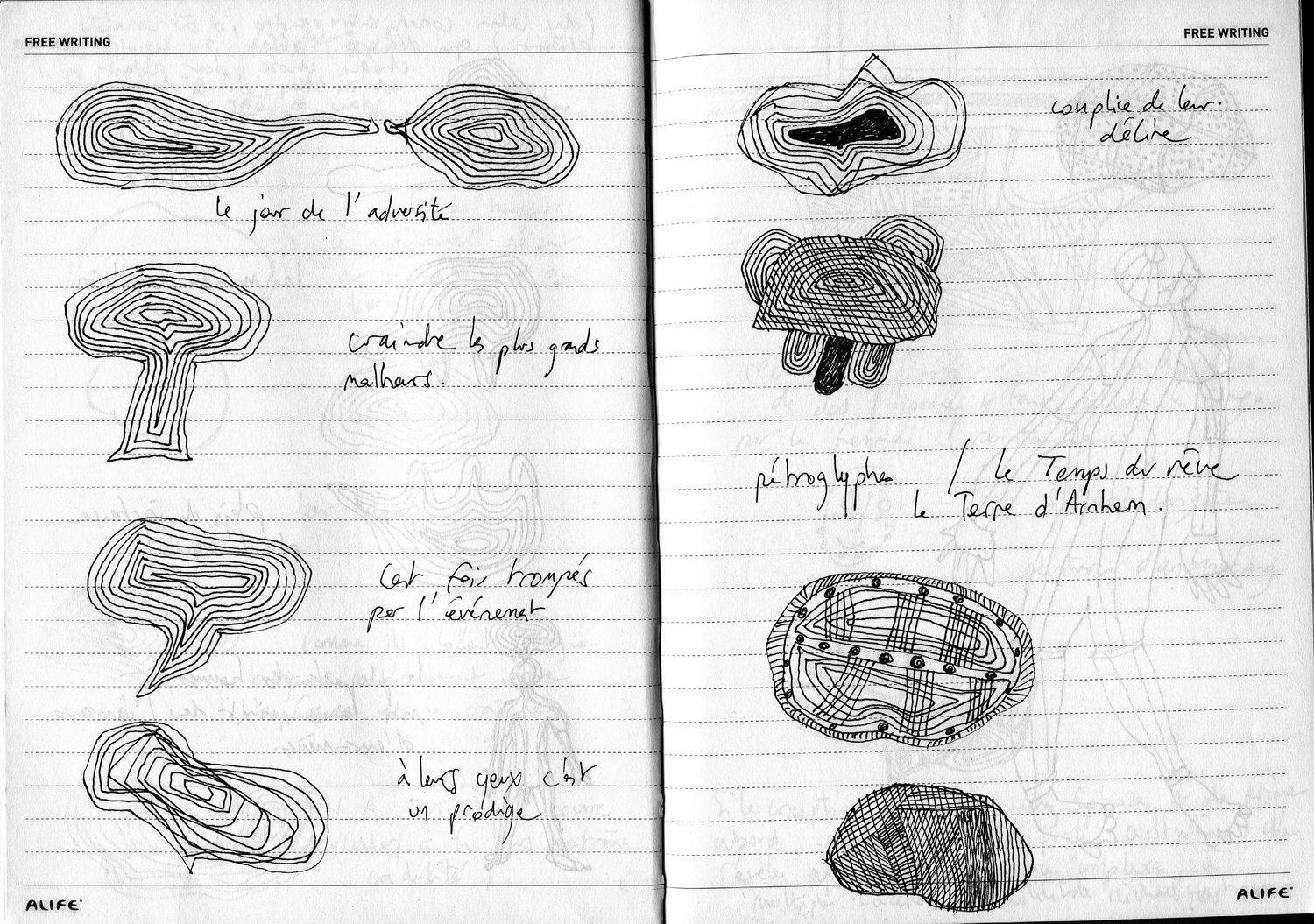
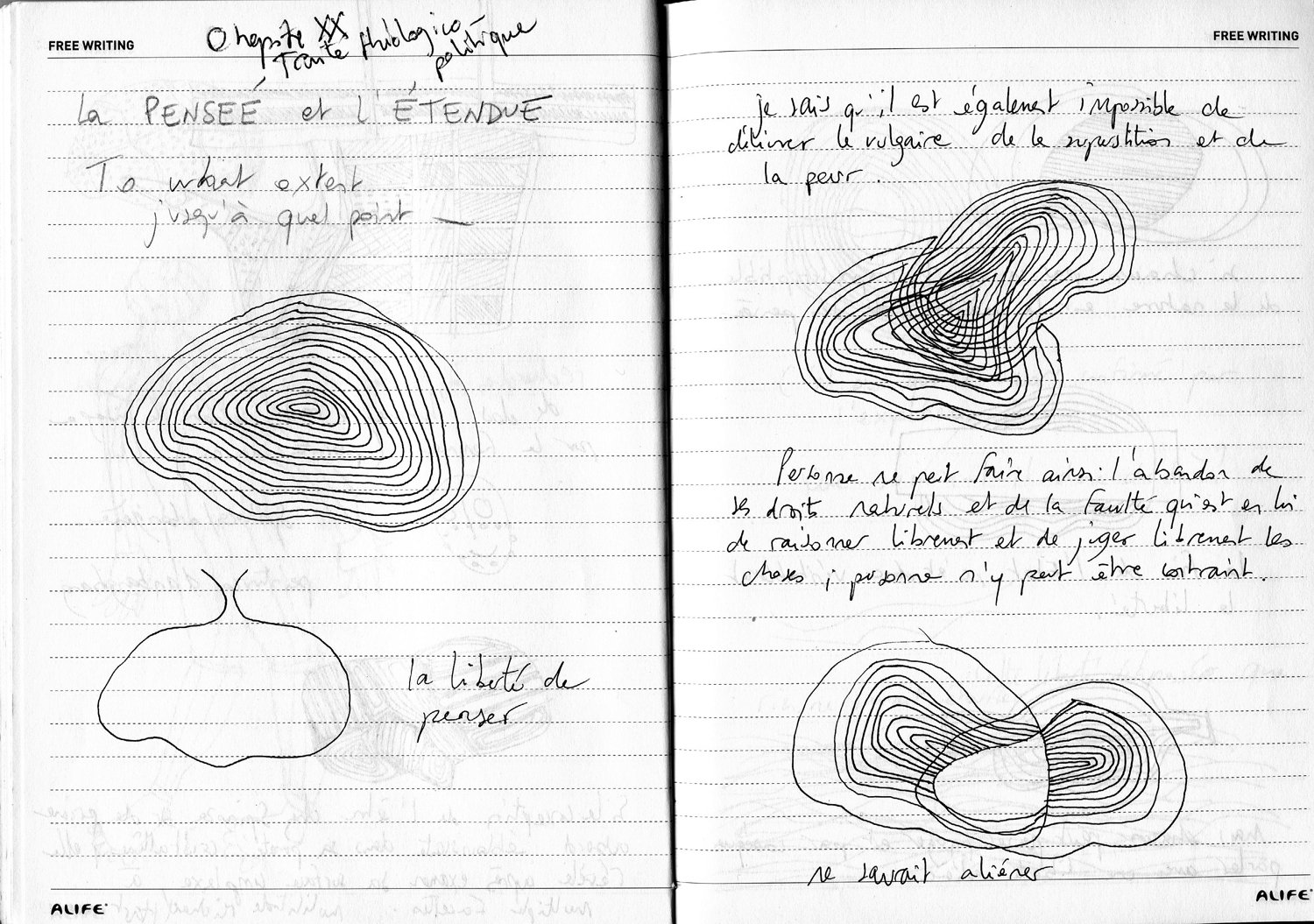
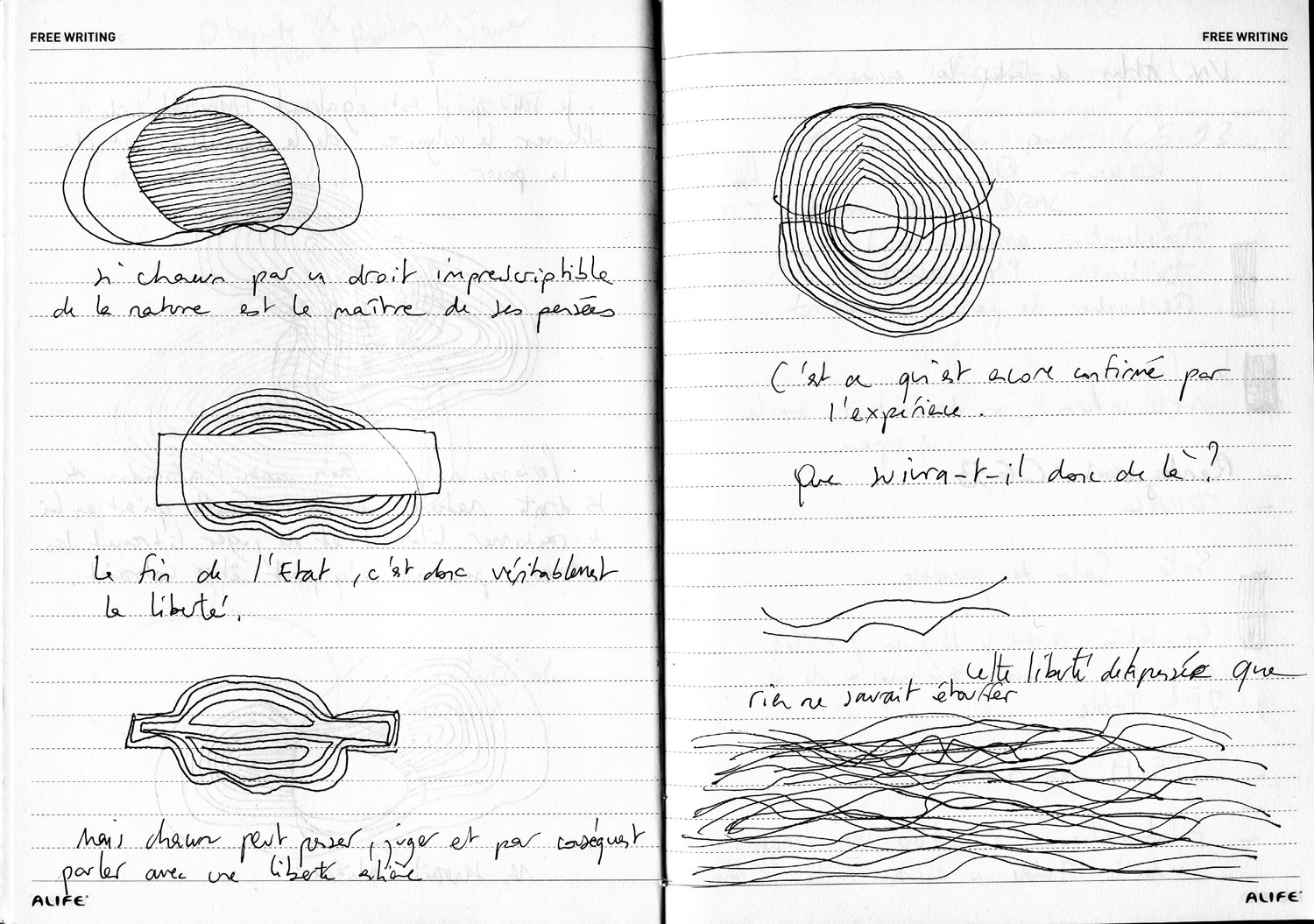
Drawn notes, Spinoza, the freedom to think, 2009.
My first idea was to make Ethics a digital installation. All texts (932) were registered in the form of digital projections in perpetual motion, on a digital plane in three dimensions. The installation was already accompanied by sound recordings of philosophers, researchers, and passionate of the Ethics.
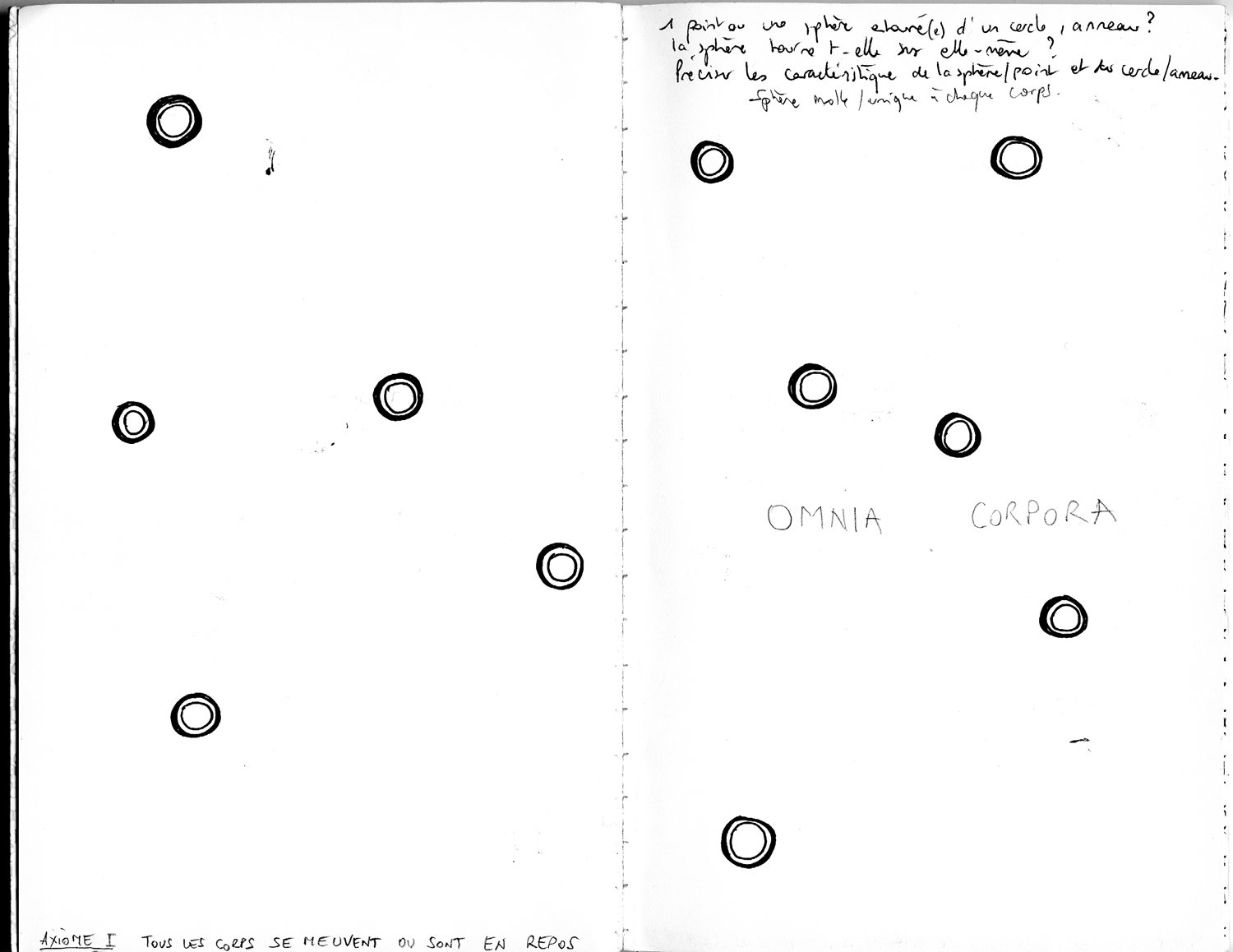
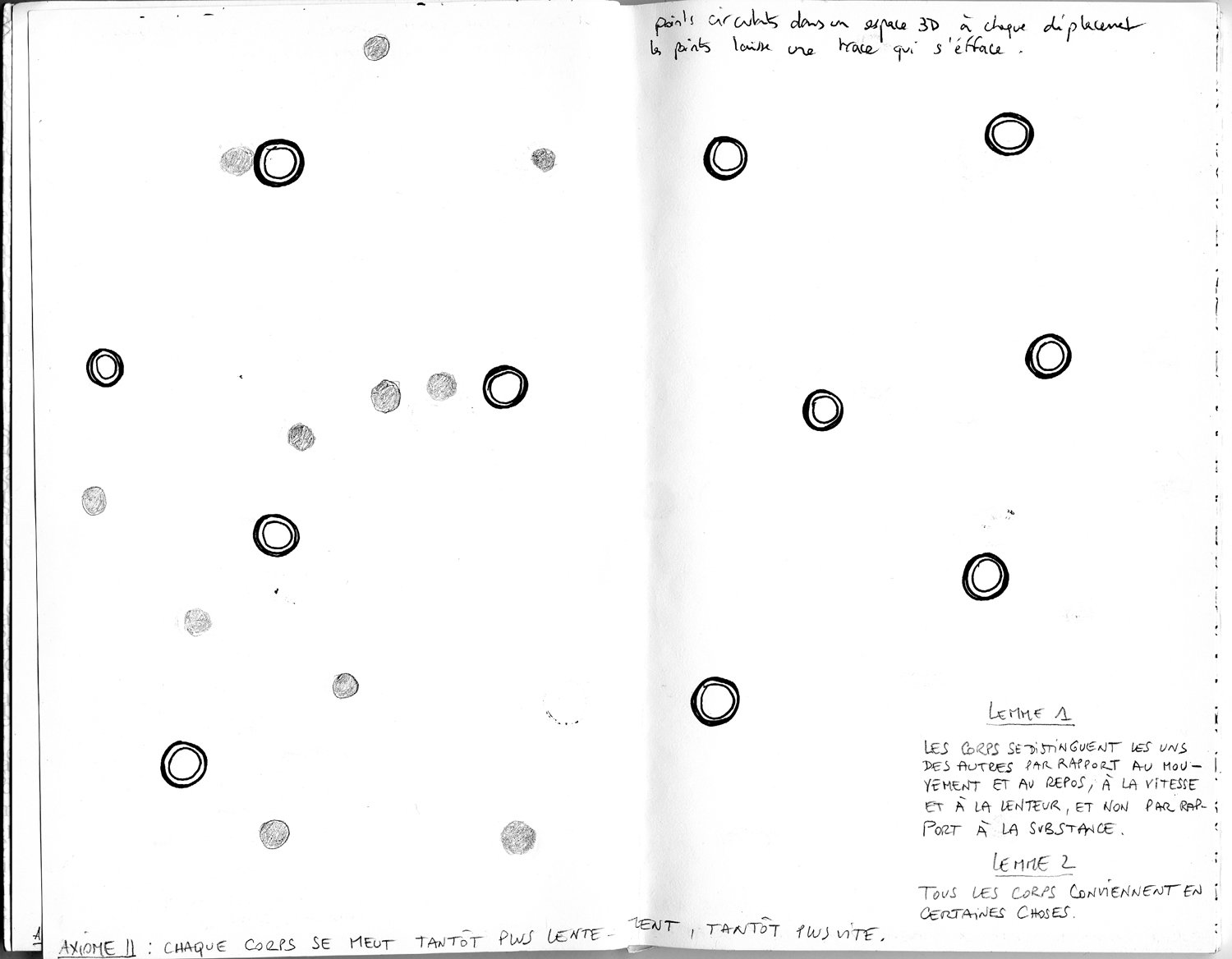
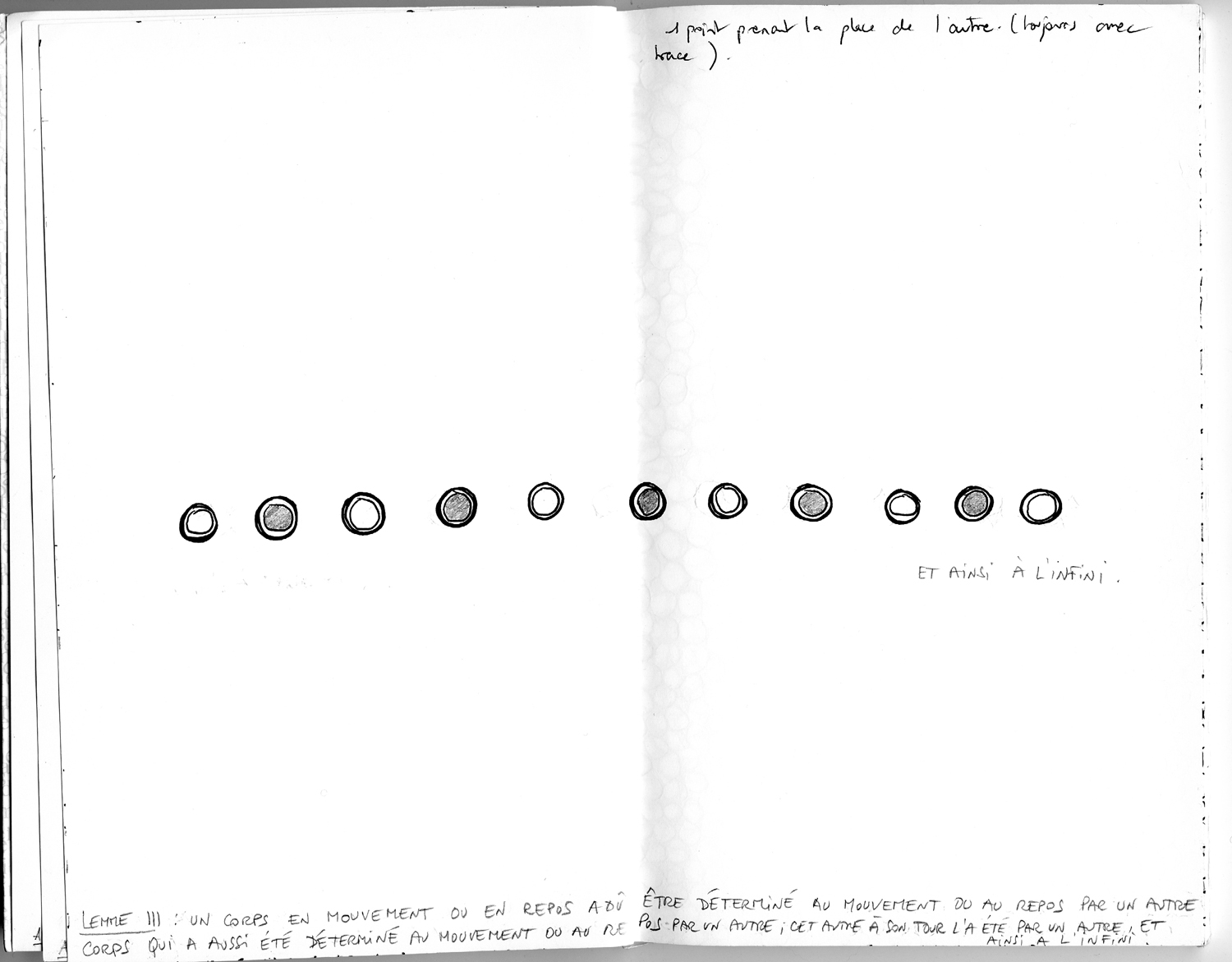
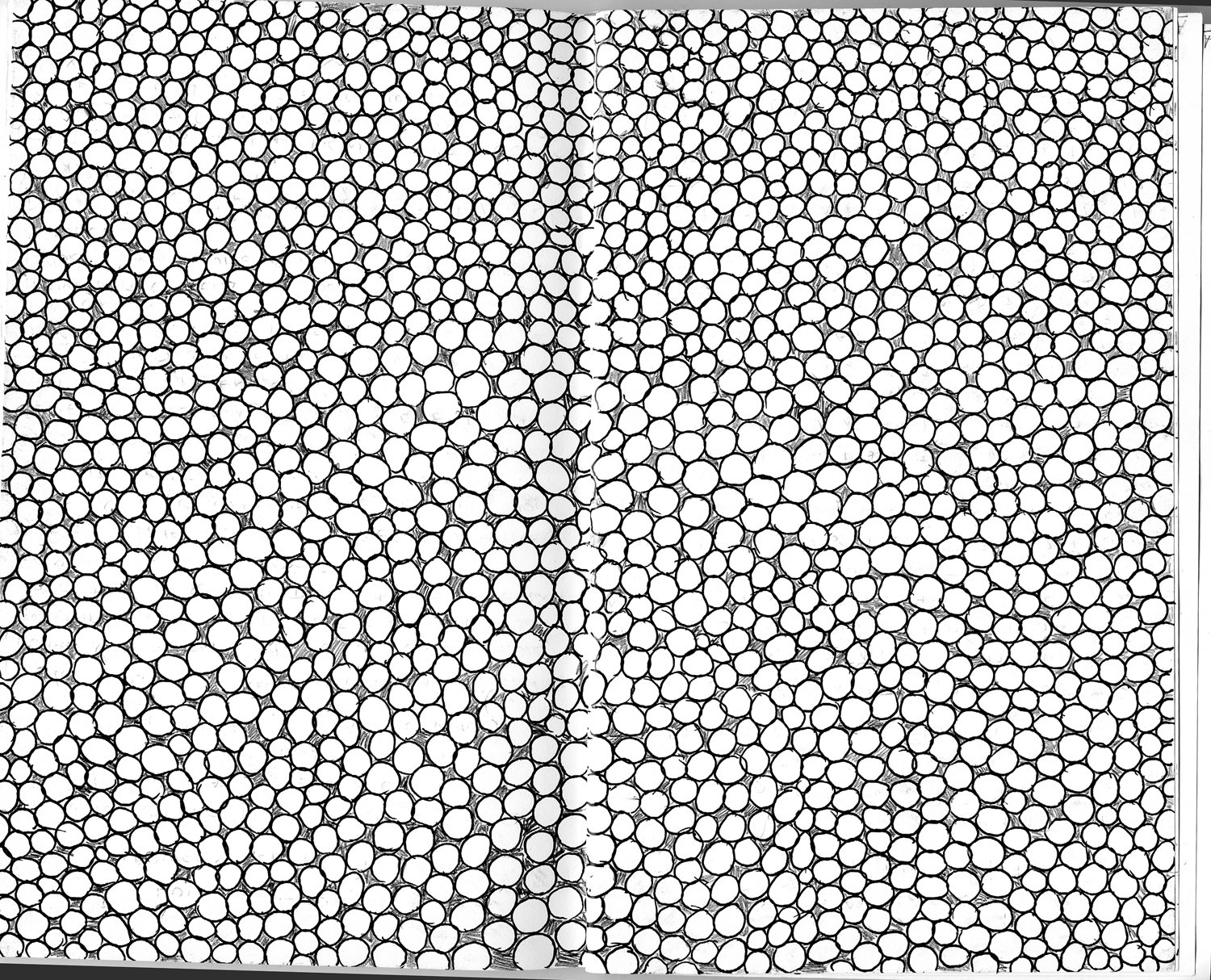
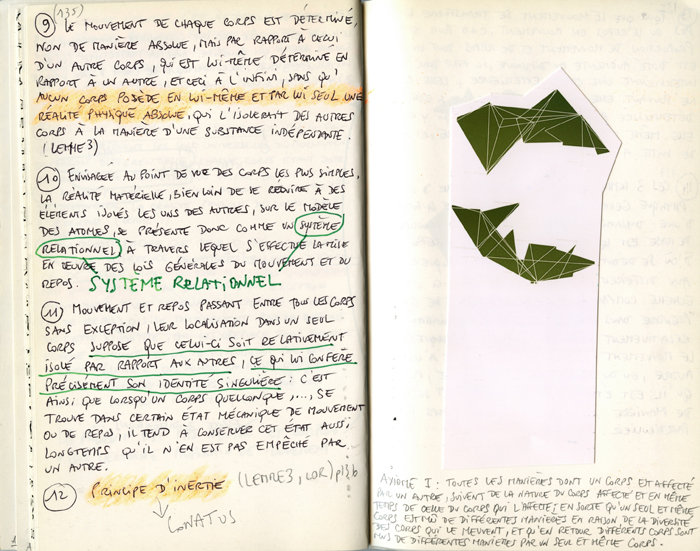
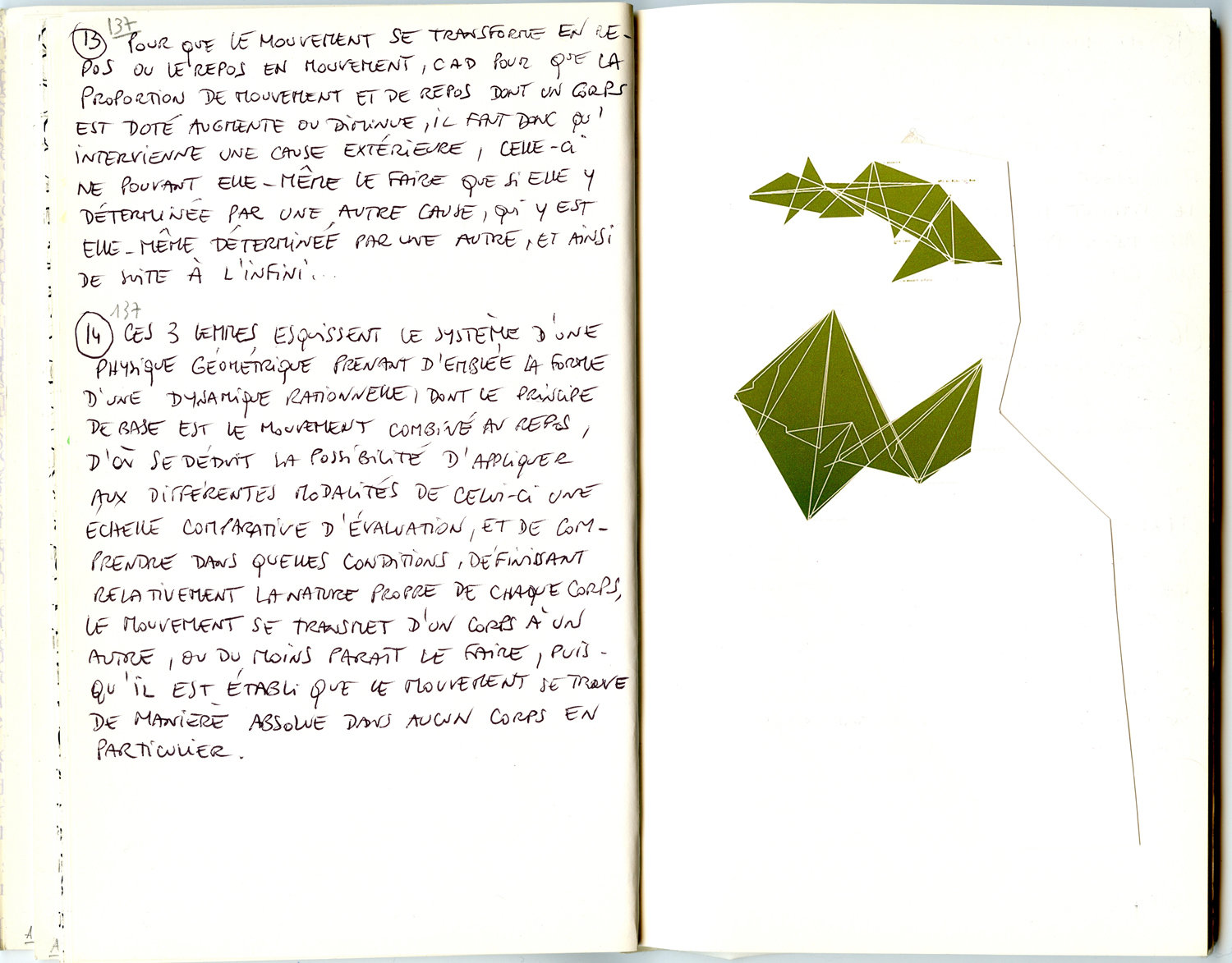
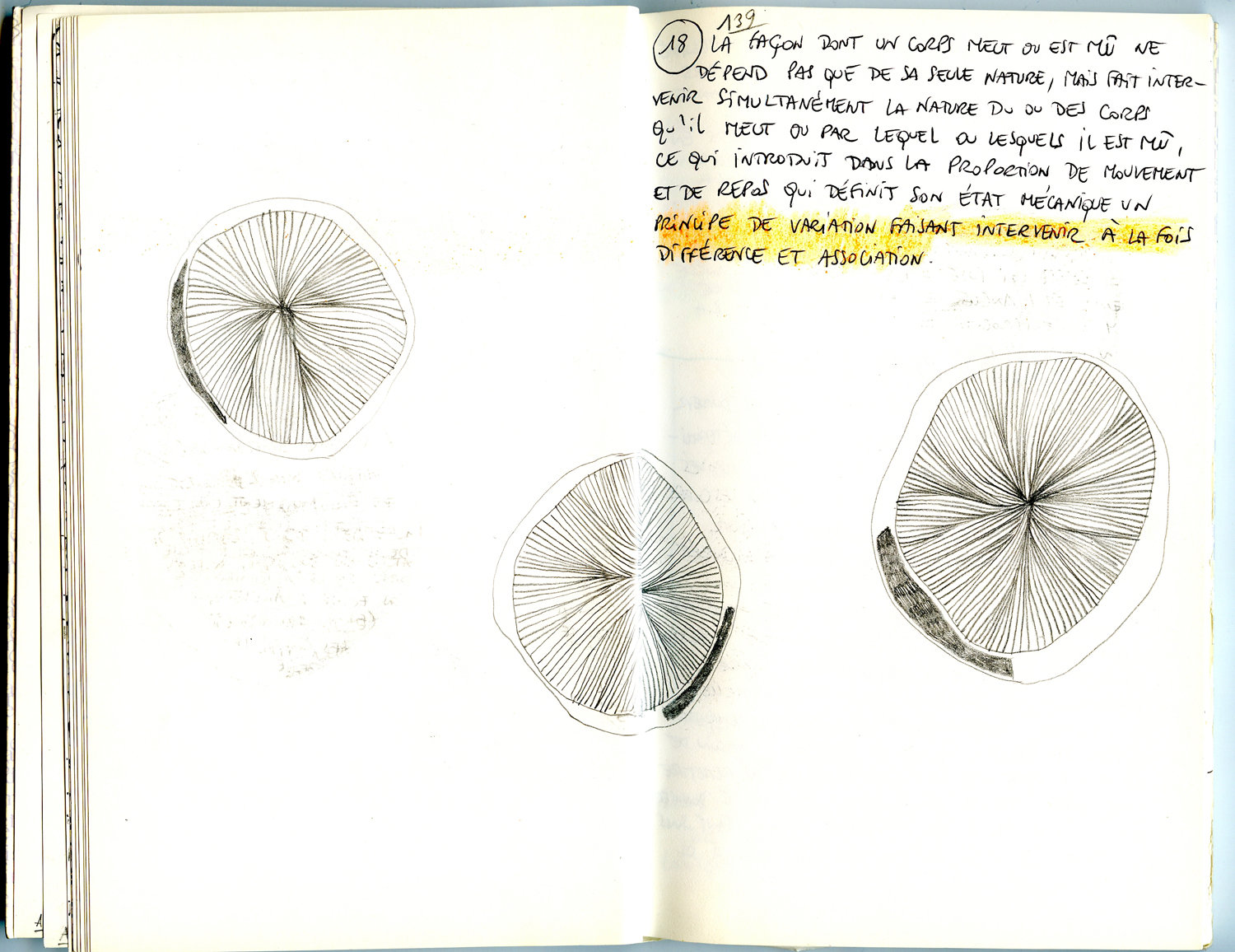
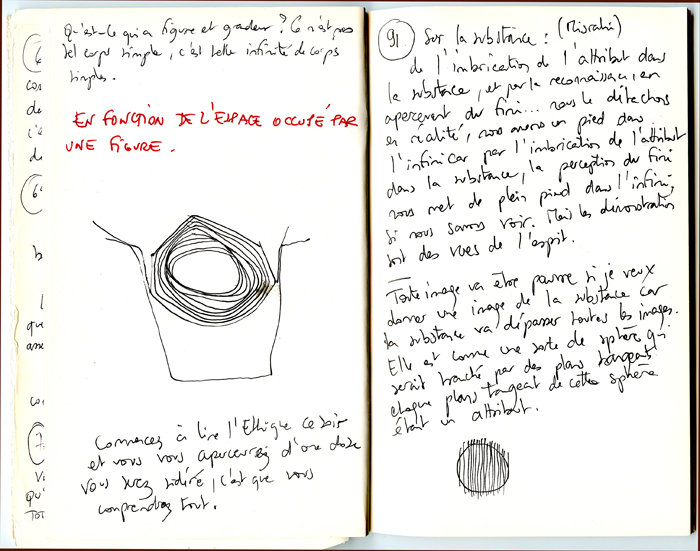
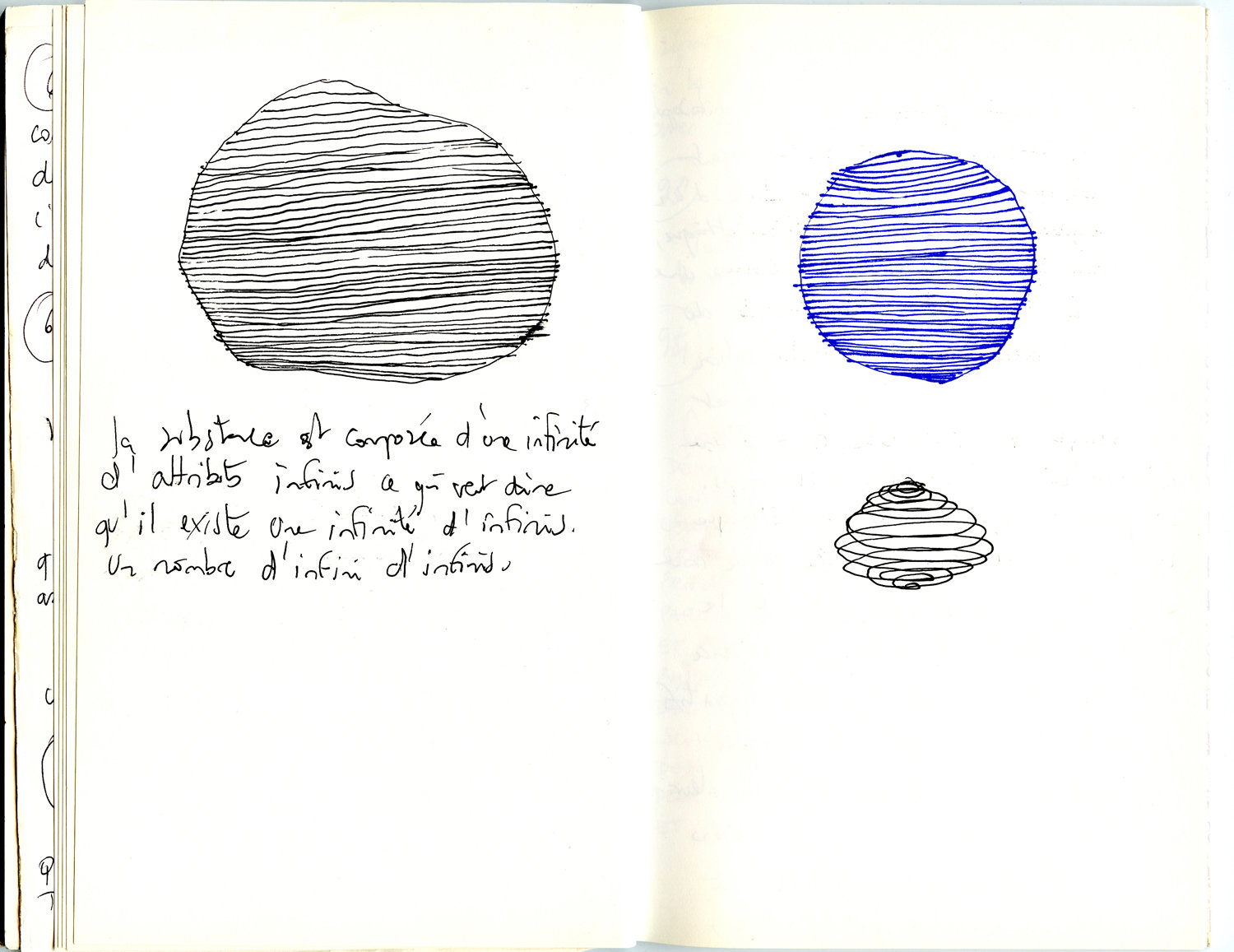
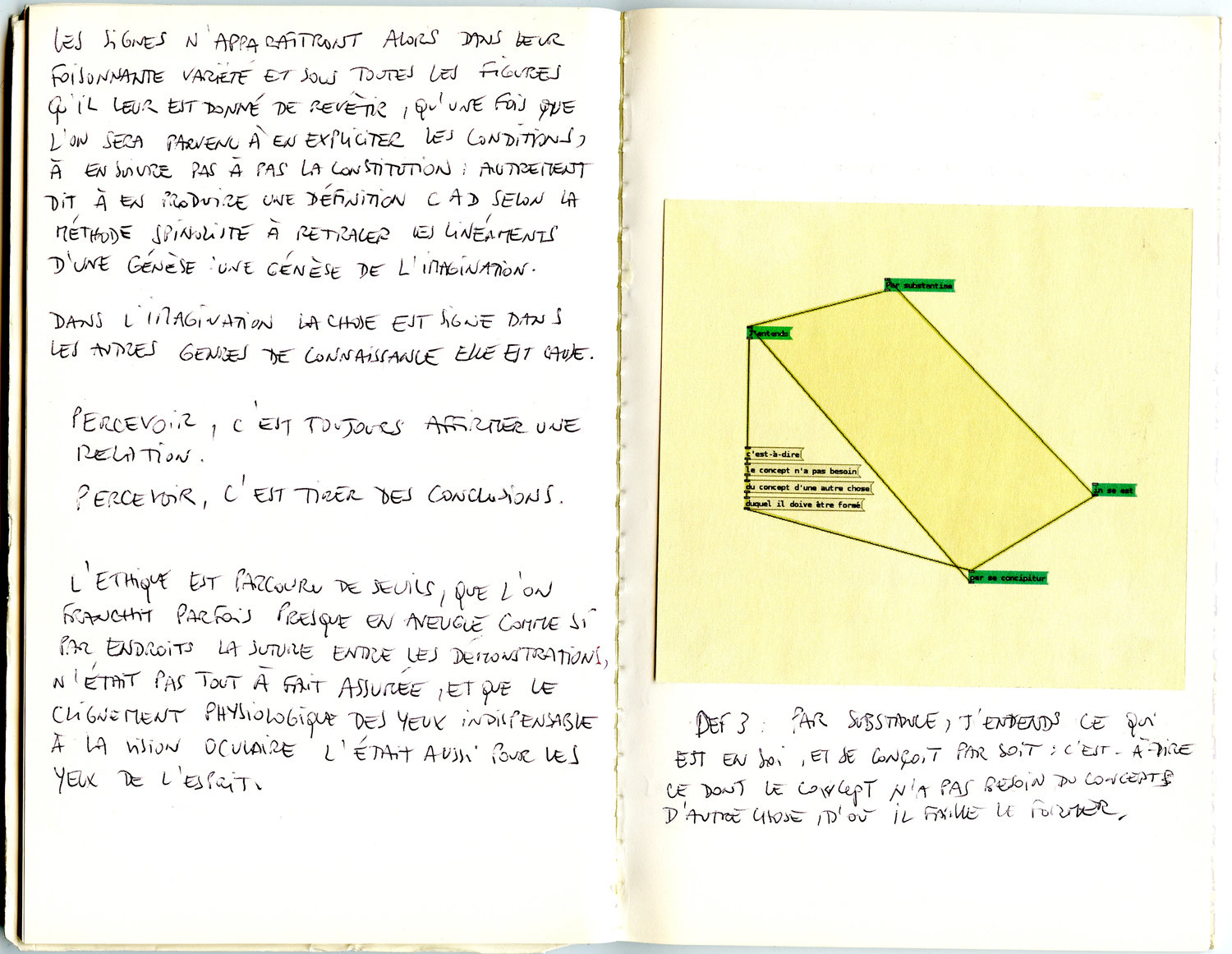
Notebook on the small physics of Spinoza, 2013.
But the spectacular side of the installation did not satisfy me, because it took me away of my desire to propose an immediate meeting with the philosophy of Spinoza by directly immersing the reader in the Ethics.
It is important this idea to create desire to go through the Ethics. This is the meaning of my approach.
The choice of the digital application was quickly imposed because it allowed to expose the text in an innovative way without proposing my interpretation. The creation of an application being totally foreign to me, it took me some time to learn and find the right people to accompany me in this project.
In 2013, I received financial support for Ethica from Centre National du Cinéma et de l’image animée (CNC) and from Société Civile des Auteurs Multimédias (SCAM) rewarding artists working on new digital scripts. The project could start.
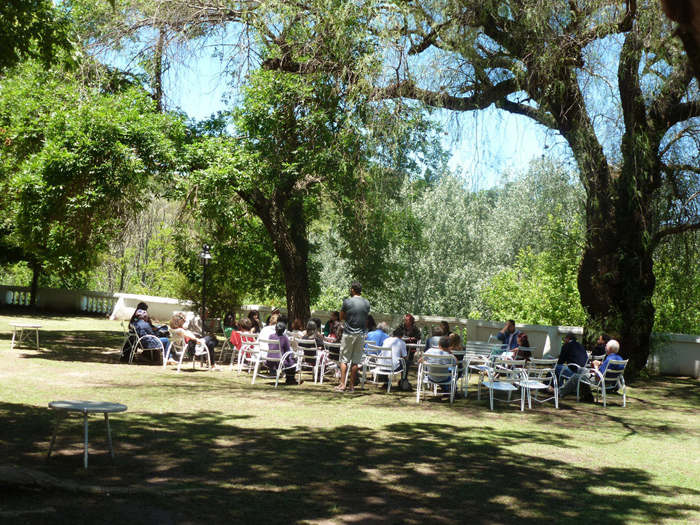
XII Conference Spinoza and the Americas, Cordoba, Argentina, december 2015.
I started making contact with philosophers to talk about the series of comments videos that would accompany the user in his readings of the Ethics. They were immediately very enthusiastic and today, more than 100 philosophers from around the world wish to participate in this project.
The many philosophers that I have met all along the development of the application, helped me better understand the Ethics and why this book is also important for its readers. I also heard their expectations of a digital tool. They trusted me and encouraged me to develop Ethica.
Modeling the Ethics?
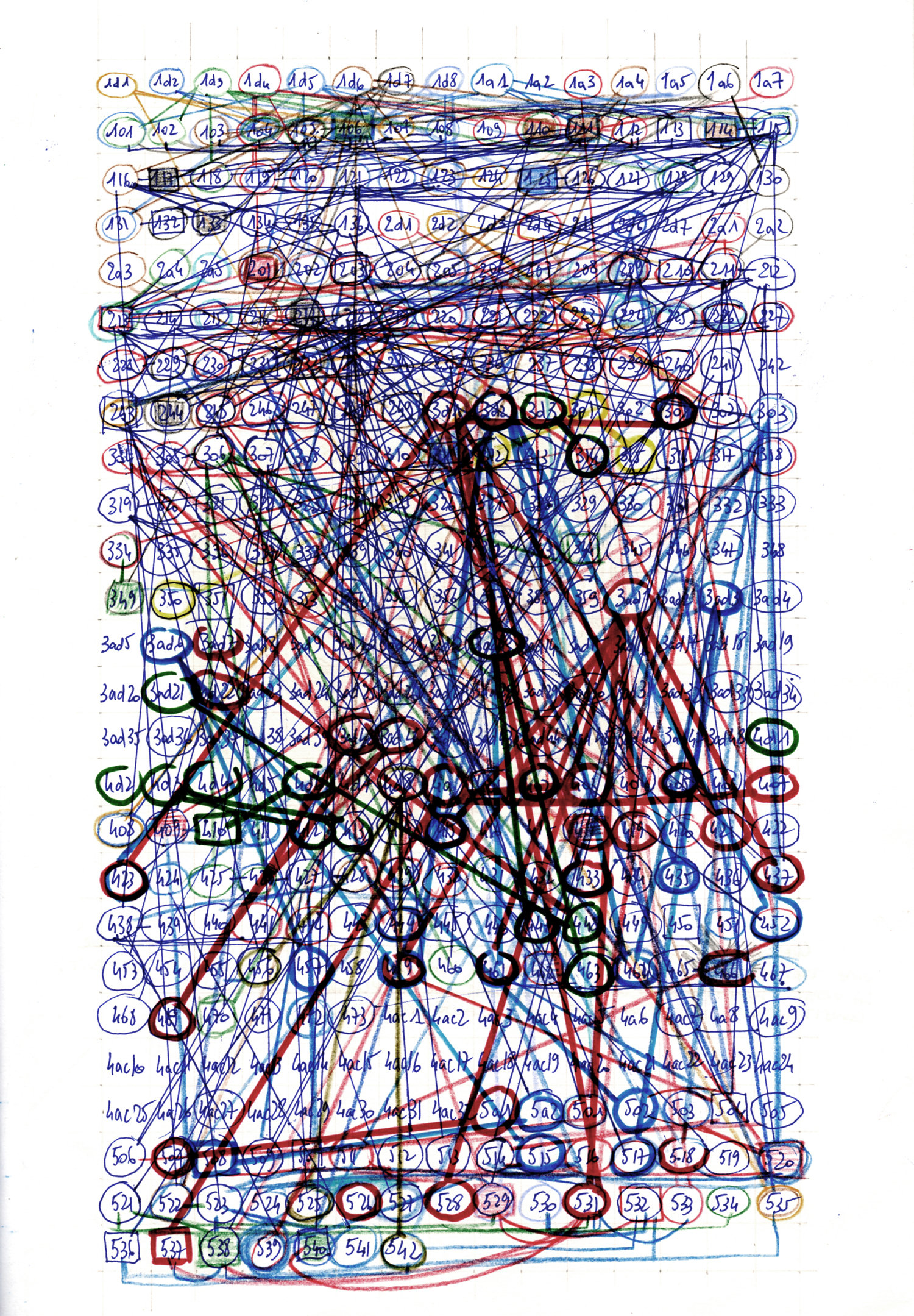
2010, connexions in the Ethics.
The place of the computer tool in my work has always been subject questioning because I need to demystify the technical devices that I use.
The first graph on all connections between texts was realized with the software Pure Data in 2012.
In 2013, I proposed to Vincent Rioux, head of the digital center of the School of Fine Arts of Paris, to develop together a 3D digital graphic (called ALLi for ALL links) connections between texts.
ALLi did not allow to read the Ethics from connections between texts, in a fluid and intuitive way. 3D became too sophisticated and could be a brake to read the text.
So I developed other graphs in 2D.
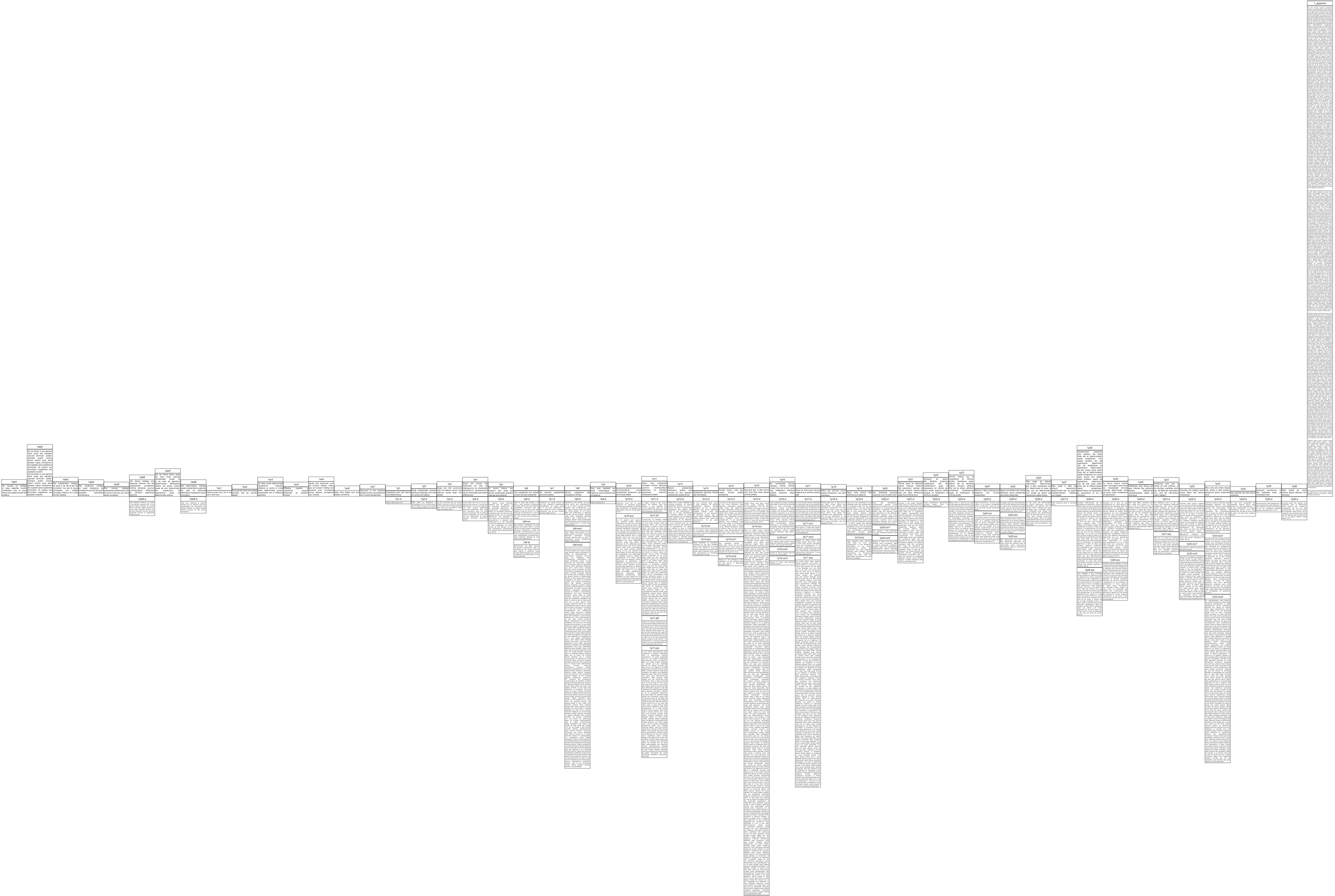
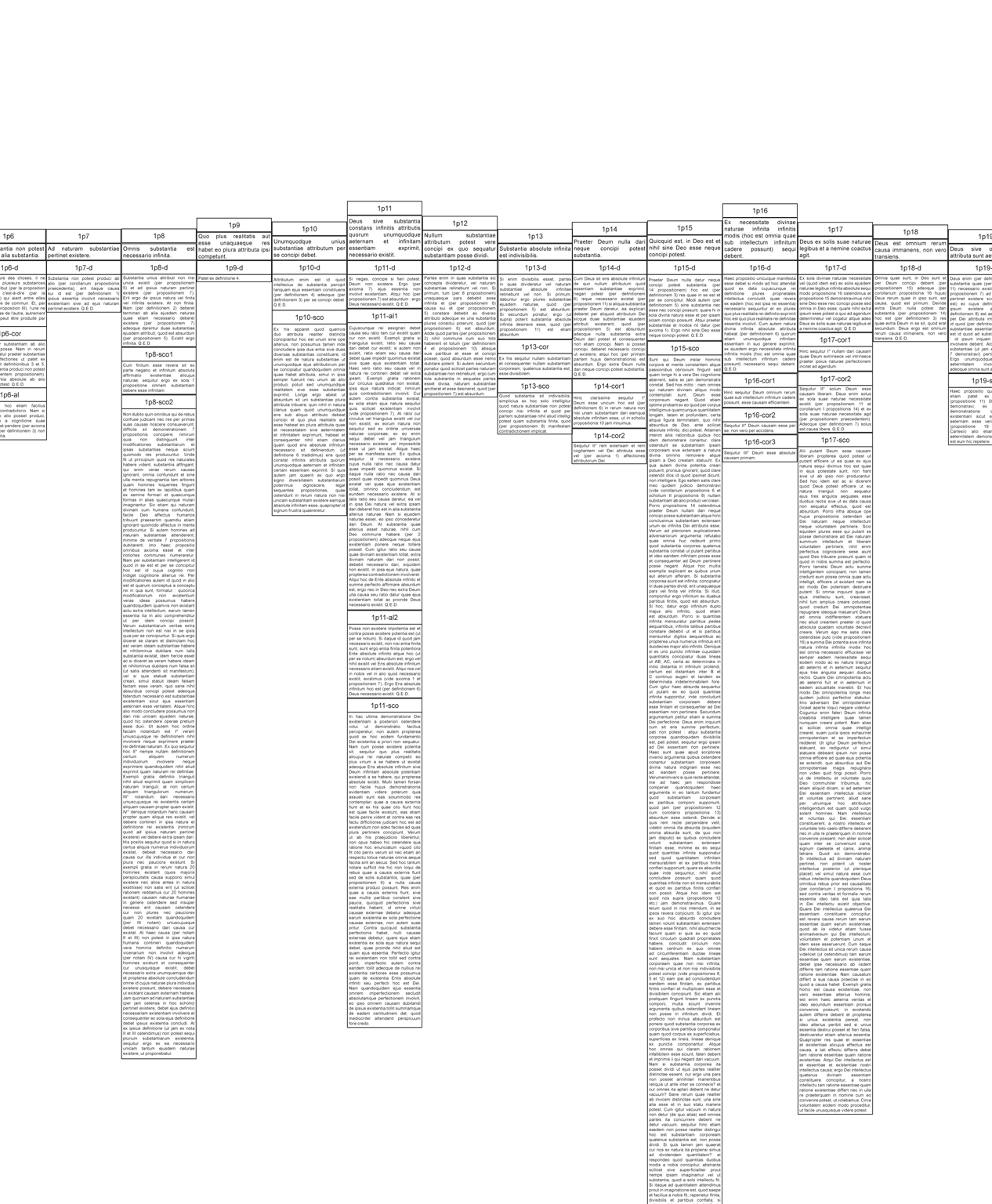
Ethics part I.
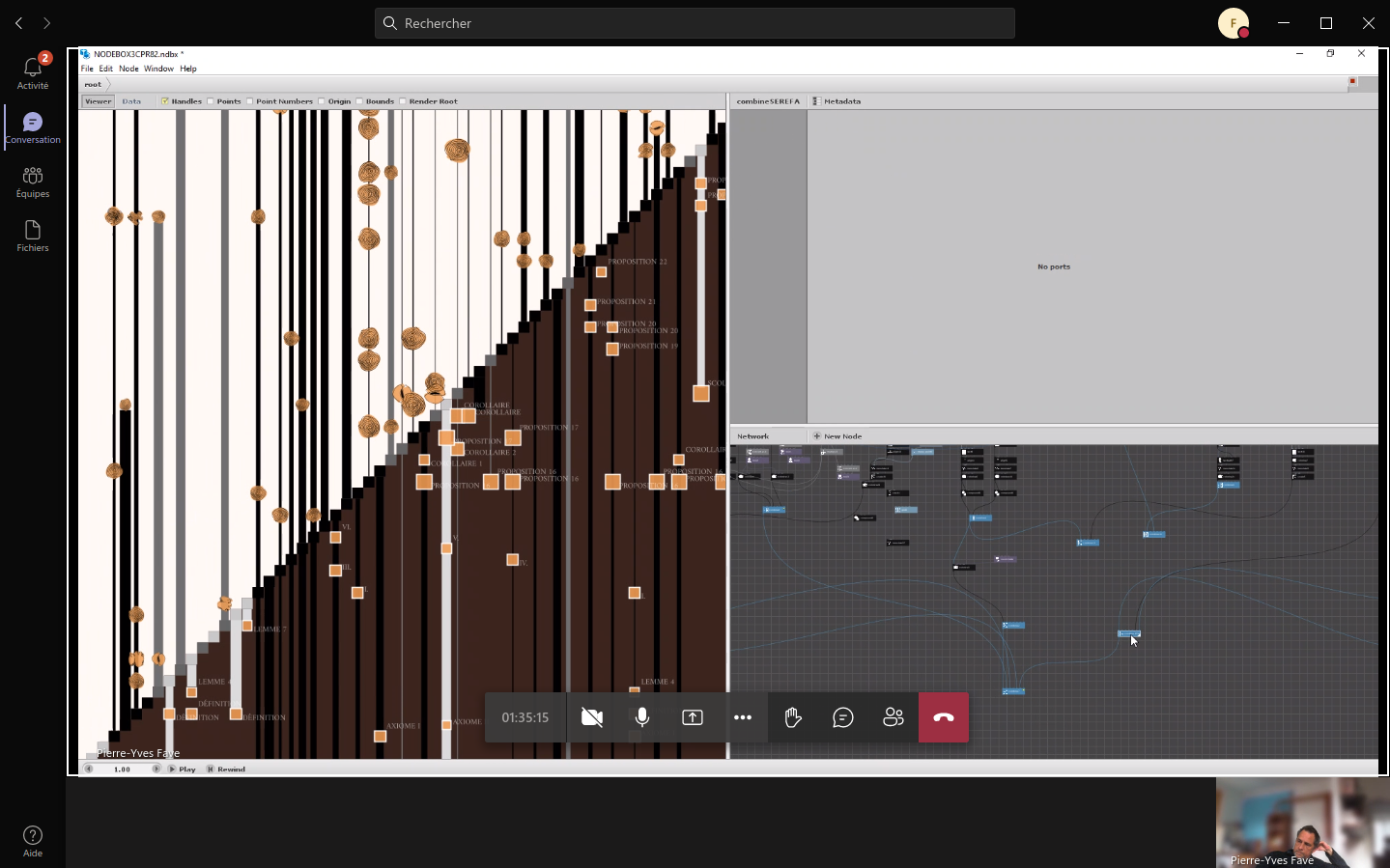
The graphic the Rigorous Counterpoint is at the base of the developments found in the application.
All these graphs could be confused with a representation of the Ethics. Some wanted to see a cathedral, others a planetary system. The challenge was not to propose a univocal representation of the Ethics, but to make visible the connections between the texts, to give the user the freedom and the infinity of routes to read the text.
The first version of the application is the result of this artistic research. It remains incomplete, however.
We still have a lot to develop : increase the application of new translations (we count on you!), new tools to improve this first version of the application; filming the comments of the philosophers and the artistic videos the Exteriors-nights; build the user path which must allow the user to compose his own paths in Ethics with "favorites" as texts, videos, personal notes - these "favorites" can also be presented into graphics that would thus give visual representations of the user's paths through the Ethics-;
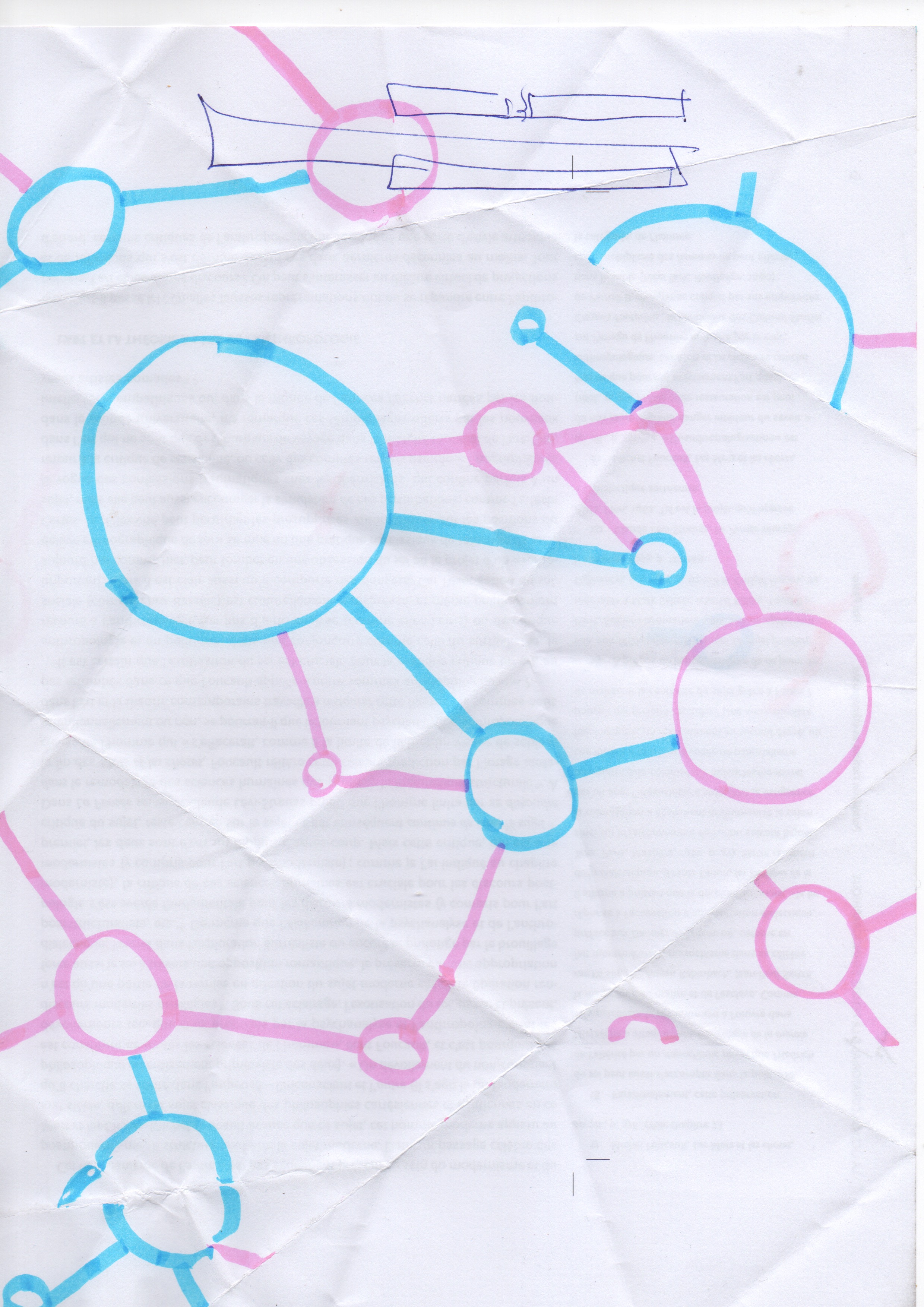
Research for user's paths (Bachir Soussi Chiadmi)
put the graph Rigourous counterpoint in motion and make a catalog of graphic identities of each text of the Ethics ...
But as Henri Atlan once wrote to me : Take all your time. Spinoza is in any case a kind of eternity.
Philosophy and life
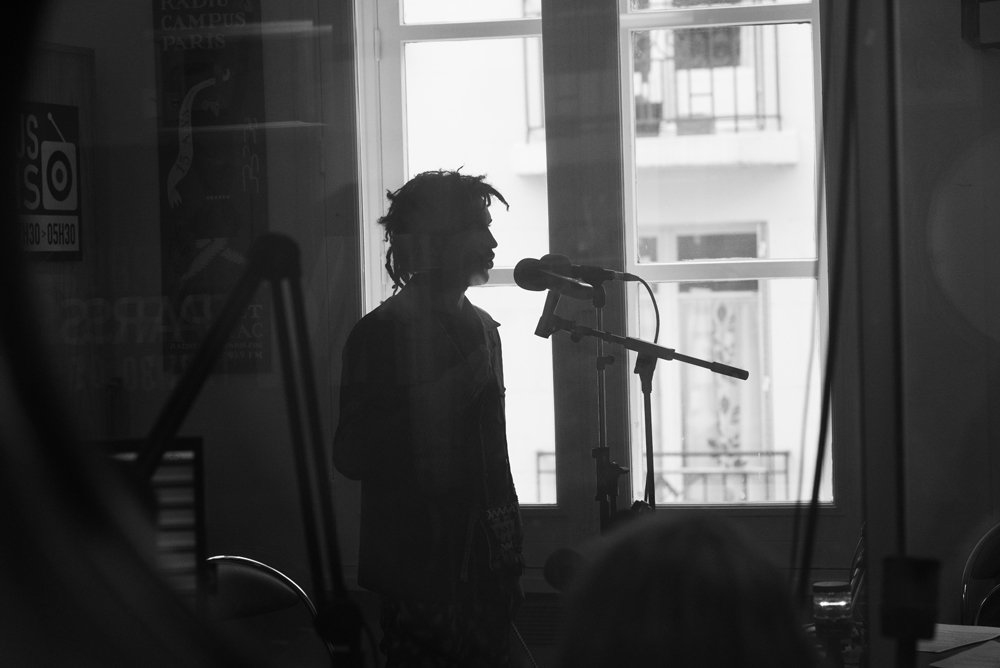
Throughout this work, I sought to develop links between Spinoza's philosophy and life.
In parallel with the development of Ethica, I conducted a workshop of recorded readings of texts of poetry and literature, the workshop Lectures de Bouches, with people learning French as a foreign language. A partnership between the contemporary art center Khiasma directed by Olivier Marboeuf, and the basic training workshop of Emmaüs-Solidarity association, directed by Rose-Marie Ryan, in Paris.
In 2014, I invited the philosopher Nathalie Chouchan to participate to this workshop to work together on excerpts from the Ethics.
Personal texts on Spinoza's Emotions and recordings of discussions were produced, entitled Spinoza All World to discover on Internet radio R22-Tout-monde.
Extract, Spinoza's Emotions.

Radio recordings; Radio Campus Paris, 2014.
Thanks
I thank all the people who accompanied me on this project, especially, Emmanuel Ryz, producer, my wife Dominique Cara-Brighigni, Pierre-Yves Fave, Nathalie Chouchan, Catherine Le Moulec, Michèle Cristofari, all the philosophers who gave me their trust, Roberto Brandão for his translation into Brazilian, and Jean-Pierre Dozon, scientific director of FMSH who invited, for two years, an artist, at the Fondation Maison des Sciences de l’Homme, in Paris.
Patrick Fontana, 2018. www.grenze.org
Videos
Video comments
Philosophers comment on the Ethics in their native languages. They choose 5 texts and develop a strong concept of the Ethics. A general title accompanies their comments. Through their choices, they offer possible entries to understand the Ethics and tracing an original approach to Spinozist philosophy. They explain how the chosen texts are linked and what concept they compose.
Many philosophers can choose the same text, which opens the debate.
The 100 invited philosophers arrange, as they wish, the contents of Ethica. So there will be texts without comments.
Each comment is accompanied by its written transcription, available in several languages.
All of the comments thus form a map of Spinozist research at the beginning of the 21st century.
See the list of philosophers and of their choices at the bottom of the page
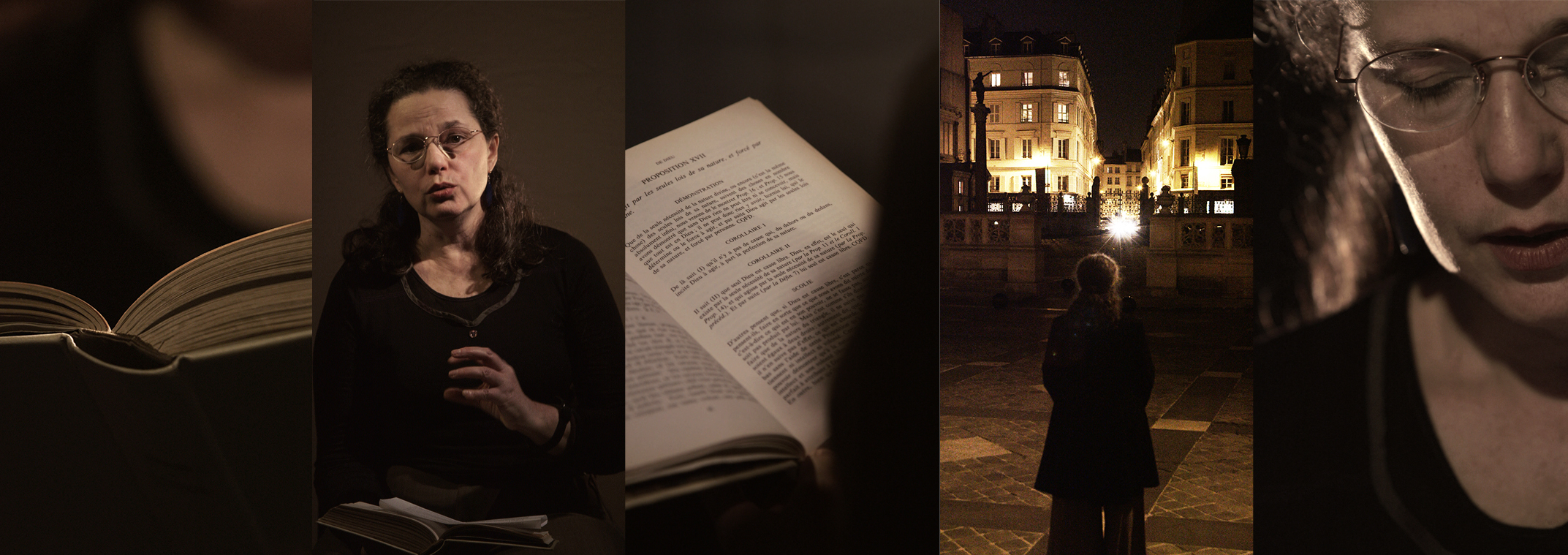
Nathalie Chouchan, philosophe
Technical details
Philosophers addresse the user, facing the camera.
The video image is 16/9 inverted in the application for aesthetic and ergonomic reasons.
Both cameras planned will have to adapt to the constraints of a traveling shooting, without harming the harmony between the different sequences.
Exteriors-nights
When everything is gone in the night, "everything is gone" appears. Maurice Blanchot
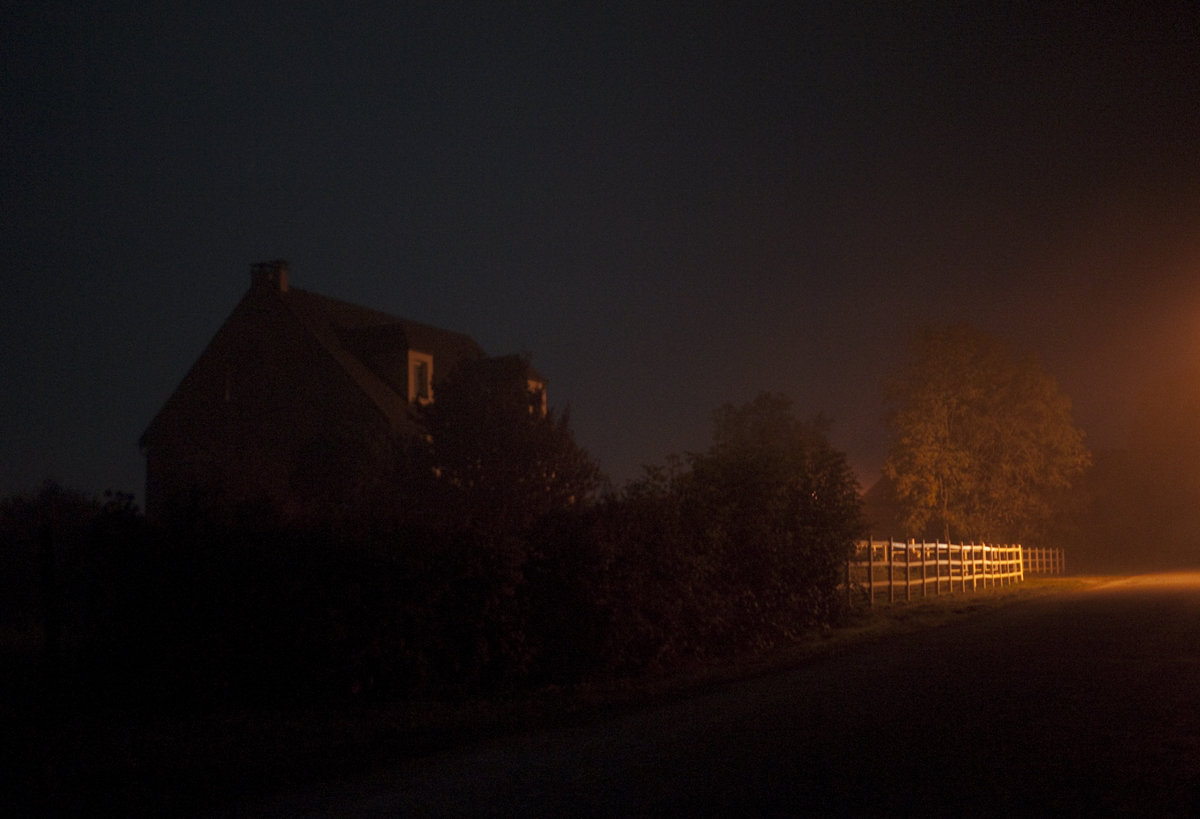
Thomas Lallier
La nuit filmée
A single night to accompany the readings of the Ethics filmed in twenty countries. It is composed of shots of a few seconds, inhabited or not, photographs in durations, with a simple plastic intention.
These short sequences accompany the video comments and are available to the user.
In the night, our senses are disoriented, everything becomes uncertain, the forms, the sounds, the materials are concealed. The nocturnal landscapes envelop us. The night transforms us, the time is experienced in another way. On the contrary, the electric, artificial night reveals everything, compels us. Illuminations and obscurities punctuate together, this filmed night.
The filming guideline is experimentation related to the diffraction of light through different lenses, through the movements of lights in the night, reflections in mirror, playing on the speed of recording and which show the real, echoing Spinoza, lens polisher.
Video financing
Videos, Comments and Exteriors-nights are not yet funded. They will represent more than 150 hours of commentary available in the application, filmed in more than 20 countries around the world.
We need your help, if you are interested in financing videos, please contact, please contact Patrick Fontana.

Thomas Lallier
List of participating philosophers and their choices
-
Cecilia Abdo Ferez
- La producción de lo justo
- Proposition 37, Part IV
- Proposition 37 Scol. 1, Part IV
- Proposition 37 Scol. 2, Part IV
- Proposition 68, Part IV
- Proposition 68 Scol., Part IV
- La producción de lo justo
-
Jacob Adler
-
Saverio Ansaldi
- Les images de Dieu
- Proposition 4, Part V
- Proposition 4 Scol., Part V
- Proposition 14, Part V
- Puissance et éternité des images
- Proposition 39, Part V
- Les images de Dieu
-
A. Arbex Valadares
-
Henri Atlan
-
- Proposition 16, Part I
- Proposition 7, Part II
- Proposition 2, Part III
- Proposition 14, Part IV
- Proposition 1, Part V
-
-
Steve Barbone
-
Adriana Barin de Azevedo
- O aprendizado do que pode um corpo
- Proposition 2 Scol., Part III
- Proposition 13 post.3, Part II
- Proposition 51, Part III
- Proposition 51 Scol., Part III
- Proposition 39, Part IV
- O aprendizado do que pode um corpo
-
Fernando Bonadia
- A definição de comum
- Proposition 37, Part II
- Educação e arrependimento
- Definition 27 of Emotions, Part III
- Educação e razão
- Chapter 9, Part IV
- O sentido da educação
- Chapter 13, Part IV
- Amor dos pais e educação dos filhos
- Chapter 20, Part IV
- A definição de comum
-
Roberto Bordoli
- Agir entre savoir et sagesse
- Proposition 15, Part I
- Proposition 36, Part I
- Proposition 13, Part II
- Proposition 14, Part IV
- Proposition 42, Part V
- Proposition 42 Scol., Part V
- Agir entre savoir et sagesse
-
Daniela Bostrenghi
- Imaginandi potentia
- Proposition 17 Scol., Part II
- Sulla "imitatio affectuum"
- Proposition 27, Part III
- Proposition 27 Scol., Part III
- Proposition 27 Coroll. 1, Part III
- Proposition 27, Coroll. 2, Part III
- Proposition 27, Coroll. 3, Part III
- Sull'uomo "pars Naturae" e "affectibus obnoxius"
- Proposition 4 Coroll., Part IV
- Sull'uomo libero e la "civitas"
- Proposition 73, Part IV
- Affectus, qui desinit esse passio
- Proposition 3, Part V
- Proposition 3 Coroll., Part V
- Imaginandi potentia
-
Filip Buyse
- Galilée et Spinoza; Spinoza et Galilée
- Appendix, Part I
- Proposition 13 Definition, Part II
- Proposition 16, Part II
- Proposition 39, Part IV
- Proposition 17, Part V
- Galilée et Spinoza; Spinoza et Galilée
-
Riccardo Caporali
- Causa e potenza
- Proposition 25 Scol., Part I
- Appendix, Part I
- Proposition 3 Scol., Part II
- Proposition 20 Scol., Part IV
- Proposition 67, Part IV
- Causa e potenza
-
Anish Chakravarty
- Indivisibility of Extension and its attribution to God
- Proposition 12, Part I
- Proposition 13, Part I
- Proposition 13, Coroll., Part I
- Proposition 15, Part I
- Proposition 2, Part II
- Indivisibility of Extension and its attribution to God
-
Marilena Chaui
-
Nathalie Chouchan
-
- Proposition 13 Scol., Part II
- Proposition 29 Coroll., Part II
- Proposition 57, Part III
- Proposition 45 Scol., Part IV
- Proposition 73, Part IV
-
-
Yves Citton
- Spinoza médiologue : une logique des affections (médiatiques)
- Proposition 14, Part III
- Proposition 15, Part III
- Proposition 16, Part III
- Proposition 17, Part III
- Proposition 18, Part III
- Spinoza médiologue : une logique des affections (médiatiques)
-
Edwin Curley
-
Philippe Danino
- Philosophes et philosophie
- Proposition 10 Scol.of Cor., Part II
- Proposition 40 Scol. 1, Part II
- Proposition 57 Scol., Part III
- Definition 44 of Emotions, Part III
- Preface, Part V
- Philosophes et philosophie
-
Eric Delassus
-
- Proposition 13, Part II
- Proposition 2, Part III
- Proposition 4, Part III
- Proposition 20 Scol., Part IV
- Proposition 24, Part V
-
-
Filippo Del Lucchese
-
Julien Douçot
- La joie d'exister et la motricité
- Proposition 13, Part II
- Proposition 13 Scol., Part II
- Proposition 13 Axiom 1, Part II
- Proposition 13 Axiom 2, Part II
- Proposition 13 Lem. 1, Part II
- Proposition 57 Scol., Part III
- Proposition 38, Part IV
- Proposition 39, Part IV
- Proposition 39, Part V
- La joie d'exister et la motricité
-
Philippe Drieux
- C'est par un seul et même affect que l'homme est dit tant agir que pâtir
- Proposition 5, Part IV
- C'est par un seul et même affect que l'homme est dit tant agir que pâtir
-
Nicolas Duvoux
- Une politique de la raison
- Proposition 1, Part IV (La possibilité d'une éthique)
- Proposition 14, Part IV (Faiblesse de la raison à l'état de commandement)
- Proposition 18 Scol., Part IV (Force de la politique)
- Proposition 46 Scol., Part IV (Le pardon des offenses : un enseignement rationnel?)
- Proposition 65, Part IV La politique du pire est toujours la pire politique)
- Une politique de la raison
-
Boros Gabor
-
Mariana Gainza
- La positividad de la imaginación y el conocimiento verdadero
- Proposition 35 Scol., Part II
- Proposition 1, Part IV
- Proposition 1 Scol., Part IV
- Proposition 7, Part IV
- Proposition 14, Part IV
- La positividad de la imaginación y el conocimiento verdadero
-
Dan Garber
-
Rodolfo Garau
-
Pascale Gillot
-
- Proposition 35 Scol., Part II
- Proposition 48, Part II
- Proposition 48 Scol., Part II
- Proposition 49, Part II
- Proposition 49 Scol., Part II
-
-
Baptiste Grasset
-
Joe Keith Green
-
John Grey
- Of Two Minds
- Definition 7, Part II
- Proposition 13 Definition, Part II
- Proposition 4, Part III
- Proposition 37 Scol. 1, Part IV
- Proposition 40 Coroll., Part V
- Proposition 40 Scol., Part V
- Of Two Minds
-
Céline Hervet
- Les langages de la haine
- Proposition 46, Part III
- Definition 11 of Emotions, Part III
- Proposition 45, Part IV
- Proposition 45 Scol., Part IV
- Proposition 45 Coroll. 1, Part IV
- Proposition 45 Coroll. 2, Part IV
- Les langages de la haine
-
Ericka Marie Itokazu
-
Augusto Illuminati
- Stratégie de l'oeuvre
- Definition 1, Part I
- Contre la théologie politique
- Proposition 3 Scol., Part II
- Le moment machiavélien
- Proposition 7, Part II
- Proposition 7 Coroll., Part II
- Primauté de la relation
- Proposition 5, Part IV
- Multitude, imagination et révolution
- Proposition 20, Part V
- Stratégie de l'oeuvre
-
Nicolas Israel
- La présence d'esprit
- Proposition 10 Scol., Part V
- La présence d'esprit
-
Susan James
-
Chantal Jaquet
- Éternité rapport corps, esprit affects
- Definition 8, Part I
- Proposition 21 Scol., Part II
- Definition 3, Part III
- Éternité rapport corps, esprit affects
-
Matt Kisner
-
Julie Klein
-
Olli Koistinen
-
Yoshiyuki Koizumi
- Contemplation and justice
- Proposition 20, Part IV
- Proposition 26, Part IV
- Proposition 28, Part IV
- Proposition 35, Part IV
- Proposition 36, Part IV
- Proposition 37, Part IV
- Proposition 20, Part V
- Proposition 20 Scol., Part V
- Contemplation and justice
-
Mogens Laerke
- Sur la preuve cosmologique et sur ce qu'on peut tirer d'une démonstration ratée
- Proposition 11 Another Proof 2, Part I
- Sur l’intellect infini et ce qu'on appelle, outre-Atlantique, "God's Mind"
- Proposition 17 Scol., Part I
- Sur le rapport d’immanence
- Proposition 25 Scol., Part I
- Sur le statut du "terminus extensions"
- Proposition 2, Part II
- Sur le langage philosophique de Spinoza
- Definition 20 of Emotions, Part III
- Sur la preuve cosmologique et sur ce qu'on peut tirer d'une démonstration ratée
-
Sophie Laveran
- La critique de la division
- Proposition 15 Scol., Part I
- L'étonnante réintroduction de la notion de "partie"
- Proposition 11 Coroll., Part II
- Un paradoxe de la logique mimétique : envie et pitié
- Proposition 32, Part III
- Proposition 32 Scol ., Part III
- L'imaginaire de la singularité
- Proposition 52, Part III
- Proposition 52 Scol., Part III
- La nouvelle alternative éthique : raison ou crainte
- Proposition 63, Part IV
- Proposition 63 Coroll ., Part IV
- Proposition 63 Scol., Part IV
- La critique de la division
-
Christian Lazzeri
-
- Proposition 30, Part IV
- Proposition 31, Part IV
- Proposition 32, Part IV
- Proposition 33, Part IV
- Proposition 34, Part IV
-
-
Michael LeBuffe
- Push and Pull : Striving, Perfection, and the Human Good
- Proposition 6, Part III
- Proposition 9 Scol., Part III
- Proposition 39 Scol., Part III
- Definition 1, Part IV
- Proposition 40, Part V
- Push and Pull : Striving, Perfection, and the Human Good
-
Isabelle Ledoux
- Mémoire et représentation
- Proposition 18 Scol., Part II
- Proposition 47 Scol., Part II
- Proposition 2 Scol., Part III
- Proposition 59 Scol.a, Part III
- Proposition 23 Scol., Part V
- Mémoire et représentation
-
Alex Leite
-
- Proposition 9, Part III
- Proposition 9 Scol., Part III
- Proposition 10, Part III
- Proposition 11, Part III
- Proposition 12, Part III
-
-
Beth Lord
- Social status and wealth
- Proposition 32 Scol., Part III
- Proposition 55, Part III
- Proposition 55 Coroll.1, Part III
- Proposition 55 Scol., Part III
- Proposition 55 Coroll. 2, Part III
- Proposition 51, Part IV
- Proposition 57, Part IV
- Proposition 57 Scol., Part IV
- Chapter 17, Part IV
- Chapter 29, Part IV
- Social status and wealth
-
Frédéric Lordon
-
- Proposition 35 Scol., Part II
- Proposition 2 Scol., Part III
- Proposition 27, Part III
- Proposition 14, Part IV
- Proposition 59 Scol., Part IV
-
-
Pierre Macherey
- La vie des hommes libres
- Proposition 67, Part IV
- Proposition 68, Part IV
- Proposition 69, Part IV
- Proposition 70, Part IV
- Proposition 71, Part IV
- Proposition 72, Part IV
- Proposition 73, Part IV
- La vie des hommes libres
-
Andrey Maidansky
- Determination as mediation (dialectic)
- Proposition 28, Part I
- Action as principle of individuation
- Definition 7, Part II
- Scientia intuitiva as concrete knowledge
- Proposition 40 Scol. 2,, Part II
- Proposition 24, Part V
- Activity as perfection
- Proposition 40, Part V
- perfecting the intellect: how logic joins ethics
- Preface, Part V
- Chapter 4, Part IV
- Determination as mediation (dialectic)
-
Syliane Malinowski Charles
- Définition de l'individu
- Proposition 13 Definition, Part II
- Connaissance de soi de l'âme
- Proposition 29, Part III
- Proposition 29 Coroll., Part III
- Impuissance de la connaissance en tant que connaissance
- Proposition 14, Part IV
- Sentiment d'éternité
- Proposition 23 Scol., Part V
- Conscience de soi, de Dieu et des choses
- Proposition 52 Scol., Part V
- Définition de l'individu
-
Frédéric Manzini
-
- Proposition 15, Part I
- Preface, Part II
- Proposition 42, Part II
- Proposition 43, Part II
- Preface, Part III
- Proposition 1, Part V
- Proposition 42, Part V
-
-
Eugene Marshall
- Moving from passions to activity
- Proposition 17 Scol., Part IV (I see the better and approve, but follow the worse)
- Proposition 60, Part IV (Contrary desires can arise from different parts of the body or mind)
- Proposition 2, Part V (Disconnecting our passions from the ideas of their causes)
- Proposition 4 Scol., Part V (know our passions, but only as far as possible)
- Proposition 29 Scol., Part V (we conceive things in two ways)
- Moving from passions to activity
-
André Martins
- Seul l’esprit fait des erreurs, non pas le corps
- Proposition 35, Part II
- L'Amour
- Proposition 13 Scol., Part III
- Definition 6 of Emotions, Part III
- Relativité du bien et du mal
- Proposition 65, Part IV
- Proposition 65 Coroll., Part IV
- L’éternité de l’esprit
- Proposition 21, Part V
- Proposition 38, Part V
- Seul l’esprit fait des erreurs, non pas le corps
-
Christophe Miqueu
-
Warren Montag
-
Vittorio Morfino
- Négation de la contingence et contingence de l’essence
- Proposition 24, Part I
- Proposition 25, Part I
- Proposition 29, Part I
- Definition 2, Part II
- Proposition 10, Part II
- Négation de la contingence et contingence de l’essence
-
Myriam Morvan
- Quelques différences entre Dieu et les hommes
- Proposition 34, Part I
- Proposition 14, Part II
- Proposition 55, Part III
- Proposition 45, Part IV
- Proposition 21, Part V
- Quelques différences entre Dieu et les hommes
-
Steven Nadler
- Spinoza’s God and the Meaning of Life
- Appendix, Part I
- Proposition 47, Part II
- Proposition 37, Part IV
- Proposition 59, Part IV
- Proposition 67, Part IV
- Proposition 23, Part V
- Spinoza’s God and the Meaning of Life
-
Antonio Negri
-
- Proposition 35, Part IV
- Proposition 35 Coroll. 1, Part IV
- Proposition 35 Coroll. 2, Part IV
- Proposition 35 Scol., Part IV
- Proposition 36, Part IV
- Proposition 36 Scol., Part IV
- Proposition 37, Part IV
- Proposition 37 Scol. 1, Part IV
- Proposition 37 Scol. 2, Part IV
-
-
Kim Sang Ong-Van-Cung
-
Knox Peden
-
David Rabouin
-
Charles Ramond
-
Ursula Renz
-
Maria Luísa Ribeiro Ferreira
- L'ambivalence de l'imagination dans l'Éthique
- Proposition 15 Scol., Part I
- Proposition 40 Scol. 2, Part II
- Proposition 29, Part III
- Proposition 9, Part IV
- Proposition 9 Scol., Part IV
- Proposition 9 Coroll., Part IV
- Proposition 20, Part V
- L'ambivalence de l'imagination dans l'Éthique
-
Maxime Rovere
- Comment devenir Dieu
- Definition 6, Part I
- Proposition 2, Part II
- Proposition 14, Part V
- Proposition 36, Part V
- Comment devenir Dieu
-
Andrea Sangiacomo
- La passion de la puissance
- Proposition 36, Part I
- Postulate 1, Part III
- Proposition 7, Part III
- Proposition 29, Part IV
- Proposition 59, Part IV
- Proposition 59 Scol., Part IV
- La passion de la puissance
-
Pascal Séverac
- Les paradoxes du perfectionnement
- Definition 4 of Emotions, Part III
- Definition 28 of Emotions, Part III
- Axiom 4, Part IV
- Proposition 20 Scol., Part IV
- Proposition 39 Scol., Part IV
- Les paradoxes du perfectionnement
-
Roberto Leon Ponczek
- The mind body probl in the Ethica II
- Proposition 12, Part II
- Proposition 12 Scol., Part II
- Proposition 14, Part II
- The mind body probl in the Ethica II
-
Giannis Prelorentzos
-
Mauricio Rocha
-
- Proposition 33, Part I
- Proposition 35 Scol. 1, Part I
- Proposition 44, Part II
- Proposition 47 Scol., Part II
- Definition 3, Part IV
- Definition 4, Part IV
-
-
Emanuel Angelo da Rocha Fragoso
-
- Axiom 1, Part I
- Axiom 1, Part II
- Definition 1, Part III
- Proposition 40, Part IV
- Proposition 40, Part V
-
-
Sergio Rojas Peralta
-
- Proposition 9 Coroll., Part IV
- Proposition 10 Scol., Part IV
- Proposition 11, Part IV
- Proposition 12, Part IV
- Proposition 5, Part V
-
-
Michael Rosenthal
-
Santiago Homero
-
Amy M. Schmitter
-
Eric Schliesser
-
Robert Schnepf
-
Hasana Sharp
-
Fredrika Spindler
- Ce que peut le corps
- Proposition 2 Scol., Part III
- Rester soi-même?
- Proposition 39 Scol., Part IV
- Nous ne pouvons pas penser la mort
- Proposition 53, Part IV
- Collectivité et liberté
- Proposition 73, Part IV
- Ce que peut le corps
-
Piet Steenbakkers
-
- Proposition 28, Part I
- Preface, Part III
- Proposition 4 Coroll., Part IV
- Proposition 50 Scol., Part IV
- Proposition 10, Part V
-
-
Diego Tatián
- Le plaisir
- Proposition 9 Scol., Part III
- Proposition 57 Scol., Part III
- Proposition 19 Scol., Part IV
- Proposition 45 Scol., Part IV
- Proposition 67, Part IV
- Proposition 32, Part V
- Le plaisir
-
Sebastian Torres
-
Bruno Traversi
-
Ericka Tucker
-
Osamu Ueno
-
Wiep van Bunge
- De radicale immanentie van God
- Proposition 31, Part I
- Proposition 31 Scol., Part I
- Spinoza's moraalfilosofie
- Proposition 35, Part IV
- Proposition 31 Scol., Part I
- De radicale immanentie van God
-
Miriam van Reijen
- Everything that is and is not, that happens or doesn't happen, has a cause and knowing this cause means less suffering (of passions)
- Proposition 11, Part I
- Proposition 32, Part I
- Proposition 48, Part II
- Proposition 49, Part III
- Proposition 4, Part IV
- Chapter 1, Part IV
- Chapter 7, Part IV
- Proposition 6, Part V
- Everything that is and is not, that happens or doesn't happen, has a cause and knowing this cause means less suffering (of passions)
-
Dimitris Vardoulakis
-
- Proposition 13, Part I
- Proposition 49 Coroll., Part II
- Proposition 45 Coroll. 2, Scol., Part IV
- Proposition 3, Part V
-
-
Valtteri Viljanen
- Determination to operation
- Proposition 29, Part I
- Ontology illustrated
- Proposition 8, Part II
- Proposition 8 Coroll., Part II
- Proposition 8 Scol., Part II
- Constitution of essence
- Proposition 56, Part III
- Virtue as power
- Definition 8, Part IV
- The third kind of knowledge
- Proposition 31, Part V
- Determination to operation
-
Stefano Visentin
-
- Proposition 3 Scol., Part II
- Proposition Definition of the emotions, Part III
- Proposition 34, Part IV
- Proposition 73, Part IV
- Proposition 20, Part V
-
-
Caroline Williams
-
Elhanan Yakira
-
- Proposition 15, Part V
- Proposition 16, Part V
- Proposition 17, Part V
- Proposition 18, Part V
- Proposition 19, Part V
- Proposition 20, Part V
-
-
Andrew Youpa
-
Cristina Zaltieri
- La perfettibile perfezione : per una Bildung spinoziana
- Proposition 13 Lem. 3, Part II
- Preface, Part IV
- Proposition 38, Part IV
- Proposition 39 Scol., Part V
- La perfettibile perfezione : per una Bildung spinoziana

Digital projections
Digital projections allow the user to go further in the exploration of the text. They reveal the syntax of each proposition.

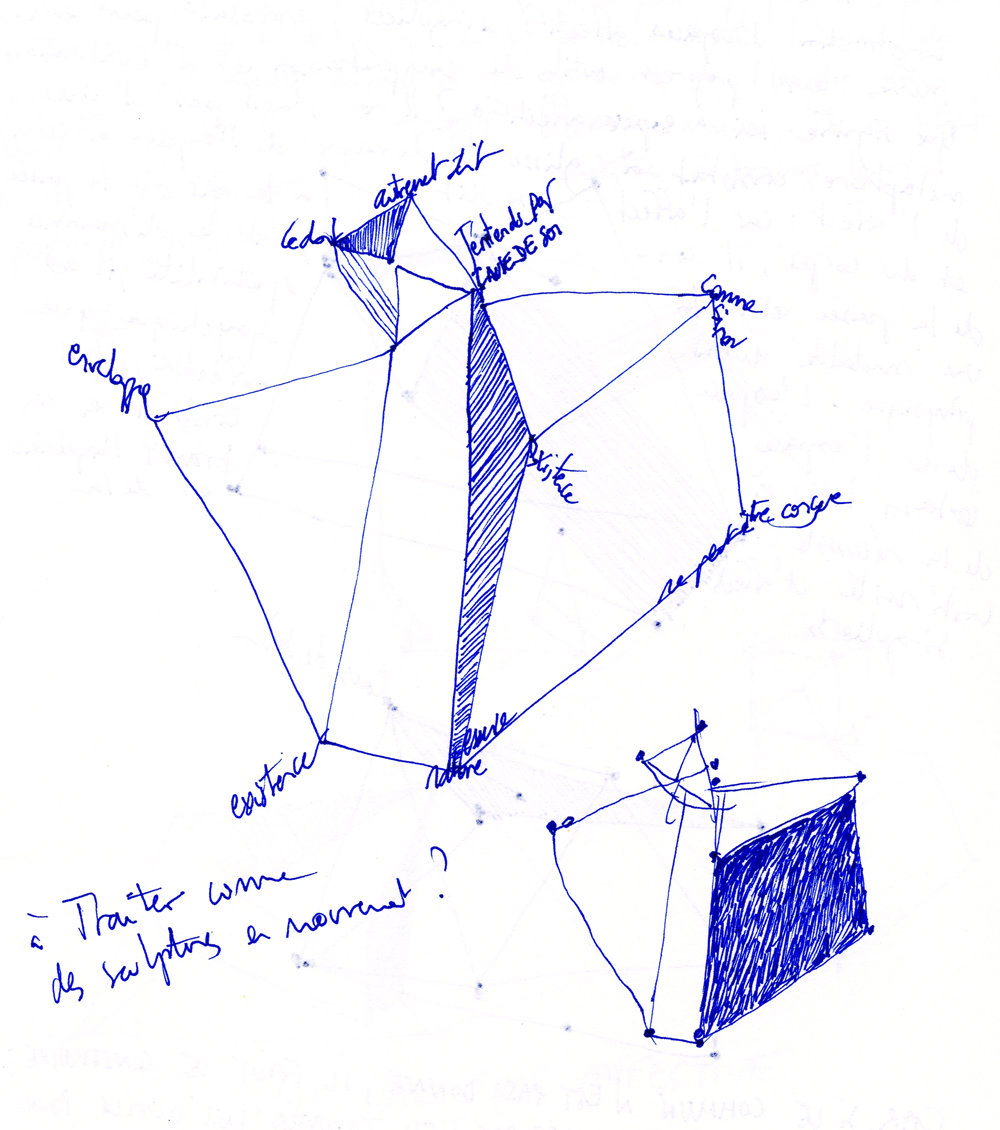
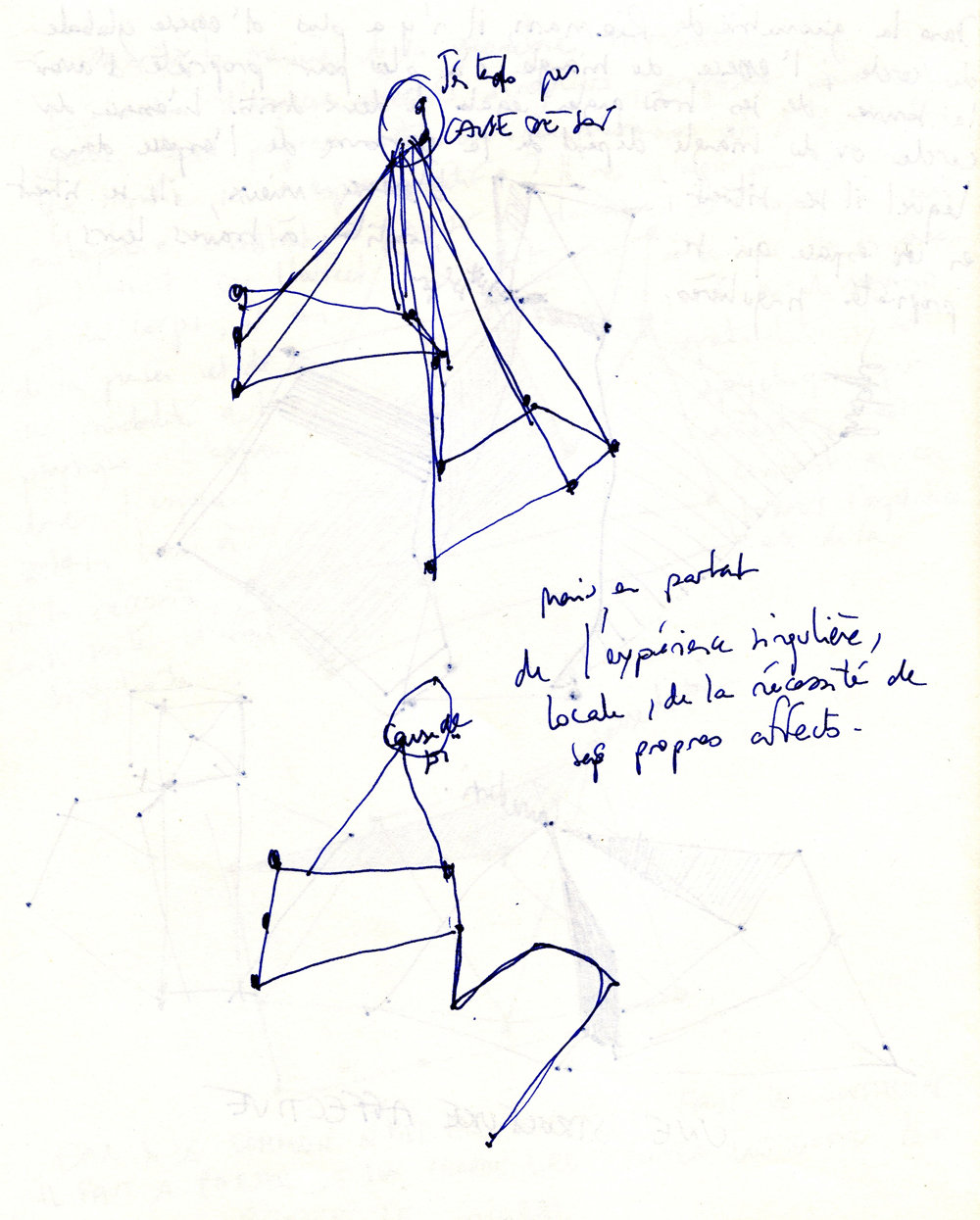
- 1. Each projection is drawn using the syntax of each text of the Ethics. Each point that forms the projection corresponds to a word or group of words in the text. This division by points makes visible the logical structure of the syntax. The points are connected by lines. Notes on the syntax accompany the projections.
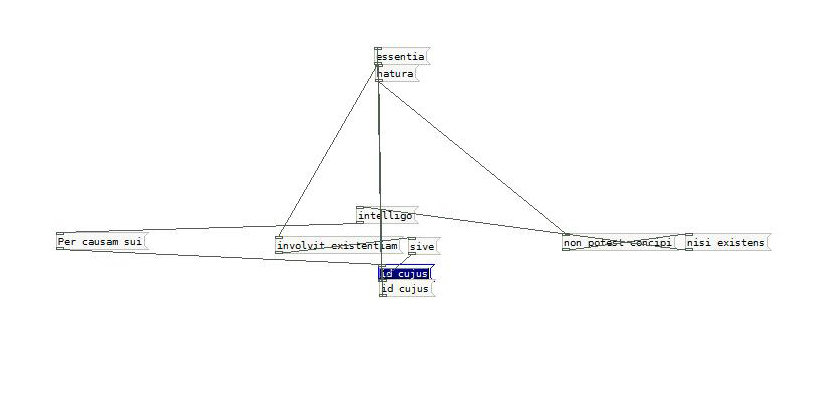
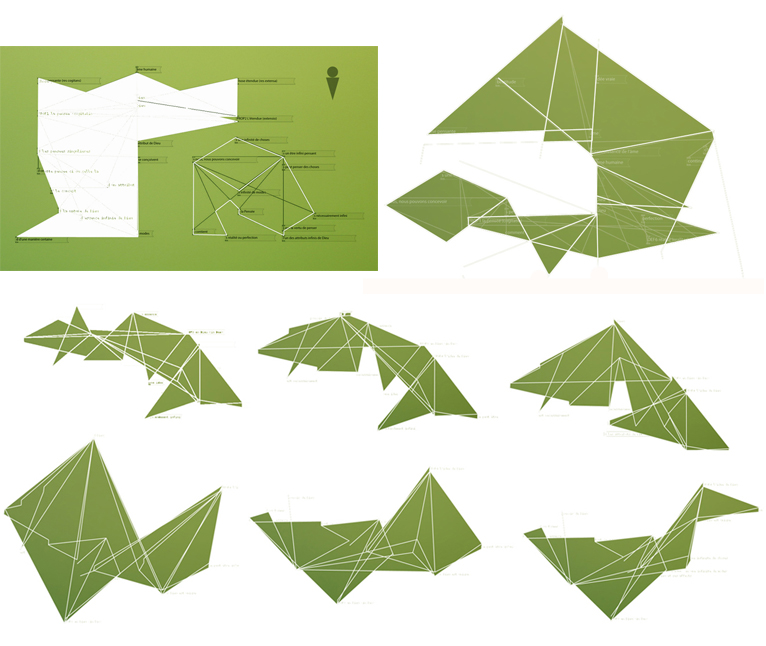
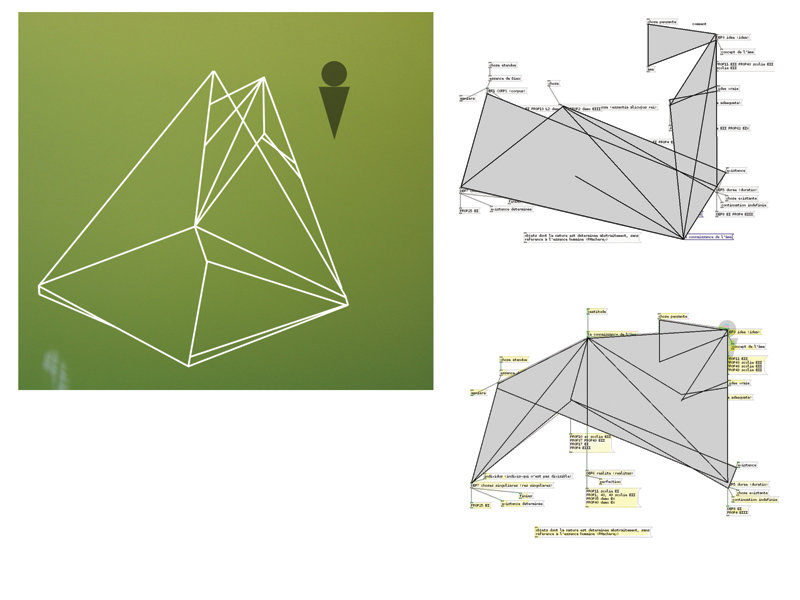
- 2. We can play to distort the projection, unfold it. Each projection can return to a linear line of text. Movements : from top to bottom, lateral, in the depth of the field ... Projections are a combination of movement and rest, speed and slowness. The movement of projections reflects the general cohesion of the text, the multiplicity of projections, the infinite way of reading. General instability of projections.
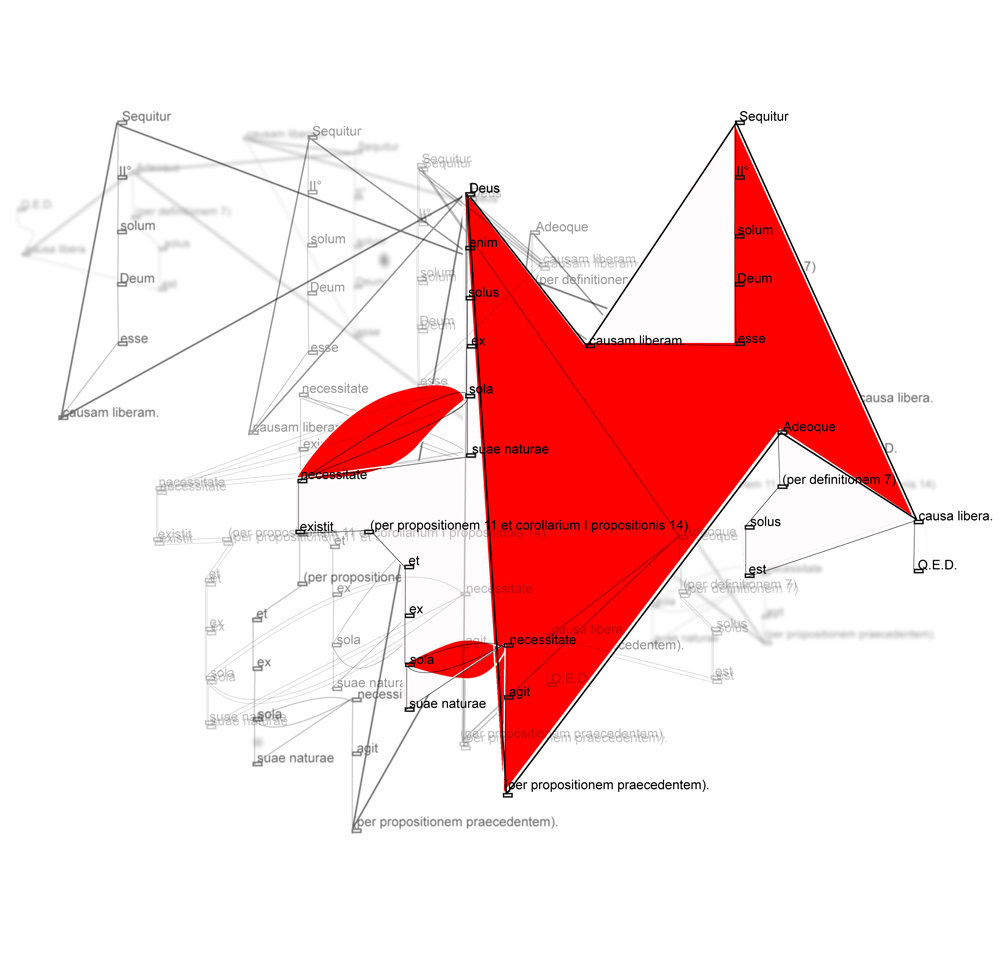
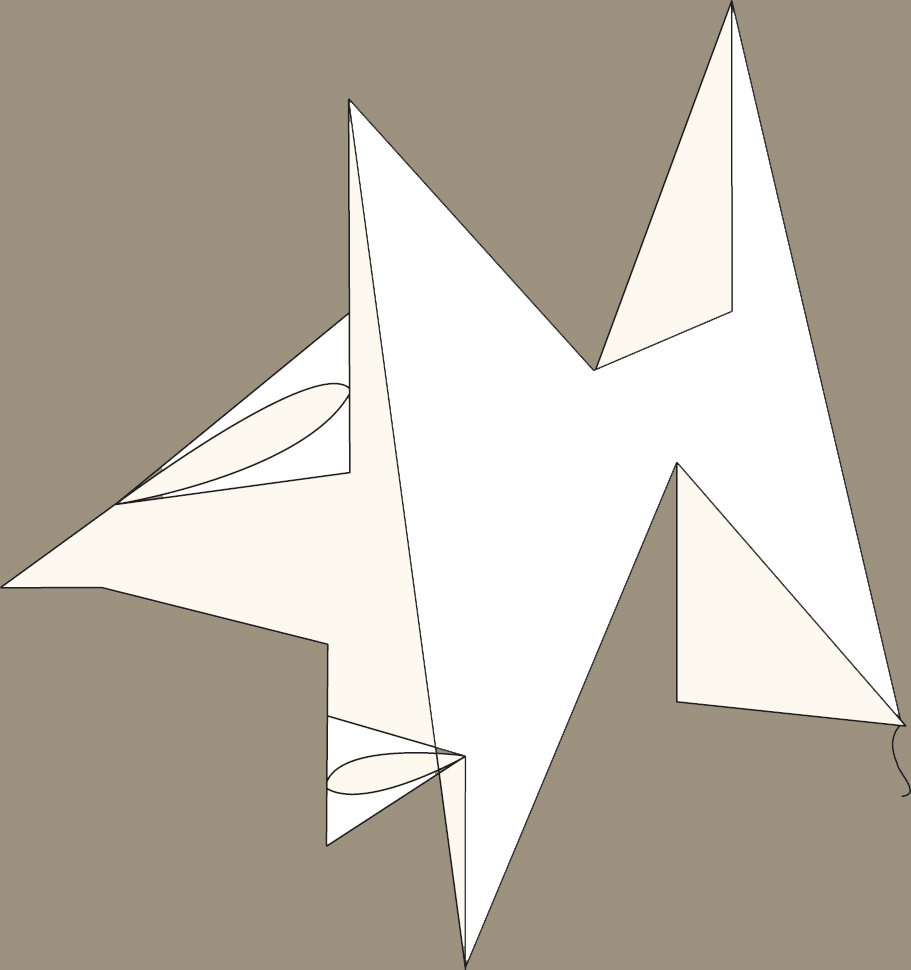
Proposition 17, corollary 2, part. I.
-
3. The lines draw the projections. The lines can be stiff or curved. They are the same lengths.
-
4. The projections produce a constant speed. It is the force of things that increases or decreases the speed of projection.
- 5. Speed and acceleration are important to evaluate. At each moment each projection returns to its starting constant after absorbing external variations.
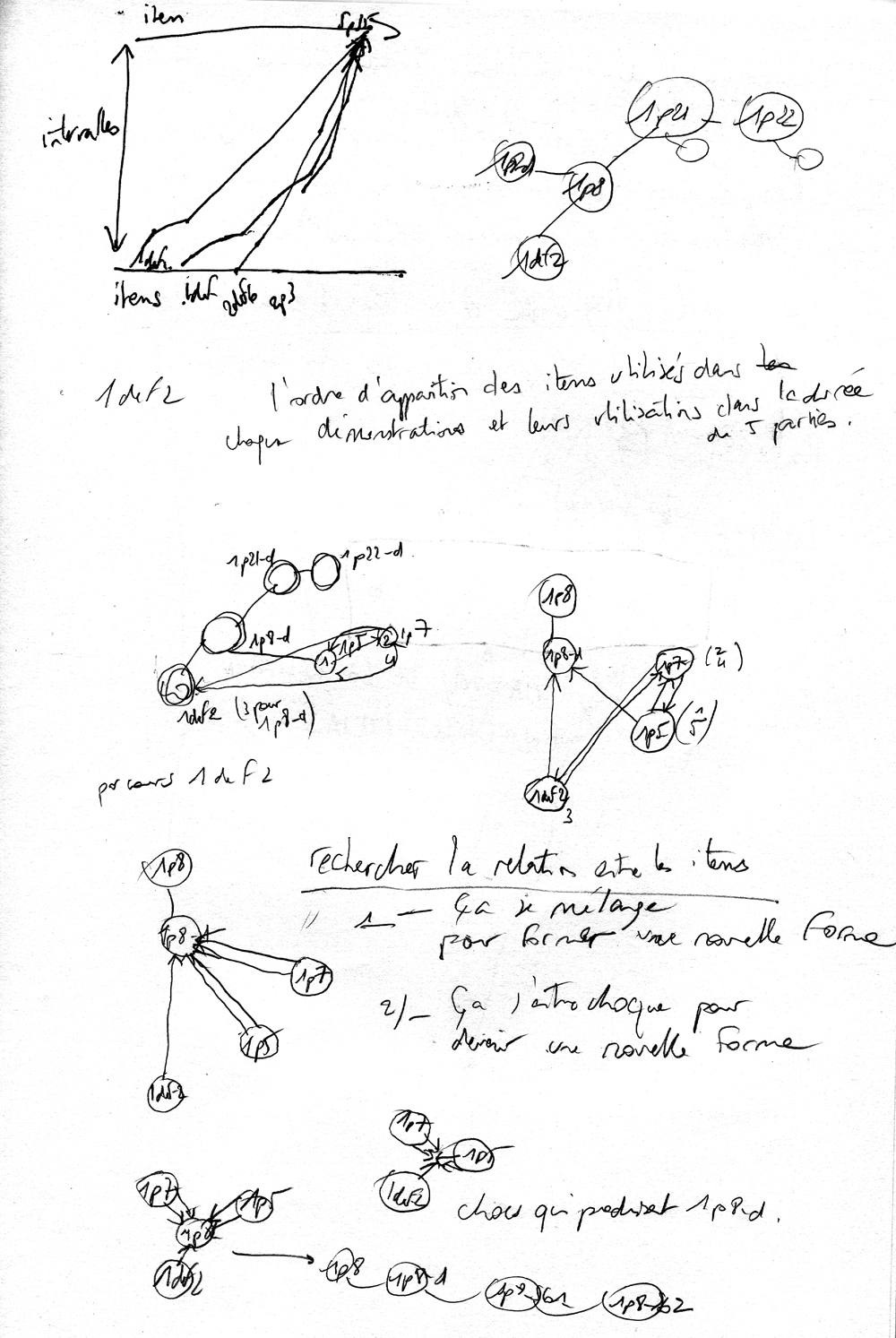
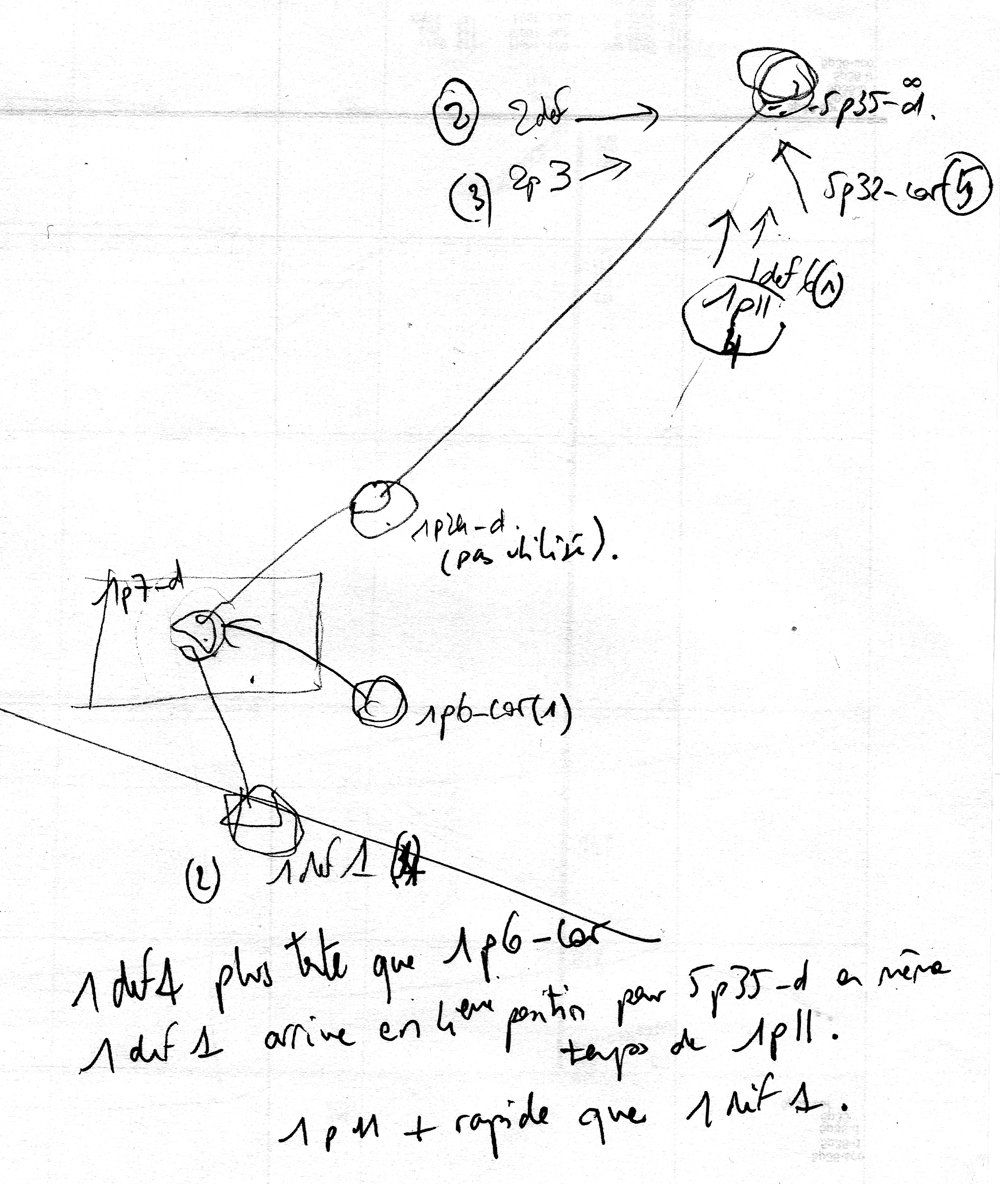
Trajectories
- 6. The projections have trajectories in space. The trajectories are based on the duration of a proposition in the Ethics. This duration corresponds to the number of connections of the text. At the end of its trajectory, the proposal disappears and reappears at its starting point. Define for each projection its coordinates all along its trajectory. The intersections of trajectories between projections occur continuously.
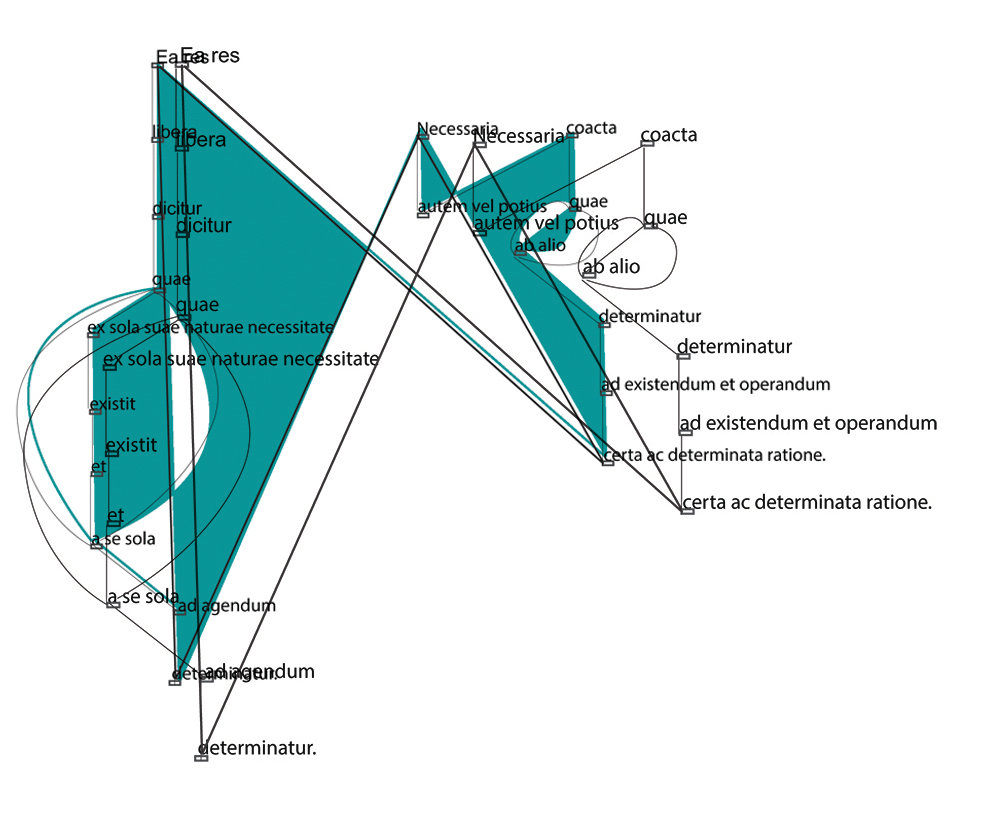
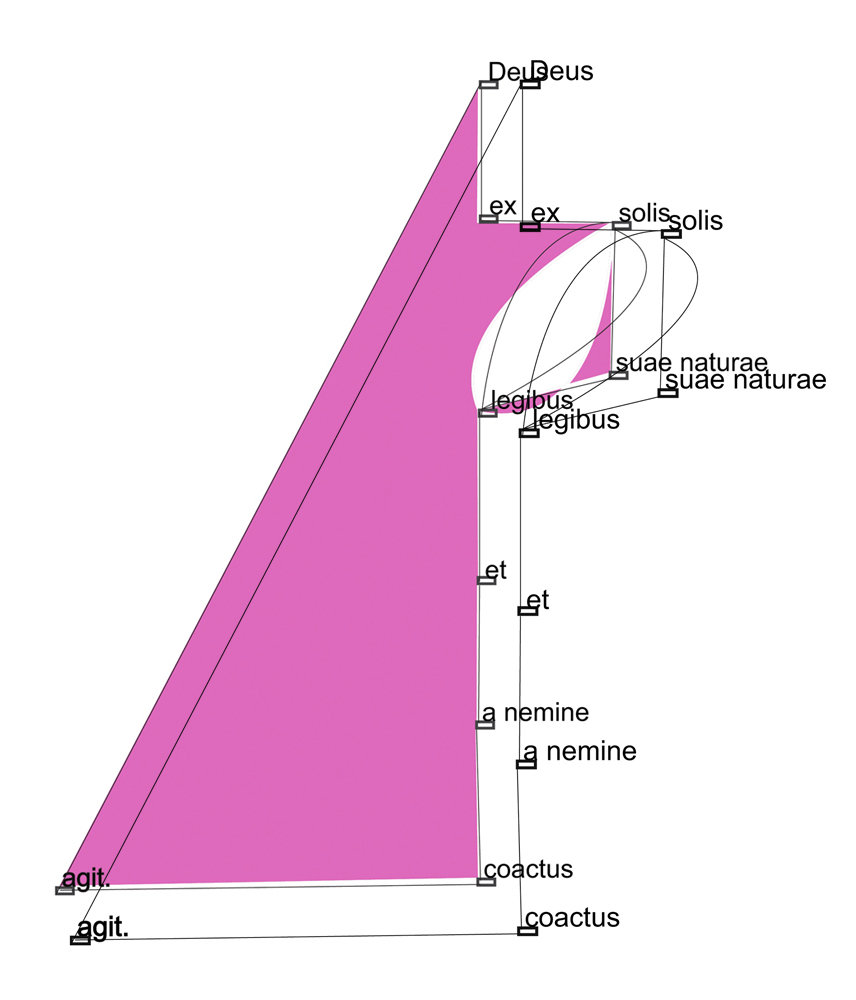
Part 1, Def. 7, prop. 17
-
-
The projections leave traces of their passages. Think of a possibility of evolution of projections. A degree of presence of a projection at different times in the Ethics. The traces are inscribed on other traces like the shocks between the projections. These shocks occur depending on the connections between propositions.
-
-
8. Archive of the first works on projections in French. ETHICA_FONTANA_PROJ2012.pdf
- 9. Distribution of the projections, according to the reasonings proposed by the text, in 5 families : Positive, Mixed, Negative, Absurd, Restrictive.
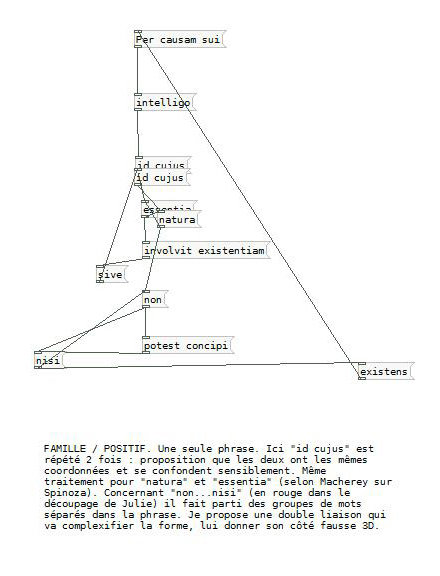
Part 1, Def. 1
Each family has identifiable peculiarities. To develop.
This distribution work was initiated by Julie Henry in 2014 from examples in latin.
Examples :
Part 1, Definitio 6
Per Deum / intelligo / ens absolute infinitum / hoc est / substantiam / constantem / infinitis attributis / quorum unumquodque / aeternam et infinitam essentiam / exprimit.
Note : Positive proposition. « ens » et « substantiam » sont sur le même plan : j’entends un étant / [j’entends] une substance. « quorum » introduit une subordonnée. Et peut-être faudrait-il faire un sort à la répétition d’ « infini ».
Part1, Definitio 7
Ea res / libera / dicitur / quae / ex sola suae naturae necessitate / existit / et / -a se sola- / ad agendum / determinatur. / Necessaria / autem vel potius / coacta / quae / -ab alio- / determinatur / ad existendum et operandum / certa ac determinata ratione.
Note : Positive proposition. « libera », « necessaria » et « coacta » sont sur le même plan : est dite libre / [est dite] nécessaire / ou plutôt [est dite] forcée. « quae » et « quae » introduise deux subordonnées parallèles. « -a se sola- » et « -ab alio- » introduisent un balancement : par elle-même / par autre chose [ce serait aussi intéressant de rendre graphiquement ces balancements].
Part 1, propositio 11
Deus / sive / substantia / constans / infinitis attributis / quorum unumquodque / aeternam et infinitam essentiam / exprimit, / necessario existit.
Note : Positive proposition. « deus » et « substantia » sont sur le même plan [il pourrait aussi y avoir une représentation spéciale pour tous les termes reliés par « seu » ou « sive »]. « quorum » introduit une subordonnée.
Part 1, propositio 14, corollarium 1
Hinc / clarissime sequitur / I° Deum / esse / unicum / hoc est / (per definitionem 6) / in rerum natura / non nisi / unam substantiam / dari / eamque / absolute infinitam / esse, / ut in scholio propositionis 10 / jam innuimus.
Note : Mixted proposition. « non nisi dari » constitue un groupe de sens. « hoc est » introduit une explicitation. Il pourrait y avoir un sort particulier pour toutes les affirmations mentionnant l’évidence de ce qu’elles affirment en regard de ce qui précède, en les reliant d’une certaine façon à ce qui précède.
Part 1, propositio 17, corollarium 1
Hinc sequitur / I° nullam dari / causam / quae / Deum / extrinsece vel intrinsece / praeter ipsius naturae perfectionem / incitet ad agendum.
Note : Negative proposition. (mais qui affirme paradoxalement quelque chose). La construction est complexe : « quae » introduit une subordonnée dont « causam » est le sujet, « incitet » le verbe et « Deum » le COD. « vel » introduit un balancement entre « extrinsece » et « intrisece ».
Part 1, propositio 20, corollarium 2
Sequitur / II° Deum / sive / omnia Dei attributa / esse immutabilia. / Nam / si / ratione existentiae mutarentur,/ deberent / etiam / (per propositionem praecedentem) / ratione essentiae mutari / hoc est / (ut per se notum) /ex veris falsa fieri, / quod est absurdum.
Note : Absurd proposition.
Part 4, propositio 7, corollarium
Affectus / quatenus / ad mentem refertur / nec coerceri / nec tolli / potest / nisi per ideam corporis affectionis / contrariae et fortioris / affectione qua patimur. / Nam / affectus / quo patimur / nec coerceri / nec tolli / potest / nisi per affectum eodem fortiorem eique contrarium / (per propositionem praecedentem) / hoc est / (per generalem affectuum definitionem) / nisi per ideam corporis affectionis fortioris et contrariae / affectioni qua patimur.
Note : Restrictive proposition.
The palette of Emotions
A color is attributed to the digital projections of the Emotions of Part III of the Ethics, from the three primary colors (in painting) red, blue, yellow. These three colors are assigned to the first three affects in the Ethics:
- Joy : yellow
- Sadness : blue
- Desire : red.
The other colors of the other affects derive from the three primary colors according to the palette.

Rigorous counterpoint
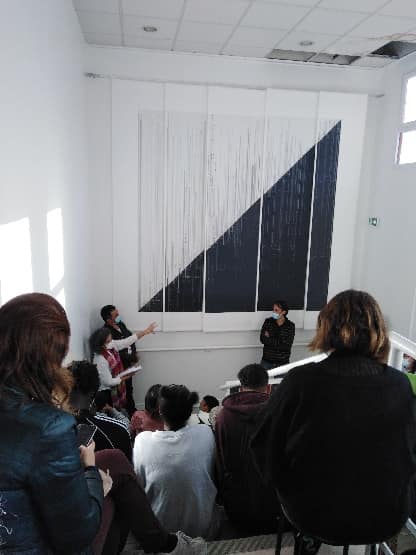
_Rigorous counterpoint edition of 5 posters (3mx3m) 2021
This project to be developed, is the logical continuation of Patrick Fontana's research on the connections between the texts of the Ethics. It consists of a moving digital graph, the Rigorous counterpoint (RCP), and an engraved catalog of the graphic identities of each text of the Ethics that the graph can compose.
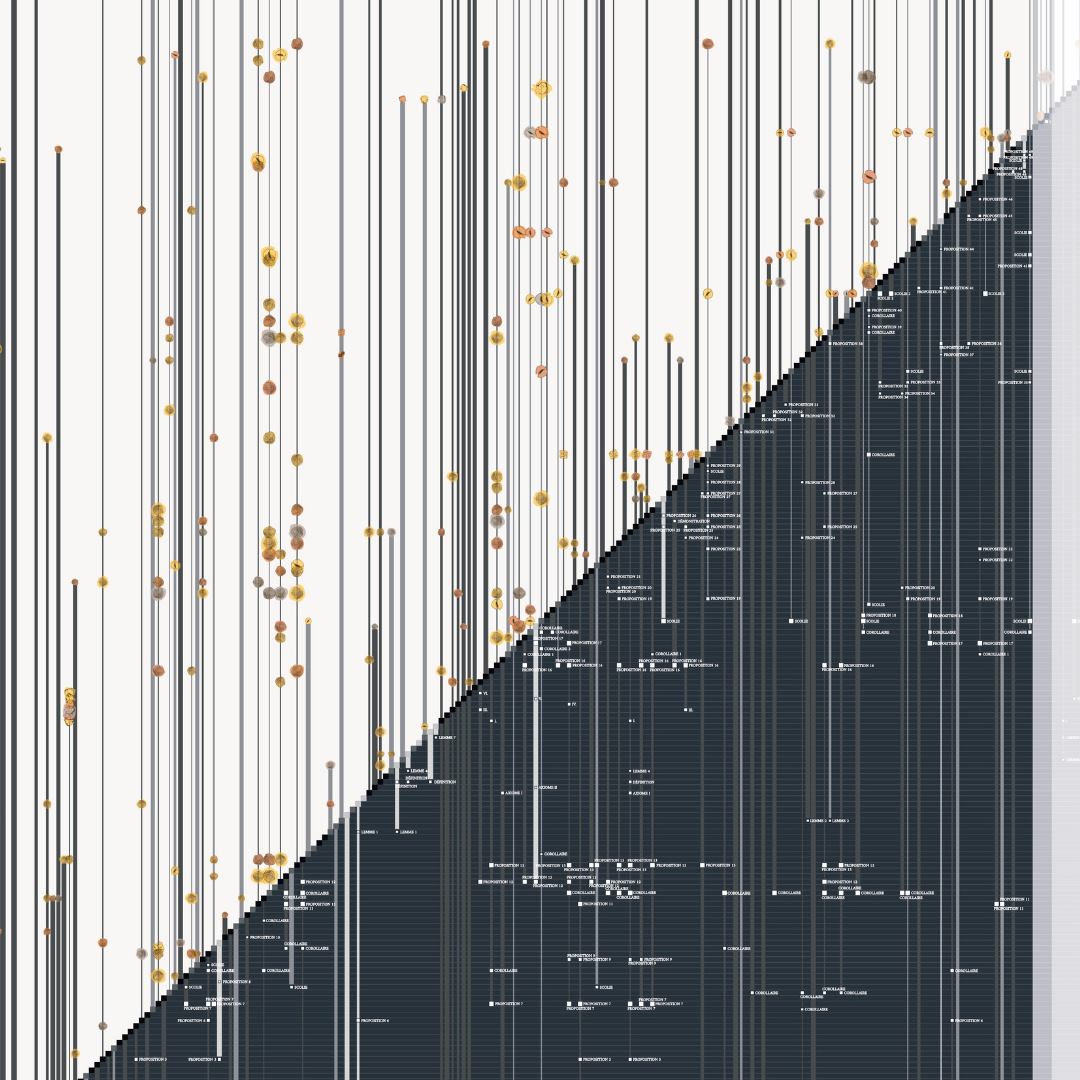 Rigorous counterpoint development by Pierre-Yves Fave, Patrick Fontana with Nodebox, 2021
Rigorous counterpoint development by Pierre-Yves Fave, Patrick Fontana with Nodebox, 2021
Two phases of work
The digital development of the graph. It will be added to the application or presented in installation.
932 engravings of the 932 texts of the Ethics : the catalog of graphic identities of the texts, in collaboration with Florence Hinnneburg, engraver with whom Patrick Fontana has been working for many years.
Partitions (musical) and trajectories
The Rigorous counterpoint imagine (musical) scores of Ethics from the connections between the texts.
In the Ethics texts are demonstrated by others in a specific order. Rigorous conter-point (RCP) assigns each text a trajectory and duration to traverse it all along the 5 parts of the Ethics. This path corresponds to the number of connections of each text in the Ethics.
RCP composes scores from the trajectories of all texts in connections. Through a set of speeds between the trajectories of each text, RCP imagines the logical progress of the connections in motion.
The Rigorous conter-point gives an "image / duration" of each text.
Exemple
The horizontal and vertical lines of the RCP are graduated from 1 to 932, which corresponds to the 932 texts that compose Ethics.
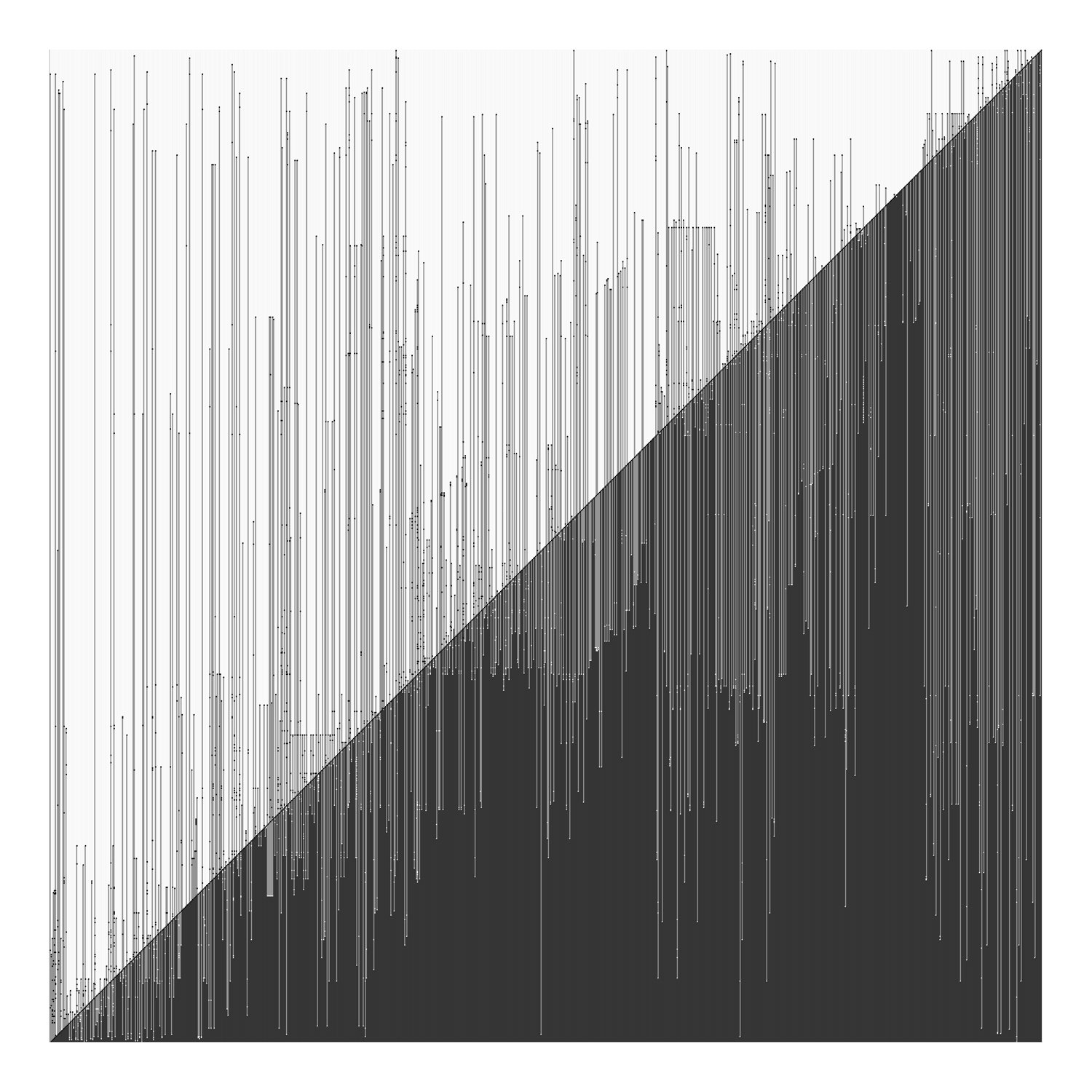
image : Fontana and Pierre-Yves Fave, 2015
For example Part 1, Definition 1 is used by :
- Part 1, proposition 7, demonstration
- Part1, proposition 24, demonstration
- Part V, proposition 35, démonstration.
Its trajectory is long since it begins at the beginning of the first part and ends almost at the end of the fifth part of the Ethics.
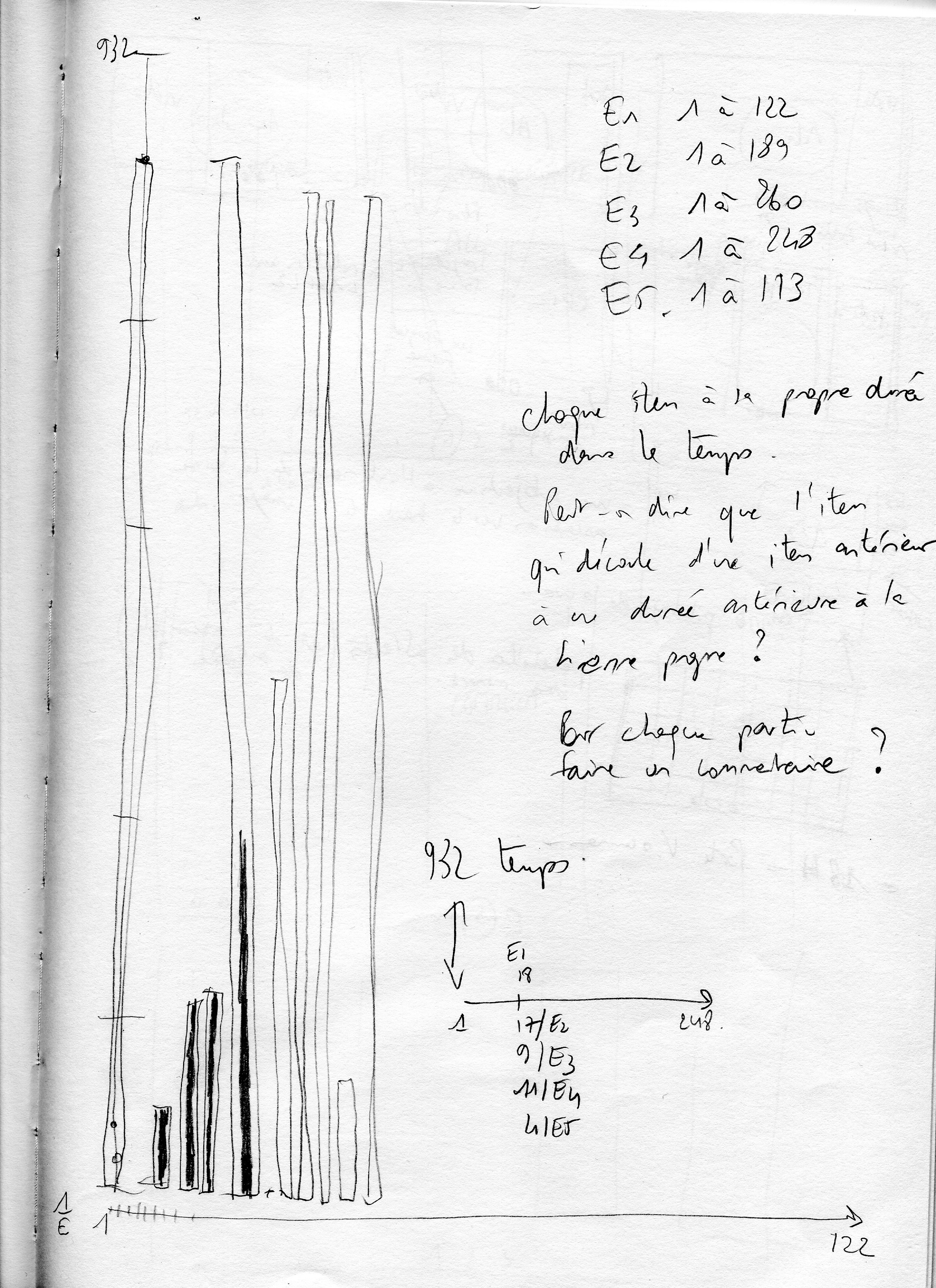
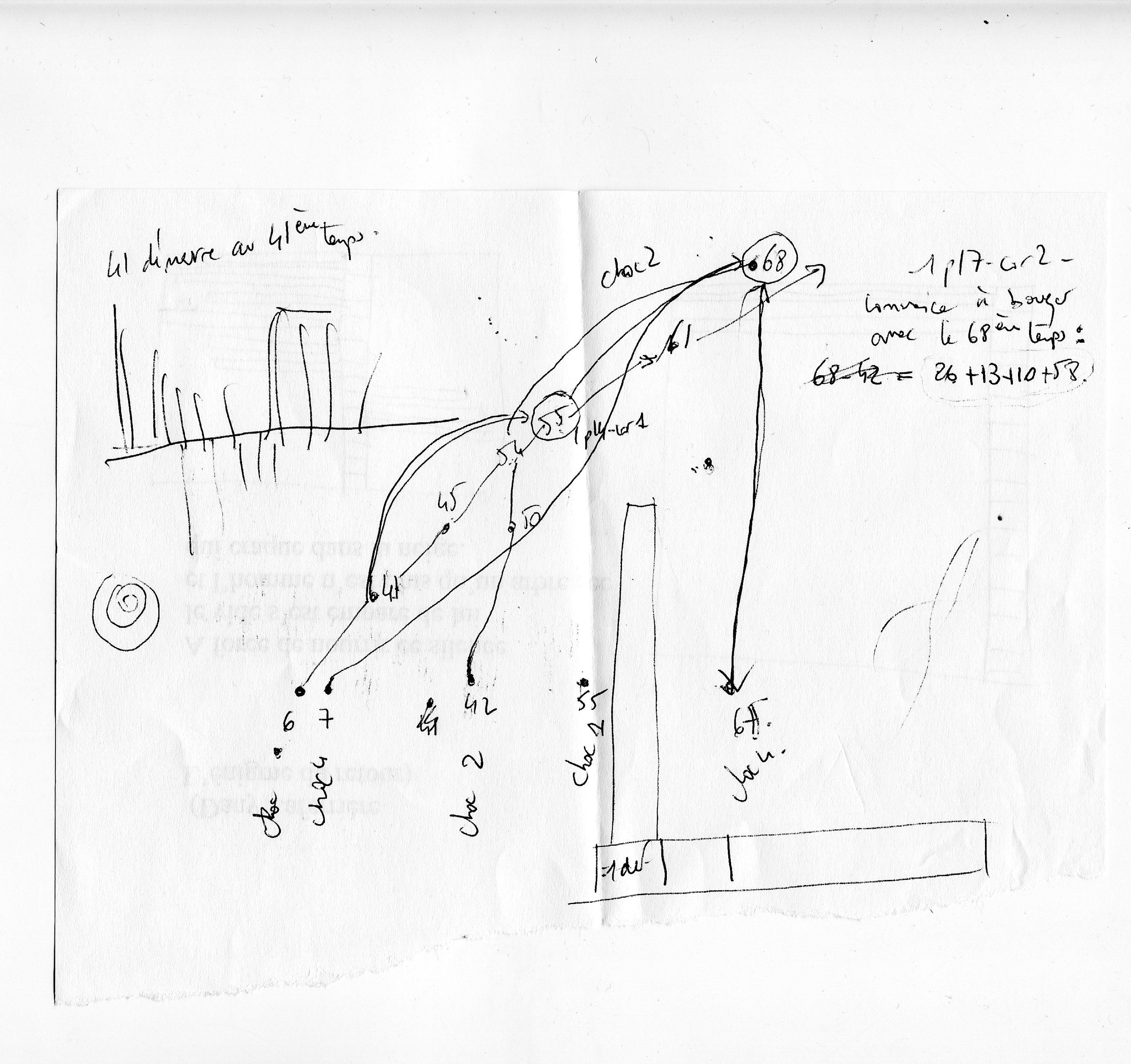
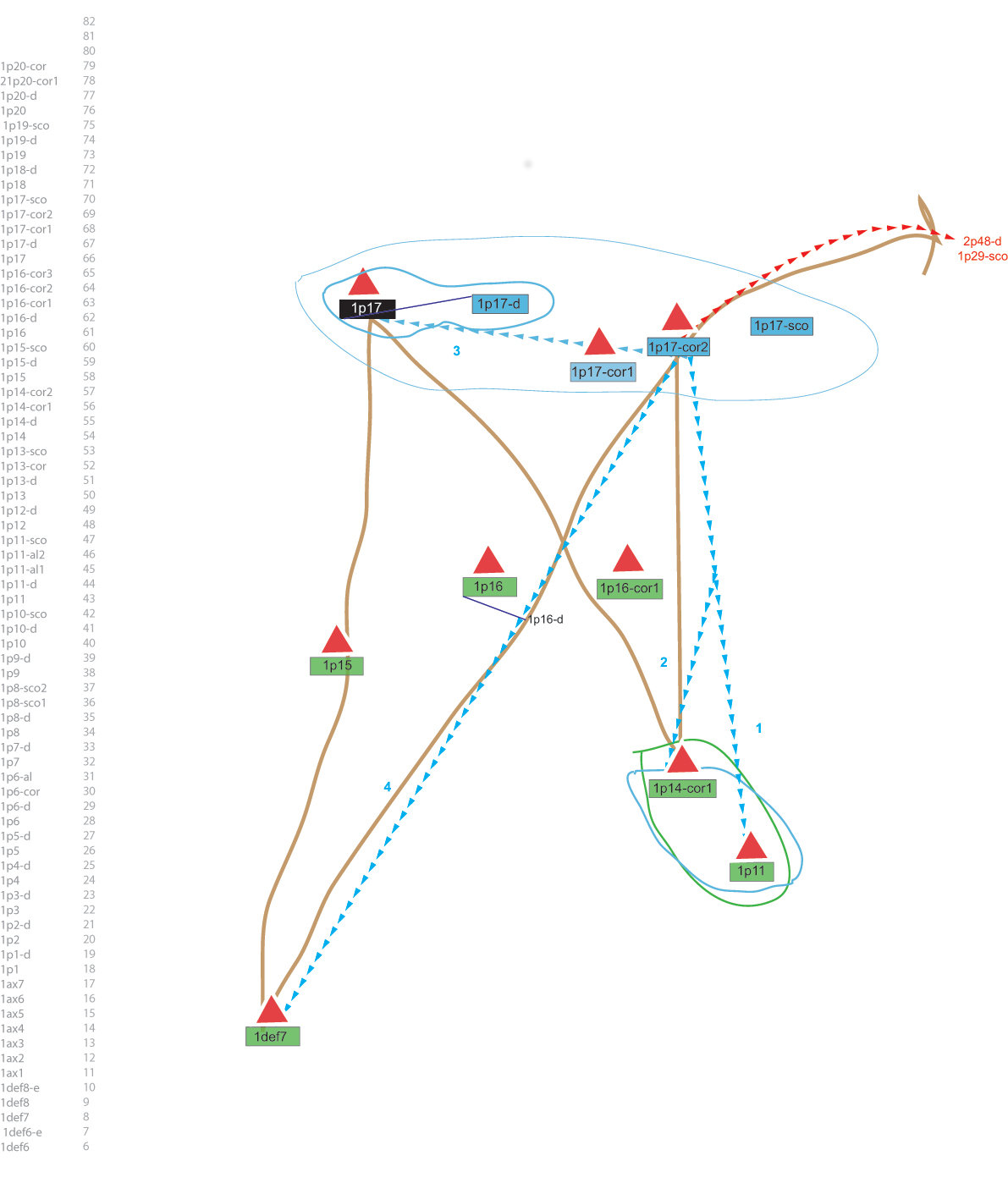

- In videos, the proposition 17, corollary 2, Part I is demonstrated in the order of the demonstration by :
- Part 1, proposition 11
- Part 1, proposition 17
- Part 1, definition 7
and is subsequently used by :
- Part 1, proposition 29, demonstration
- Part 2, proposition 48, demonstration
The propositions connected to each other develop their trajectories at different rates.
videos : Pierre-Yves Fave, 2015
Catalog of Graphic identities of the propositions
The RCP gives an "image / duration" of each text. This "image / duration" becomes the graphic identity of the catalog.
It consists of 932 engravings of the graphic identities of the Ethique texts.
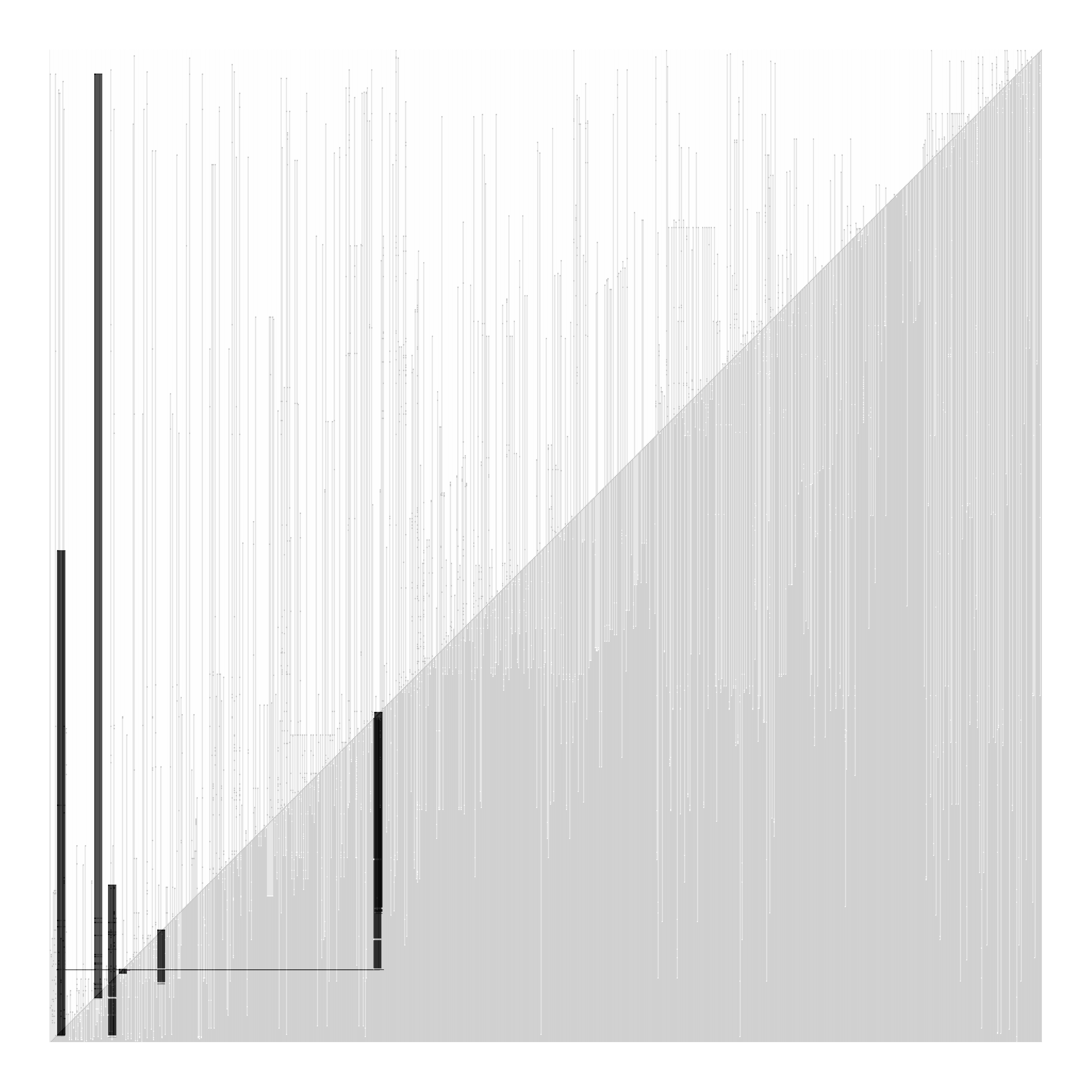
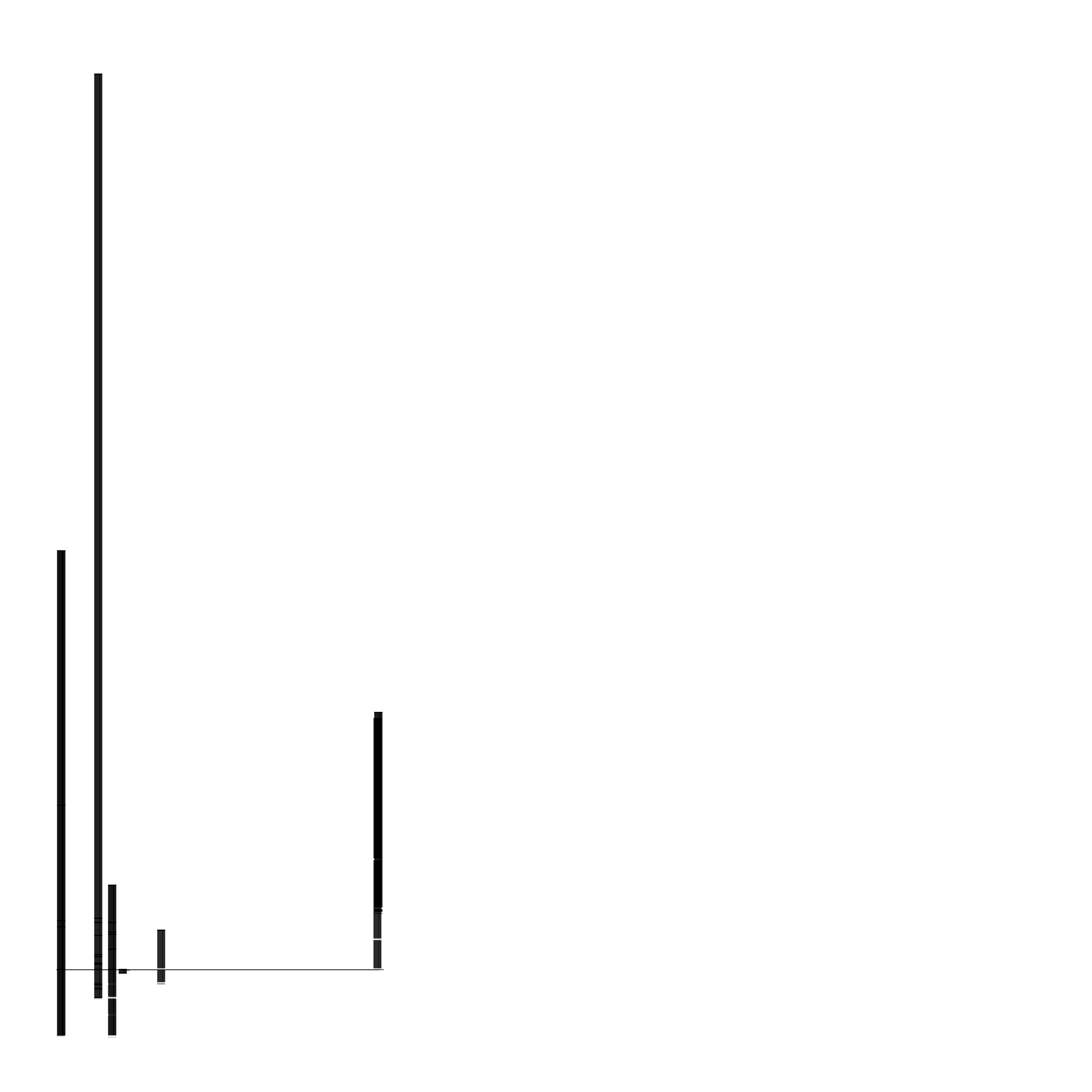
We need your help to finance this project, if you are interested, please contact Patrick Fontana.
Technical research
The application
The database
We are developing a JSON database model adapted to Spinoza's Ethics, allowing us to dynamically load content into the interface and also to share these contents in a standardized way. This bdd model is constantly evolving in relation to the development of the project.
We also developed a routine python we allow to recover the different versions of the Ethics available in free right on internet as well as a new translation in Brazilian and to format them for our model of bdd json.
Design
Multiple tests and versions of design and graph for the reading interface have all been done under Linux and with free software, mainly Inkscape. We will also share the sources of all these design documents.
The development of the interface
The interface is developed in pure javascript (vanilla). There is no back-office, or server-side code, which makes the application autonomous, to make it available in different contexts : website, desktop application, mobile application. We use the mithril.js interface framework to gain weight and speed of development. This framework is at the same time very light, flexible in these models of use, and very fast.
We have not added any additional js plugin, such as jquery for example, in order to gain execution velocity and because current javascript environments are powerful enough and standardized enough to be used as is. Webpack serves as a development environment, which allows to design the source application of different modules arranged between them. This has the effect of better organizing the code and allow a more fluid collaborative work.
Sources
All sources of design and codes of the application will be shared under free license Gnu GPLv2 via a deposit lies. If you are interested to use parts of this work please make your request to Patrick Fontana.
Website
Graphic Choice
Spinoza has been a lens polisher. This profession seemed to us to be an interesting starting point to exploit and put in relation with the site. Lenses are used in many scientific fields (astrology, biology, etc ...). They make it possible to isolate an element in a set, to understand its composition and its functioning. Ethica works on this principle. The study of the structure of Ethics involves the isolation of a text or group of text. Ethica website takes this principle, all the contents are accessible but not all legible. Only the first column will be readable. The rest will be blurred. The typography used is Amiri, it is open source. She is part of the family of Elzevirs. Its particularity is to have a triangular wheelbase. It allows a certain lightness in the page and a great readability. Created by the Elzevier family during the 17th century. The Amiri reconstructs are time keeping a modernity in his design.
Interactivity
To make content visible the user must click on a link in the menu on the left. The corresponding column moves to the left of the screen (like a carousel) and gradually, the content becomes more and more clear. The images presented in the site, can be enlarged by clicking on them. Some images are complex and deserve to be observed as much as possible. These images can also be downloaded directly through the site.
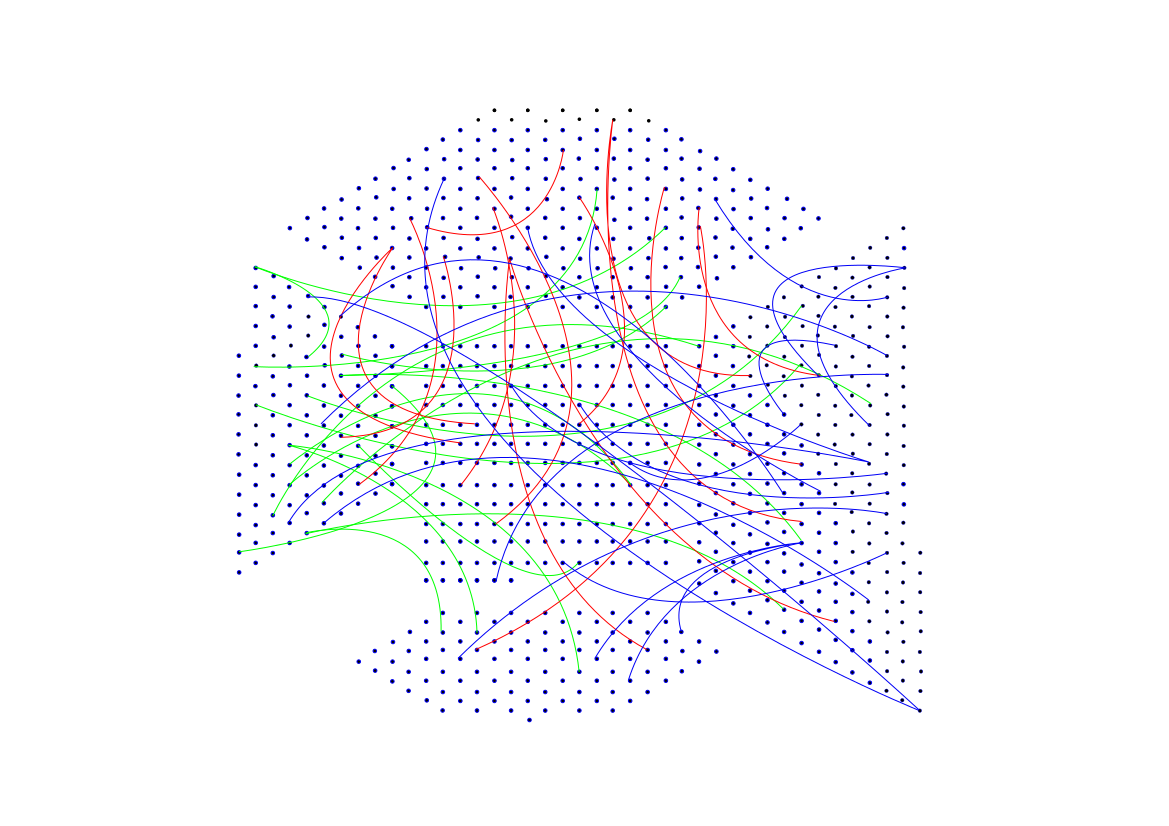
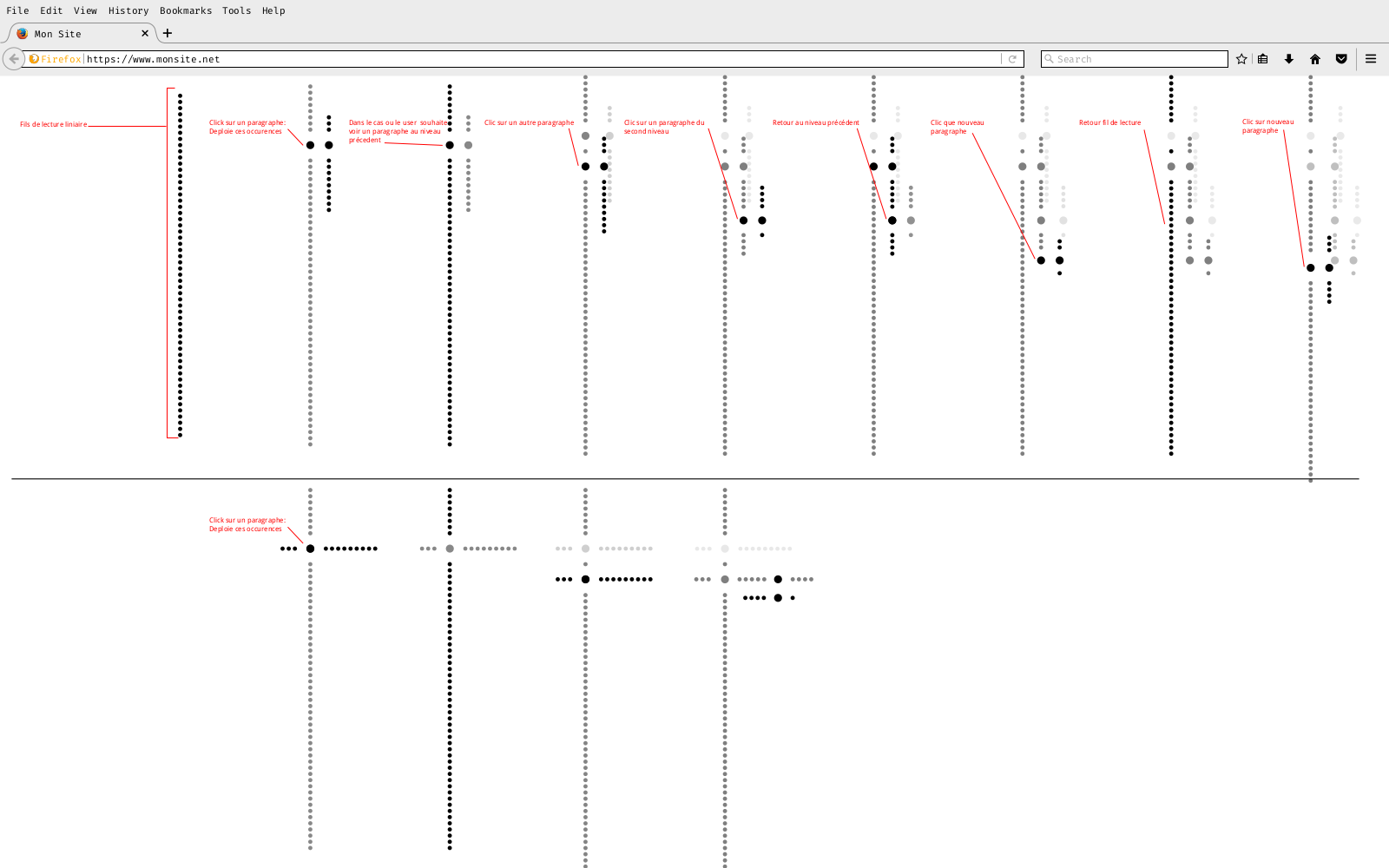

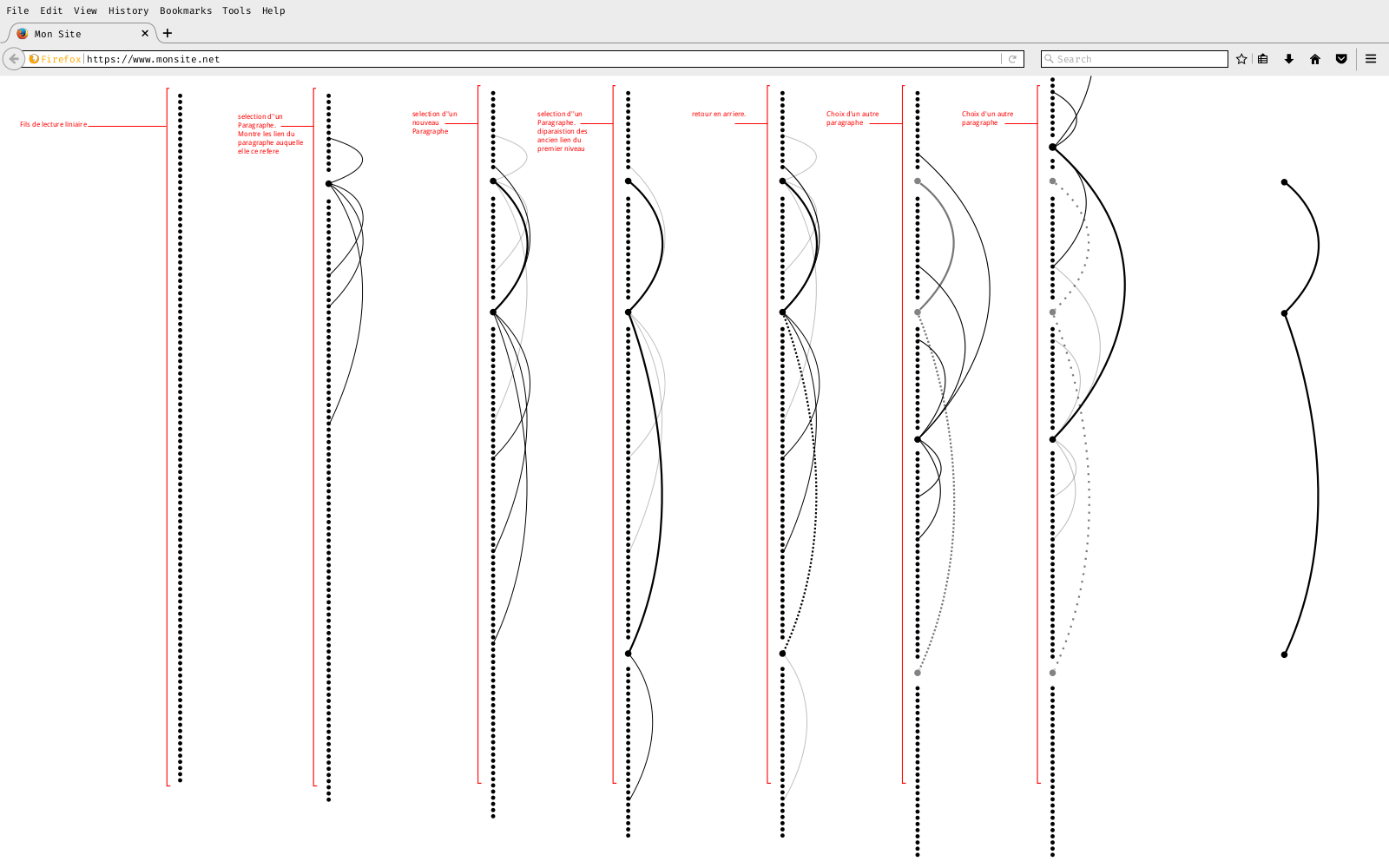
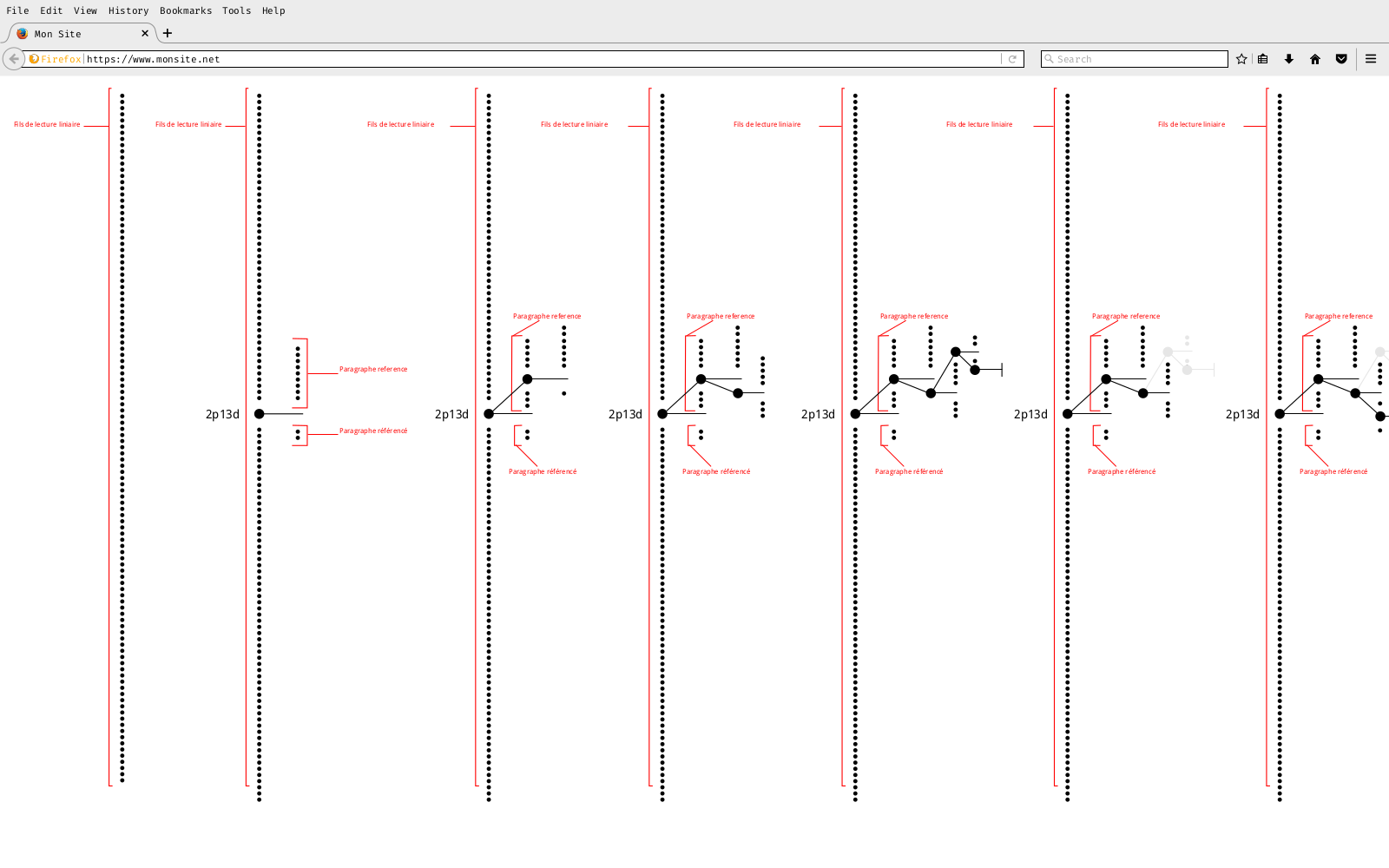
CMS content management system and development
We use CMS Grav (https://getgrav.org) for Ethica website. This CMS will allow Patrick Fontana to manage and integrate his content easily. Simply by file and folder management. It does not require a database. Grav is open-source. The language used is the Html generated by the CMS, and the css for the formatting, the javascript Jquery library, for the animation of the displacements of the columns.
Figures Libres
Figures Libres is a collective born from the meeting of two citizen approaches that animate each of its members : Carry messages of sponsors of public, social and cultural utility; to work on free software to create without consuming, to release information, to interact and to enrich oneself together.
The team
Author, director : Patrick Fontana Production : Patrick Fontana, Tygryz Compagny (Emmanuel Ryz) Designers : Bachir Soussi Chiadmi, Kevin Tessier Director of photography : Thomas Lallier
Ethica, work without obstacle, is funded by Conseil régional des Hauts de France, a thematic and structuring project 2015-2018, research unit Centre de Recherche en Arts et Esthétique (CRAE, EA4291), University of Picardy Jules Verne, France. Scientific partner : Modelling, Information and Systems laboratory (MIS, EA 4290, UPJV). Interns : Sophie Monnier, Miguel Clemente, Freya Van den Bossche, Théo Hordequin.
Patrick Fontana received in 2013, the grant Brouillon d’un Rêve Pierre Schaeffer from Société Civile des Auteurs Multimédia (French multimedia publishing rights society) (SCAM), and the grant aide à l’écriture et au développement aux nouveaux médias from Centre National du Cinéma et de l’image animée, France, (CNC), after the unanimous decision of the jury.
Patrick Fontana and TYGRYZ Compagny, received in 2016, the grant aide à la production DICREAM from Centre National du Cinéma et de l’image animée, France, (CNC).
Ethica has been hosted and supported (2015-2016) by the Fondation Maison des Sciences de l'homme, Paris, scientific director, Jean-Pierre Dozon.
The Social and Political Thought Research Group, Brunel University of London participated in the financing of Ethica’s teaser in 2015.
Institutional support
-
- L’Institut d’Histoire de la Pensée Classique, de l’Humanisme aux Lumières, (UMR 5037, ENS de Lyon)
-
- L’École Doctorale de Philosophie de l’Université Paris I Panthéon-Sorbonne
-
- L’École Doctorale du Programme de Post-Graduation et Recherche en Philosophie de L’Université Fédérale de Rio de Janeiro
-
- Laboratoire de Recherche sur l’Histoire et la Pensée Modernes, Université du Québec, Trois-Rivières
Presentation of Ethica at international conferences and universities
-
- International conference Spinoza andarts, organized by the CRAE and CERPHI, Paris, 2014
-
- University of Milano, University of Bergamo, Department of Philosophy, 2015
-
- University UNRIO, Rio de Janeiro, Faculty of Philosophy, 2015
-
- XII International conference Spinoza and Américas, 2015
-
- International Symposium for Phenomenology, Perugia, Italia Playing with Spinoza's Ethics : the powers of Digital Humanities in the service of an international Spinozism, 2016
On internet:
-
Ethica, Work Without Obstacle : An Interview with Patrick Fontana, artist July 11, 2019 by Nathan Eckstrand on the blog the The American Philosophical Association ( APA)
-
Anthony Masure, teacher-researcher in design talks about Ethica during his conference, « Repenser les interfaces du savoir », conference at Rencontres crossmédias IDEFI CréaTIC, dir. Ghislaine Azémard & Arnaud Laborderie, MSH Paris Nord, january 2019.
-
Presentation of Ethica, the Digital Library and Collective Intelligence workshop : Is the digital revolution the coronation of the "humanities ? June 3th, 2019 at the University of Nanterre.
-
Ethica is listed in the Campus Katalog Bibliothekssystem of Hamburg University
- Ethica has a page of presentation on eadh.org The European Association for Digital Humanities (EADH)
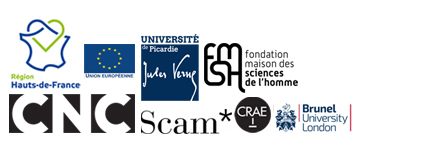
Actualités
Actualite 2
Principium autem unde latius se funditabat, emersit ex negotio tali. Chilo ex vicario et coniux eius Maxima nomine, questi apud Olybrium ea tempestate urbi praefectum, vitamque suam venenis petitam adseverantes inpetrarunt ut hi, quos suspectati sunt, ilico rapti conpingerentur in vincula, organarius Sericus et Asbolius palaestrita et aruspex Campensis.
Post haec indumentum regale quaerebatur et ministris fucandae purpurae tortis confessisque pectoralem tuniculam sine manicis textam, Maras nomine quidam inductus est ut appellant Christiani diaconus, cuius prolatae litterae scriptae Graeco sermone ad Tyrii textrini praepositum celerari speciem perurgebant quam autem non indicabant denique etiam idem ad usque discrimen vitae vexatus nihil fateri conpulsus est.
Accedebant enim eius asperitati, ubi inminuta vel laesa amplitudo imperii dicebatur, et iracundae suspicionum quantitati proximorum cruentae blanditiae exaggerantium incidentia et dolere inpendio simulantium, si principis periclitetur vita, a cuius salute velut filo pendere statum orbis terrarum fictis vocibus exclamabant.
Coactique aliquotiens nostri pedites ad eos persequendos scandere clivos sublimes etiam si lapsantibus plantis fruticeta prensando vel dumos ad vertices venerint summos, inter arta tamen et invia nullas acies explicare permissi nec firmare nisu valido gressus: hoste discursatore rupium abscisa volvente, ruinis ponderum inmanium consternuntur, aut ex necessitate ultima fortiter dimicante, superati periculose per prona discedunt.
Hoc inmaturo interitu ipse quoque sui pertaesus excessit e vita aetatis nono anno atque vicensimo cum quadriennio imperasset. natus apud Tuscos in Massa Veternensi, patre Constantio Constantini fratre imperatoris, matreque Galla sorore Rufini et Cerealis, quos trabeae consulares nobilitarunt et praefecturae.
cqdcds
 app.ethica-spinoza.net
app.ethica-spinoza.net